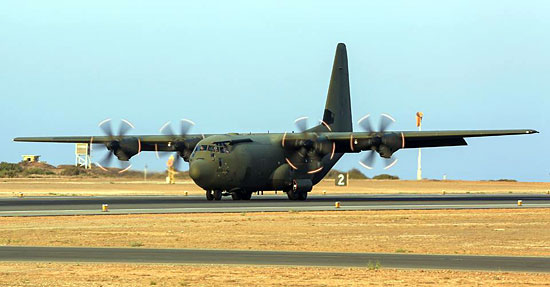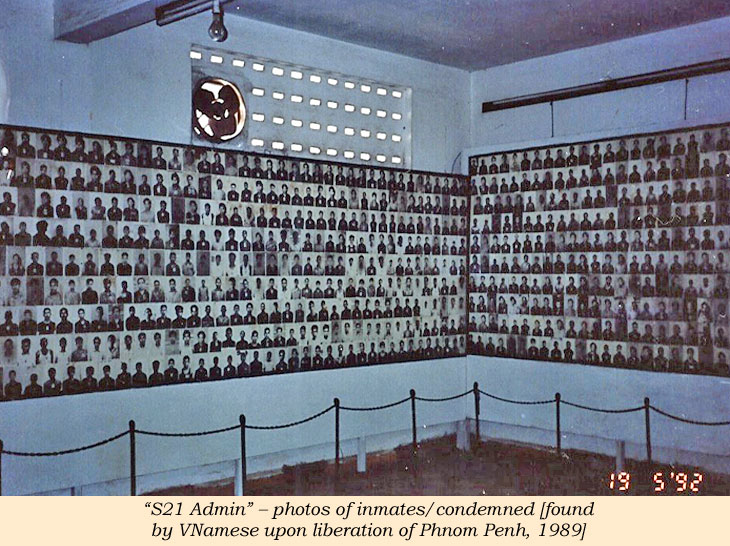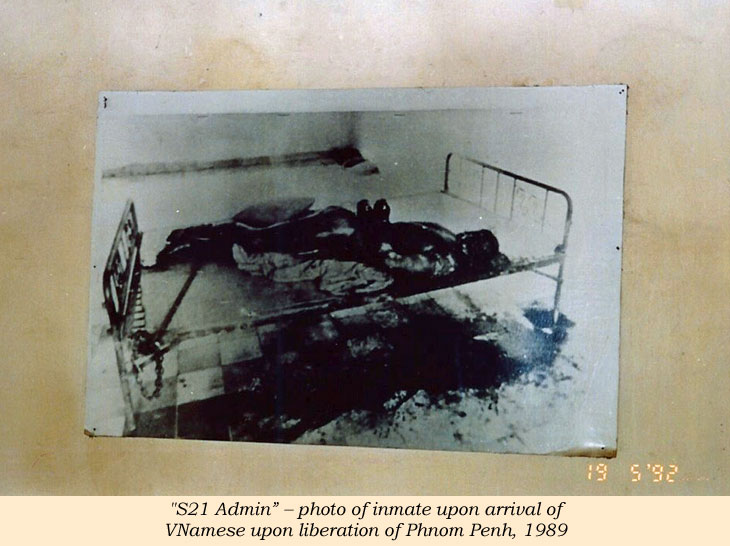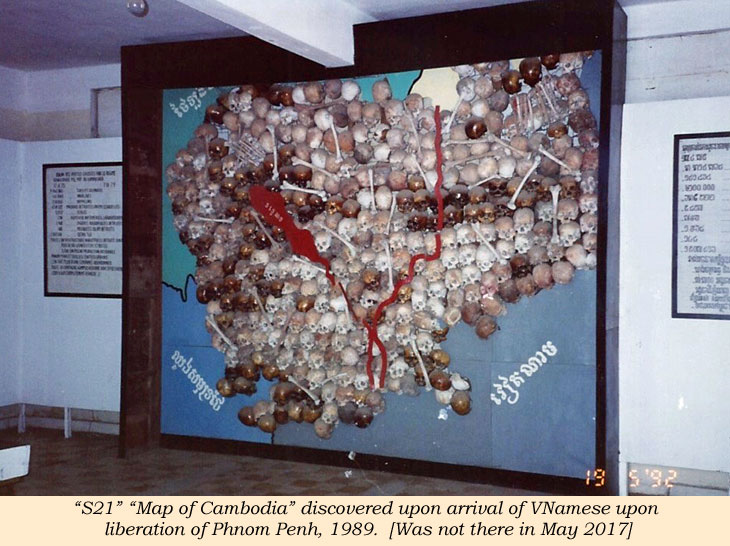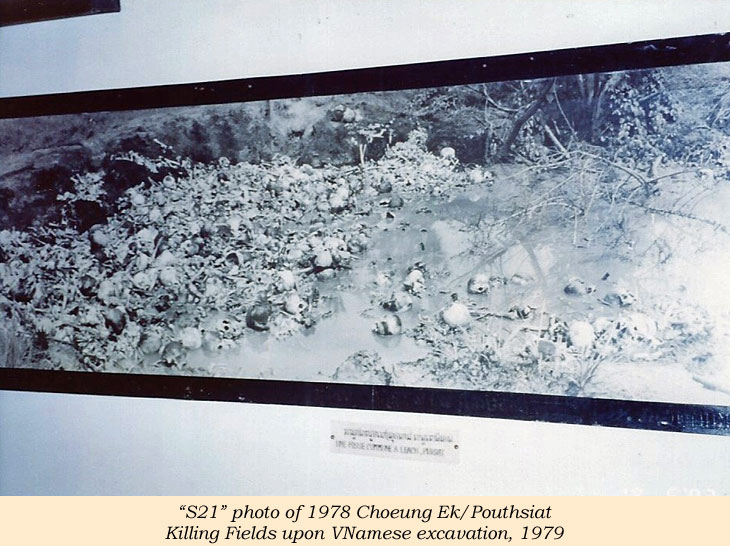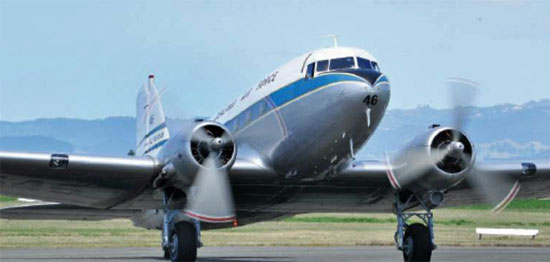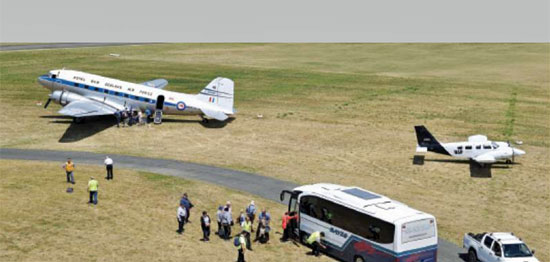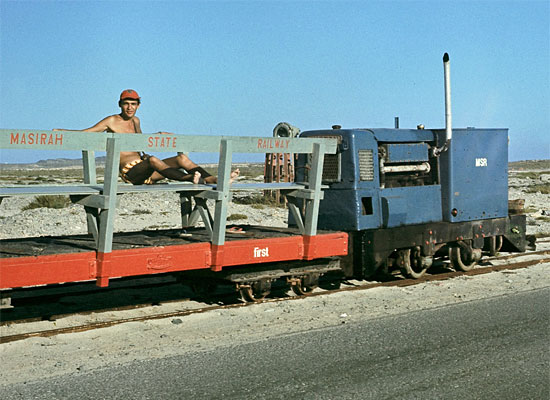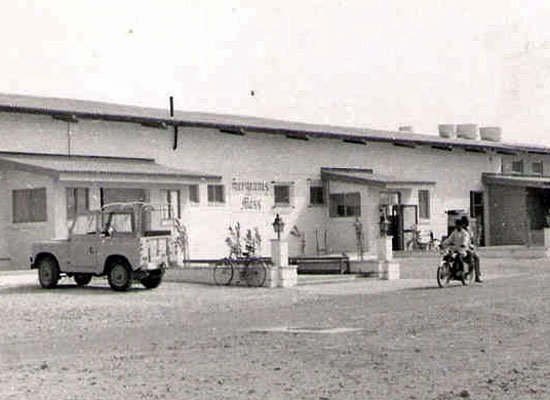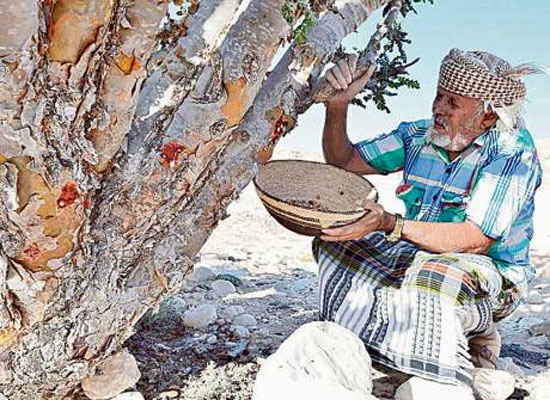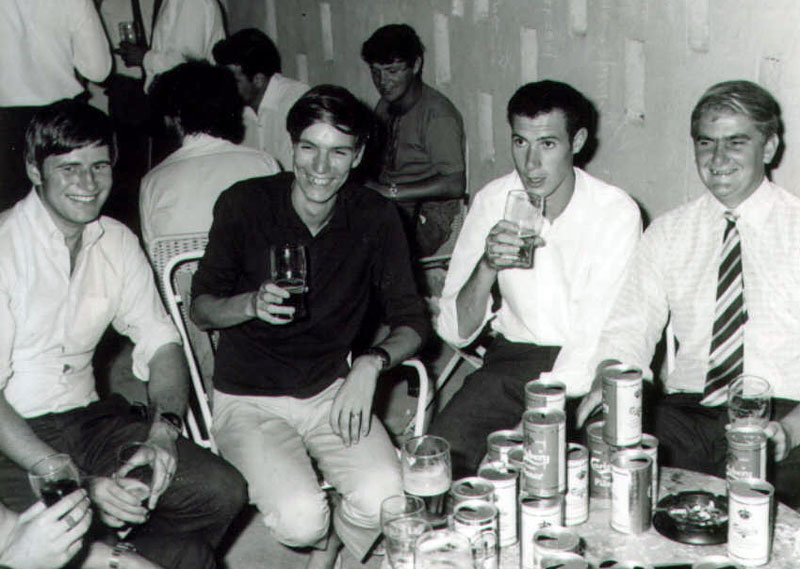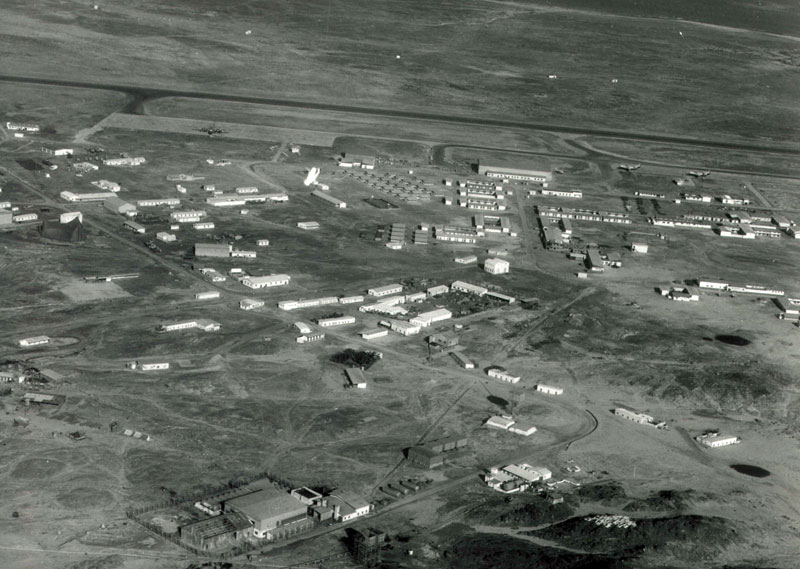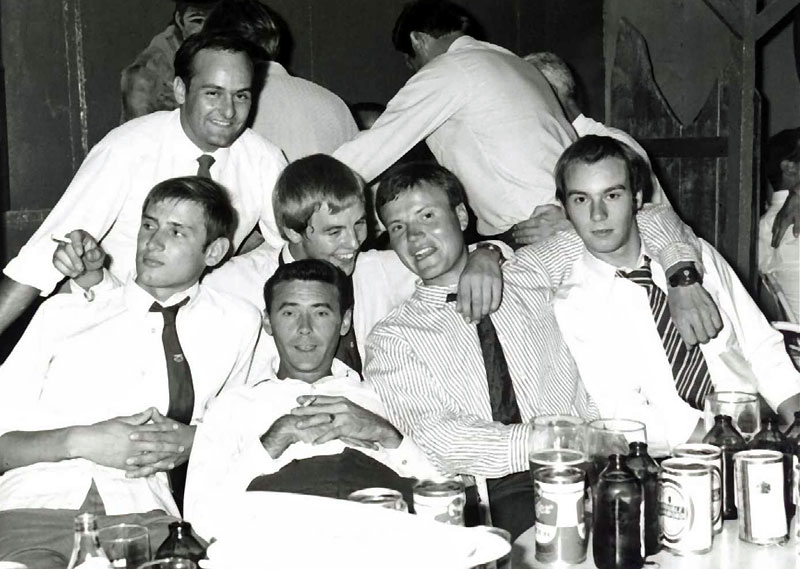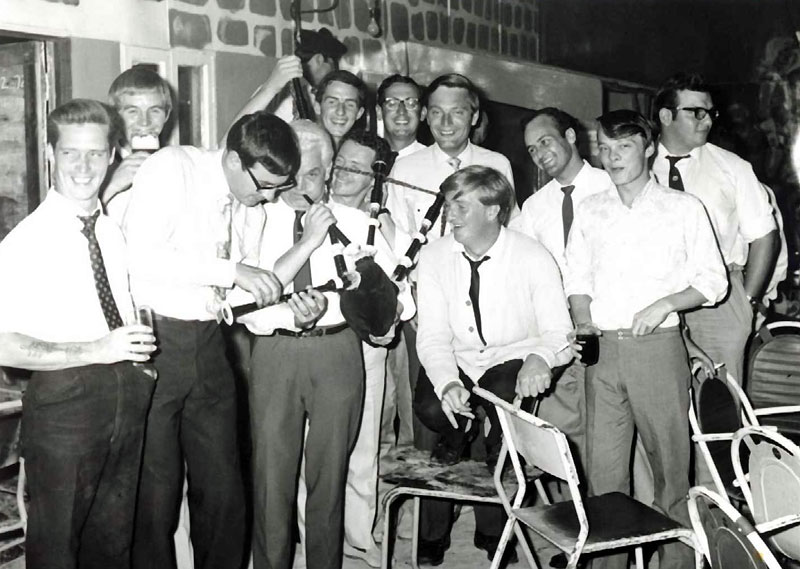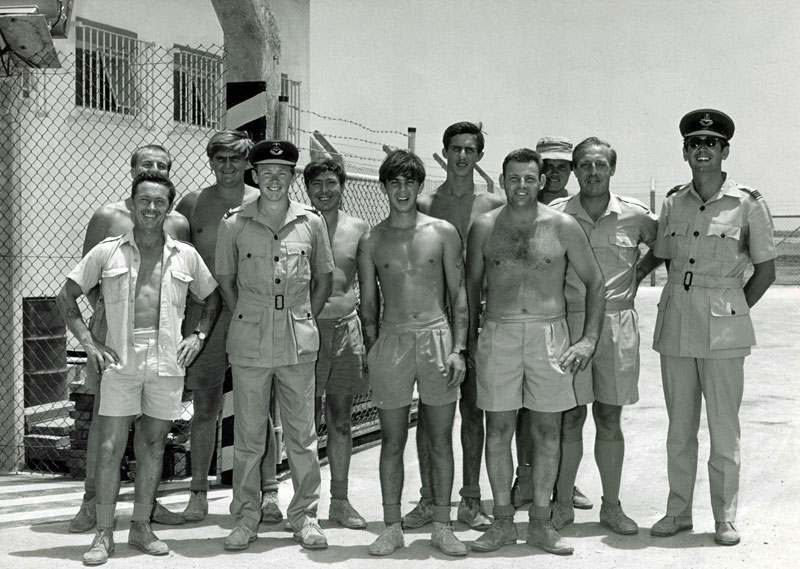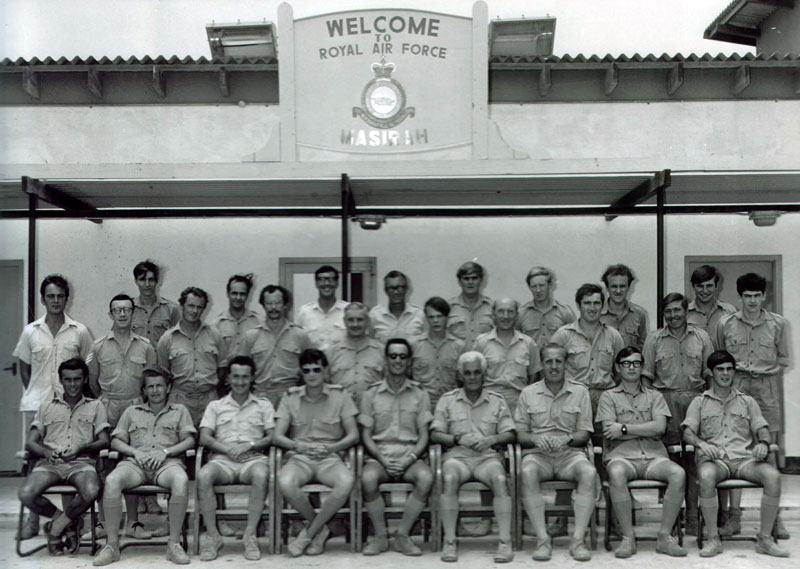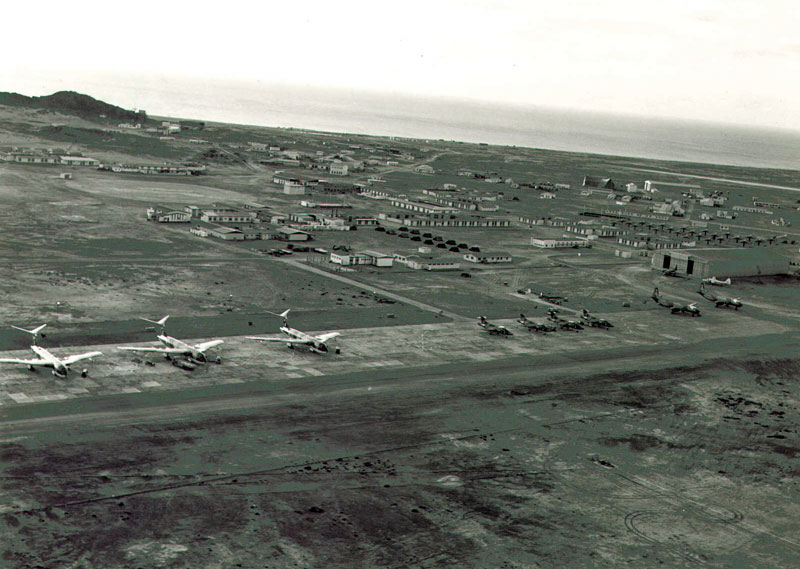


C130 completes its tour of duty and is replaced by the A400M Atlas
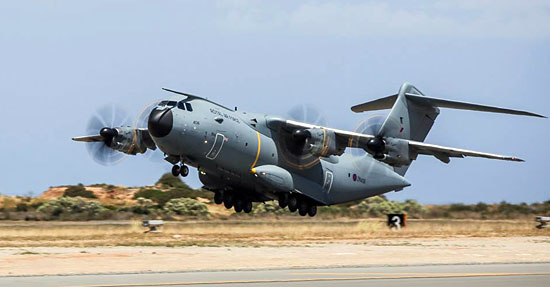
The last C130 squadron, providing the vital air bridge to UK personnel serving in and around the broader Middle East for the last 3 years, took to the skies for the final time in its operational role. It will be succeeded by the new Airbus A400M Atlas which will take over full squadron duties at the end of the month.
Although the A400M has undertaken sorties alongside the C130 before, this will be the first time one of its squadrons has deployed to the Middle East in an operational role.
Air Officer Commanding #83 EAG, Air Commodore Roddy Dennis, said: “The C130 crews both in the air and on the ground should be justifiably proud of their achievements. I thank them on behalf of 83 EAG for all their hard work in making our mission a success.”
Although the A400M has undertaken sorties alongside the C130 before, this will be the first time one of its squadrons has deployed to the Middle East in an operational role.
Air Officer Commanding #83 EAG, Air Commodore Roddy Dennis, said: “The C130 crews both in the air and on the ground should be justifiably proud of their achievements. I thank them on behalf of 83 EAG for all their hard work in making our mission a success.”
Royal Air Force

From: David Taylor, York
Subject: Re: UKMAMS OBA OBB #092917
Hello Tony,
Many thanks for adding my name to the newsletter mailing list, brings back loads of memories. As stated previously, I was not MAMS but TCMSF, so we would often have worked together; I wonder if anyone recalls Ch/Tech Ron King, a Britannia crew chief of some reknown. If you worked with him you would certainly remember, especially when it got to bar time! Boy, could he drink! I recall a party we were invited to in Canberra, Oz. Some Aussies decided to try and drink Ron under the table; ended up with them sloping off to bed, completely zonked, with the somewhat slurred words, 'There are the keys, Ron, lock up when you decide to leave!"
Another story gives some idea of what we occasionally had to endure as word spread. Landing at Offut AFB, Nebraska, on a flight from Lyneham, via a refuelling stop at Gander, we were shown into a crew room where beer abounded. One of the Americans, obviously a Texan, wore the inevitable cowboy boots - although at present he didn’t have them on. His boots had been removed and put to a better use. They had been filled with beer, just as another Britannia crew were shown in, tired and parched. “Ah, here come some more Brits. Boy, can they ever drink beer!” said one of the Americans, offering a full boot. One eager crew member stepped forward, took the proffered footwear and proceeded to empty it in one go. Then, wiping his lips, he says, ‘Pity it wasn’t a size twelve." It was at times like that one felt proud to be British.
As for HKG, only made it up there when working on Sunderlands at RAF Seletar, Singapore - yeah, that long ago! One of the squadron’s duties was to have an aircraft continually based at Kai Tak on Search & Rescue (SAR) standby. The aircraft usually sat at anchor in the bay formed by the main runway, onshore, and the new runway, still under construction, which extended out into the harbour. I was lucky enough to find myself detached there for a six week period. With but a couple of training flights - and thankfully no emergencies - there was not a lot for us to do on base.
Downtown was an altogether different kettle of fish. Ah! the memories: Chanticleir - a restaurant bar on main street - forget the name now - Kowloon. Honolulu Bar: “Enchanting music for dancing, genuine (?) drinks , delicious food”, so stated their gaily-coloured business card. It was something all bars gave out, possibly so you could later remember where the hell it was you’d been the previous night. They still adorn the inside covers of my photo albums. Lucky Star Bar & Nightclub was another, in the Wanchai district - oh, oh, Suzie Wong territory, that. Think maybe I met her sister. Said she wanted to improve her English, didn’t she? And here’s me, assuming she meant the language!
Subject: Re: UKMAMS OBA OBB #092917
Hello Tony,
Many thanks for adding my name to the newsletter mailing list, brings back loads of memories. As stated previously, I was not MAMS but TCMSF, so we would often have worked together; I wonder if anyone recalls Ch/Tech Ron King, a Britannia crew chief of some reknown. If you worked with him you would certainly remember, especially when it got to bar time! Boy, could he drink! I recall a party we were invited to in Canberra, Oz. Some Aussies decided to try and drink Ron under the table; ended up with them sloping off to bed, completely zonked, with the somewhat slurred words, 'There are the keys, Ron, lock up when you decide to leave!"
Another story gives some idea of what we occasionally had to endure as word spread. Landing at Offut AFB, Nebraska, on a flight from Lyneham, via a refuelling stop at Gander, we were shown into a crew room where beer abounded. One of the Americans, obviously a Texan, wore the inevitable cowboy boots - although at present he didn’t have them on. His boots had been removed and put to a better use. They had been filled with beer, just as another Britannia crew were shown in, tired and parched. “Ah, here come some more Brits. Boy, can they ever drink beer!” said one of the Americans, offering a full boot. One eager crew member stepped forward, took the proffered footwear and proceeded to empty it in one go. Then, wiping his lips, he says, ‘Pity it wasn’t a size twelve." It was at times like that one felt proud to be British.
As for HKG, only made it up there when working on Sunderlands at RAF Seletar, Singapore - yeah, that long ago! One of the squadron’s duties was to have an aircraft continually based at Kai Tak on Search & Rescue (SAR) standby. The aircraft usually sat at anchor in the bay formed by the main runway, onshore, and the new runway, still under construction, which extended out into the harbour. I was lucky enough to find myself detached there for a six week period. With but a couple of training flights - and thankfully no emergencies - there was not a lot for us to do on base.
Downtown was an altogether different kettle of fish. Ah! the memories: Chanticleir - a restaurant bar on main street - forget the name now - Kowloon. Honolulu Bar: “Enchanting music for dancing, genuine (?) drinks , delicious food”, so stated their gaily-coloured business card. It was something all bars gave out, possibly so you could later remember where the hell it was you’d been the previous night. They still adorn the inside covers of my photo albums. Lucky Star Bar & Nightclub was another, in the Wanchai district - oh, oh, Suzie Wong territory, that. Think maybe I met her sister. Said she wanted to improve her English, didn’t she? And here’s me, assuming she meant the language!
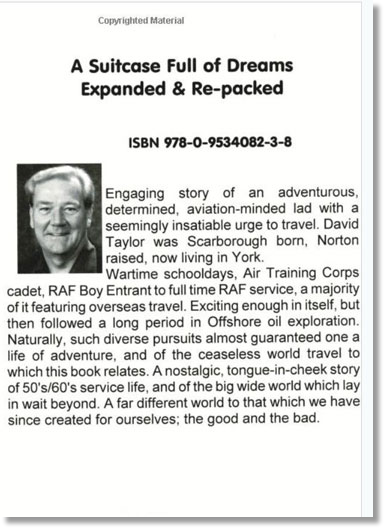
Best wishes to you all and I look forward to reading more stories in the future.
Dave
Dave
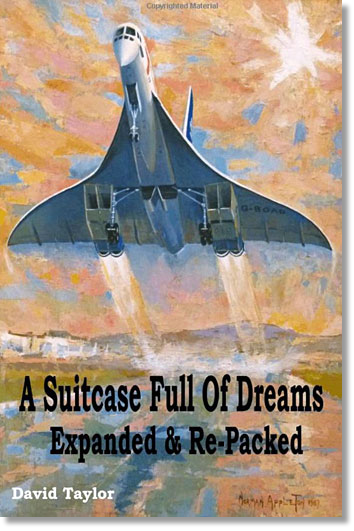
I have written an autobiography, published on Amazon: "A Suitcase Full of Dreams - Expanded & Re-Packed" (as it is an updated version) ISBN 978-0-9534082-3-8.

From: Nigel Moore, Devauden, Mon
Subject: Memories of Kai Tak
I came across the OBA site whilst doing some research and although I never served on MAMS I spent quite some time on “Mover” posts including Kai Tak having been posted there in November 1975 from the wilds of Lincolnshire. Your memories of Kai Tak has sparked this email.
The SAMO was Sqn Ldr John Sims with Flt Lt Eric Webely as DSAMO. I joined Brian Hunt as the shift DAMO’s, my post having been temporarily filled by a MAMS officer, Flt Lt Andy MacClean. Eric was replaced by Flt Lt Barry Simons. Kai Tak was bachelor heaven in-between work! Memorable trips included many to Nepal helping out with the Gurkha rotation run by MAMS in Kathmandu - evenings at “Brit House” were somewhat cloudy.
38 Group were more than kind authorising trips to assist with the Honour Guard rotation in Seoul - where the hotel bar/night club was christened, "The Upholstered Sewer" by the C-130 Air Engineer, MEng Nick Nicholls. I well remember a most fascinating two weeks with 6 Gurkha Regiment in Borneo, also a lengthy trip to the Philippines delivering aid following a substantial hurricane that hit the southern island of Mindanao - we were only allowed into Manila but the Philippines Air Force were kind enough to back-load a considerable quantity of Sam Miguel!
MAMS were supporting the Gurkha rotation, including my future best man, Flt Lt Geoff Elliott. Don Hunter was a regular visitor, as were many Movers from Gan and Singapore; those from the former stations spending much needed R&R in the hot spots of our lost empire!
Subject: Memories of Kai Tak
I came across the OBA site whilst doing some research and although I never served on MAMS I spent quite some time on “Mover” posts including Kai Tak having been posted there in November 1975 from the wilds of Lincolnshire. Your memories of Kai Tak has sparked this email.
The SAMO was Sqn Ldr John Sims with Flt Lt Eric Webely as DSAMO. I joined Brian Hunt as the shift DAMO’s, my post having been temporarily filled by a MAMS officer, Flt Lt Andy MacClean. Eric was replaced by Flt Lt Barry Simons. Kai Tak was bachelor heaven in-between work! Memorable trips included many to Nepal helping out with the Gurkha rotation run by MAMS in Kathmandu - evenings at “Brit House” were somewhat cloudy.
38 Group were more than kind authorising trips to assist with the Honour Guard rotation in Seoul - where the hotel bar/night club was christened, "The Upholstered Sewer" by the C-130 Air Engineer, MEng Nick Nicholls. I well remember a most fascinating two weeks with 6 Gurkha Regiment in Borneo, also a lengthy trip to the Philippines delivering aid following a substantial hurricane that hit the southern island of Mindanao - we were only allowed into Manila but the Philippines Air Force were kind enough to back-load a considerable quantity of Sam Miguel!
MAMS were supporting the Gurkha rotation, including my future best man, Flt Lt Geoff Elliott. Don Hunter was a regular visitor, as were many Movers from Gan and Singapore; those from the former stations spending much needed R&R in the hot spots of our lost empire!
With the planned draw-down (aka closure) of RAF Kai Tak, HQSTC bean-counters then struck with a handling contract going to Cathay Pacific and my dealings with Cathay management - Gerry Pengelly, Derek Smith and Mike Hambley - led to a frantic time at the airport in resolving many issues, including negotiating in-flight rations with the ALM’s and training the Cathay staff to produce trim sheets which we signed!
The SAMO slot was dispensed with and we were then “commanded” by aircrew; firstly, Sqn Ldr John Brown - any mover recall the KD shorts? - and later by another Brown - Sqn Ldr Mike Brown. Due to the downsizing and the handling contract Brian Hunt was short toured based on the new found principal of “first in first out” and we eventually moved from RAF Kai Tak to offices in what would now be called an “industrial unit" at the airport.
Happy days indeed and kind regards to any member who knew me.
Nigel Moore
The SAMO slot was dispensed with and we were then “commanded” by aircrew; firstly, Sqn Ldr John Brown - any mover recall the KD shorts? - and later by another Brown - Sqn Ldr Mike Brown. Due to the downsizing and the handling contract Brian Hunt was short toured based on the new found principal of “first in first out” and we eventually moved from RAF Kai Tak to offices in what would now be called an “industrial unit" at the airport.
Happy days indeed and kind regards to any member who knew me.
Nigel Moore


From: Ian Berry, West Swindon
Subject: Memories of Aden
After reading Mike Stepney’s recollections he got my memory going too... unlike my local good friends Colin Allen, Gordon Black and the sadly now departed Terry Roberts, fortunately I only had to serve a 100 day emergency detachment.
"Be prepared as it will come in fits and starts...” I was once warned. I was deployed in late January 1966 and proceeded to RAF Innsworth in Gloucester where I met the rest of my detachment. There were lots of jabs and doctor checkups plus the new kit issues including below the knee KD, nice new blue pyjamas and a kitbag to put it all in.
After a night in transit it was off to RAF Hendon, to wait. We spent two nights in an even worse transit block; there were 40 men to a room and only a small shelf to hold our personal stuff.
Finally it was off to Gatwick Airport by coach there to board a brand new British United Airways (BUA) VC-10. What a contradiction with comparative luxury as compared to the past few days.
Some six hours later, in the early hours, we arrived at Khormaksar. The smell! The heat! From there we boarded an armoured 39-seater coach (grills on the windows and an onboard escort armed with a sten gun) for our journey to RAF Steamer Point. That same evening there had been a grenade attack on the cinema queue waiting to enter HMS Sheba. Arriving halfway up Chapel Hill we collected our bedding to the cries of “Mooney” from a few drunks!
Subject: Memories of Aden
After reading Mike Stepney’s recollections he got my memory going too... unlike my local good friends Colin Allen, Gordon Black and the sadly now departed Terry Roberts, fortunately I only had to serve a 100 day emergency detachment.
"Be prepared as it will come in fits and starts...” I was once warned. I was deployed in late January 1966 and proceeded to RAF Innsworth in Gloucester where I met the rest of my detachment. There were lots of jabs and doctor checkups plus the new kit issues including below the knee KD, nice new blue pyjamas and a kitbag to put it all in.
After a night in transit it was off to RAF Hendon, to wait. We spent two nights in an even worse transit block; there were 40 men to a room and only a small shelf to hold our personal stuff.
Finally it was off to Gatwick Airport by coach there to board a brand new British United Airways (BUA) VC-10. What a contradiction with comparative luxury as compared to the past few days.
Some six hours later, in the early hours, we arrived at Khormaksar. The smell! The heat! From there we boarded an armoured 39-seater coach (grills on the windows and an onboard escort armed with a sten gun) for our journey to RAF Steamer Point. That same evening there had been a grenade attack on the cinema queue waiting to enter HMS Sheba. Arriving halfway up Chapel Hill we collected our bedding to the cries of “Mooney” from a few drunks!
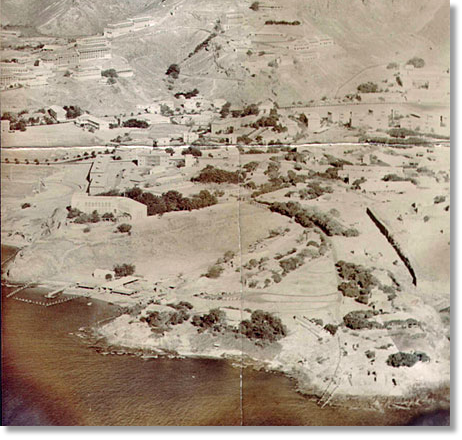
Steamer Point, Aden.Maidan Club, bottom left - Elephant
Bay, right - Chapel Hill, centre left and Crater behind the
hills at rear.
Bay, right - Chapel Hill, centre left and Crater behind the
hills at rear.
This barrack block was to be my home for the next 100 days. I was to work in 114MU across the main road (either side protected by a big wire fence and armed guards). A lot of things are a blur and others quite vivid. I do remember the last two C47 Dakotas operated by the RAF at Khormaksar. By the beach we had the Maidan Club and the Mermaid Club. All of the bars sold what was quite lethal draft Tiger Beer!
There were probably 8-10 army battalions providing security at this time. Our area was covered by the Cameronians, known as the Poison Dwarfs; hard and evil Scotsmen! They lived around the corner in Elephant Bay. In Tawahi itself the cover was provided by the Lancashire Fusiliers.
The sun was fierce and I learnt the hard way about nylon shirts offering no protection when I received third degree burns across my shoulders and arms, there are marks on my arms to this day. I also had the misfortune to go down with “Aden Gut” and spent four days in the Med Centre losing body fluids from all orifices and just wanting to die; not a recommended way of losing weight! We “Erks” were armed with .303 Lee-Enfield rifles whereas the squaddies had the new 7.62 SLRs. Five rounds and make them count!
I had just turned 18 at this stage and was quite naive in some matters. It was in Aden I actually tasted my first curry after gate crashing the Police Club. I also tasted tuna for the first time. Work at 114MU was becoming tedious and all because of some idiot permanent staff sergeant. We were employed in this huge shed and as there were copious amounts of red lead paint he had us painting the floor every week using brooms instead of brushes. The intention was to ship out the contents of the sheds back to Muharraq or UK using the huge empty aero engine boxes stored outside. I seem to recall that one of these crates was not empty and they discovered an Avon engine for a Hawker Hunter inside!
There were probably 8-10 army battalions providing security at this time. Our area was covered by the Cameronians, known as the Poison Dwarfs; hard and evil Scotsmen! They lived around the corner in Elephant Bay. In Tawahi itself the cover was provided by the Lancashire Fusiliers.
The sun was fierce and I learnt the hard way about nylon shirts offering no protection when I received third degree burns across my shoulders and arms, there are marks on my arms to this day. I also had the misfortune to go down with “Aden Gut” and spent four days in the Med Centre losing body fluids from all orifices and just wanting to die; not a recommended way of losing weight! We “Erks” were armed with .303 Lee-Enfield rifles whereas the squaddies had the new 7.62 SLRs. Five rounds and make them count!
I had just turned 18 at this stage and was quite naive in some matters. It was in Aden I actually tasted my first curry after gate crashing the Police Club. I also tasted tuna for the first time. Work at 114MU was becoming tedious and all because of some idiot permanent staff sergeant. We were employed in this huge shed and as there were copious amounts of red lead paint he had us painting the floor every week using brooms instead of brushes. The intention was to ship out the contents of the sheds back to Muharraq or UK using the huge empty aero engine boxes stored outside. I seem to recall that one of these crates was not empty and they discovered an Avon engine for a Hawker Hunter inside!
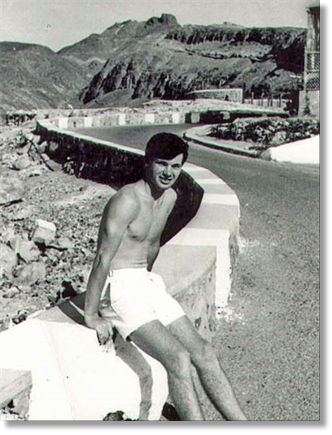
Yours truly on Chapel Hill - March 1967
One Monday we couldn’t paint the shed floor; seemingly all of the brushes were on their way to Muharraq!
Rumour also had it that the Movers at Khormaksar never got on with their counterparts in Muharraq. Things came to a head when the Khormaksar Movers loaded a dismantled aircraft arrestor barrier in the lower holds of a Britannia and then proceeded to reassemble it inside the hold. After two days on the pans at Muharraq they signalled, “Ok we give up, how did you load it?”
The food in Aden was something else, absolutely awful. Anyone who was there can remember that even every chip had at least three black eyes in it from the rotting potatoes. This was due to the four months stock of rations held in the ASD (Aden Supply Depot), the oldest being used first. I recollect Bromide flavoured tea too.
Rumour also had it that the Movers at Khormaksar never got on with their counterparts in Muharraq. Things came to a head when the Khormaksar Movers loaded a dismantled aircraft arrestor barrier in the lower holds of a Britannia and then proceeded to reassemble it inside the hold. After two days on the pans at Muharraq they signalled, “Ok we give up, how did you load it?”
The food in Aden was something else, absolutely awful. Anyone who was there can remember that even every chip had at least three black eyes in it from the rotting potatoes. This was due to the four months stock of rations held in the ASD (Aden Supply Depot), the oldest being used first. I recollect Bromide flavoured tea too.
We all had our personal set of eating irons and there was a place just outside the mess door where they could be washed. Quite often an unfortunate airman would be spotted trying to fish his eating irons out of a boiling hot cauldron of scum covered water after having accidentally dropped them in! This was probably the cause of my illness that I had mentioned earlier.
As time progressed the security situation did worsen and, just like Mike Stepney, I had a free ride back from Tawahi once in the back of a Landrover when there was a grenade attack. In reality it sounds much louder than in the movies.
Our General Duties Training also went on for a long while as there was so much to digest and warnings of booby traps and grenade drills. The lessons obviously worked as I remember what looked like an expensive Parker pen lying in the bondu for weeks as nobody would go near it...
There was a curfew between midnight and 06.00 and anyone caught out of bounds after that were fined £1 a minute. I do recall two SNCOs being caught out of bounds at 00.50am and were fined £50.00. That was well over a week’s wages.
As time progressed the security situation did worsen and, just like Mike Stepney, I had a free ride back from Tawahi once in the back of a Landrover when there was a grenade attack. In reality it sounds much louder than in the movies.
Our General Duties Training also went on for a long while as there was so much to digest and warnings of booby traps and grenade drills. The lessons obviously worked as I remember what looked like an expensive Parker pen lying in the bondu for weeks as nobody would go near it...
There was a curfew between midnight and 06.00 and anyone caught out of bounds after that were fined £1 a minute. I do recall two SNCOs being caught out of bounds at 00.50am and were fined £50.00. That was well over a week’s wages.
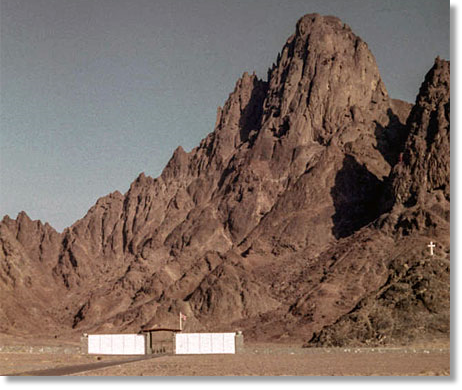
Silent Valley - British Military Cemetery
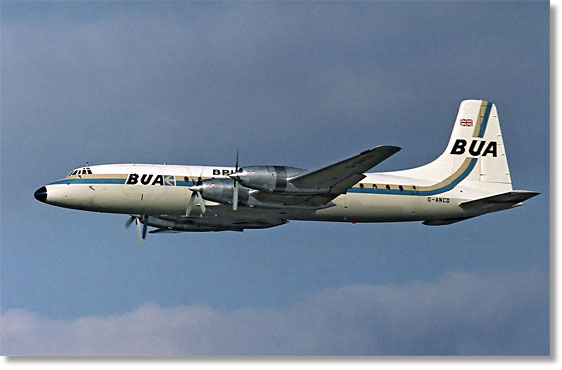
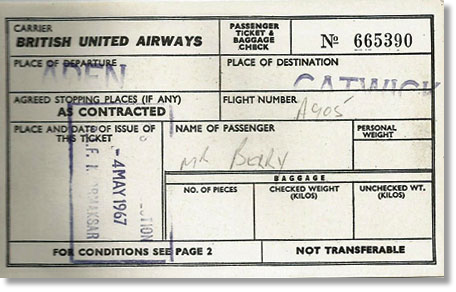
Was there anything good about Aden? I think the only thing was the duty free goods were really, really cheap. I still have a pair of Zenith 10 x 50 binoculars that I bought in Aden for £5.
Well, all good things come to an end and on 4th May, 1967 my time was up; I was going home. I boarded a BUA Britannia via Tehran and Athens where there had just been a coup staged by some Greek Colonels. The in-flight breakfast on board that aircraft was the best meal I had eaten in four months!
On arrival home there I was, young, fit, tanned and with a medal too. I was also told that Aden was the worst posting in the world... they lied! 18 months later I arrived at El Adem in Libya.
Well, all good things come to an end and on 4th May, 1967 my time was up; I was going home. I boarded a BUA Britannia via Tehran and Athens where there had just been a coup staged by some Greek Colonels. The in-flight breakfast on board that aircraft was the best meal I had eaten in four months!
On arrival home there I was, young, fit, tanned and with a medal too. I was also told that Aden was the worst posting in the world... they lied! 18 months later I arrived at El Adem in Libya.

Spartan 'ain't afraid of no dirt...
Our C-27J Spartans recently kicked up dust in remote parts of Western Australia and South Australia to test their off road capabilities.
Exercise Spartan Dawn saw them landing on a series of surfaces, including on a dry river bed and the Eyre Highway to test the Spartan's unique landing abilities.
The activity was also an opportunity to work with our mates in the South Australia Police and Royal Flying Doctor Service of Australia in reducing the isolation of our remote communities.
airforce.gov.au
Exercise Spartan Dawn saw them landing on a series of surfaces, including on a dry river bed and the Eyre Highway to test the Spartan's unique landing abilities.
The activity was also an opportunity to work with our mates in the South Australia Police and Royal Flying Doctor Service of Australia in reducing the isolation of our remote communities.
airforce.gov.au

ANTIPODEAN MOVERS’ FUN IN THE SUN
~ or ~
JUST ANOTHER DAY IN PARADISE ...
[Mike “OBie” O’Brien, formerly FLTLT, 2 i/c UNTAC MCG]
~ or ~
JUST ANOTHER DAY IN PARADISE ...
[Mike “OBie” O’Brien, formerly FLTLT, 2 i/c UNTAC MCG]
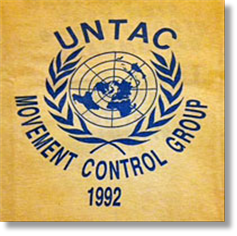
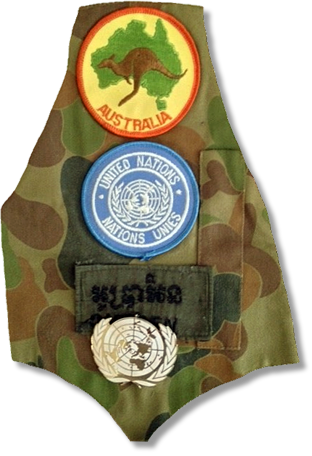
Introduction Cambodia, a South East Asian/Indochinese paradise, like its’ neighbours, had enjoyed a ‘reasonably sedate existence’ from antiquity ‘till the mid-1800's, and then enjoyed the gentle guiding hand of European Masters as a French Protectorate, until gaining Independence in 1953. From that period until March 1970, the country quietly progressed with the rest of South East Asia, and apart from some minor interruptions to its peaceful existence by the ‘police actions’ in neighbouring Laos and Vietnam, in the late 60's, the Republic of Cambodia basked in the glow of being considered the Paris of the East.
However, from Lon Nol's coup, establishing the Khmer Republic, in 1970, until April-May 1975, the Republic suffered numerous civil wars amongst the numerous factions who considered themselves best suited to rule this paradise.
Then, enter Pol Pot, whose absolute despotism during the next four years, turned Cambodia into a charnel house.
After the Vietnamese intervention in the late ‘70s and early ‘80s, and world-wide attention, the “The Supreme National Council” was the very painfully-conceived result of a tenuous union between the major players, the National Government of Cambodia and the State of Cambodia, and would represent Cambodian Sovereignty until the United Nations elections could be held, scheduled for mid-1993.
The UN Security Council Resolutions [Nos. 717 (1991), 728 and 745 (1992)], inter-alia, authorised the resolution of the problem in Cambodia by the creation of, initially, the United Nations Advance Mission in Cambodia, UNAMIC (in French: le Mission Préparatoire des Nations Uniés au Cambodge - MIPRENUC), established to 'pave the way' for UNTAC (the United Nations Transitional Authority in Cambodia; or in French: l'Autorité Provisoire des Nations Unié au Cambodge - APRONUC), mandated to commence in February 1992. The primary aim was that the personnel be deployed as quickly as possible after the Peace Agreement was signed in Paris, in October 1991. Accordingly, In order to deploy the 16,000 military personnel and 5,000 civilians, Movement Control and Reception/Concentration Centres were to be established outside Cambodia to induct, and coordinate the orderly deployment into the mission area.
Then, enter Pol Pot, whose absolute despotism during the next four years, turned Cambodia into a charnel house.
After the Vietnamese intervention in the late ‘70s and early ‘80s, and world-wide attention, the “The Supreme National Council” was the very painfully-conceived result of a tenuous union between the major players, the National Government of Cambodia and the State of Cambodia, and would represent Cambodian Sovereignty until the United Nations elections could be held, scheduled for mid-1993.
The UN Security Council Resolutions [Nos. 717 (1991), 728 and 745 (1992)], inter-alia, authorised the resolution of the problem in Cambodia by the creation of, initially, the United Nations Advance Mission in Cambodia, UNAMIC (in French: le Mission Préparatoire des Nations Uniés au Cambodge - MIPRENUC), established to 'pave the way' for UNTAC (the United Nations Transitional Authority in Cambodia; or in French: l'Autorité Provisoire des Nations Unié au Cambodge - APRONUC), mandated to commence in February 1992. The primary aim was that the personnel be deployed as quickly as possible after the Peace Agreement was signed in Paris, in October 1991. Accordingly, In order to deploy the 16,000 military personnel and 5,000 civilians, Movement Control and Reception/Concentration Centres were to be established outside Cambodia to induct, and coordinate the orderly deployment into the mission area.
In early 1992, pending the elections, the UN Transitional Authority in Cambodia (UNTAC) was created with the responsibility to:
I.
Oversee the demobilisation of 70% of the military forces of all parties.
II.
Supervise the cantoning of the military forces whilst retraining and regrouping was conducted.
III.
Assist and control internal security and police forces, and monitor the ceasefire.
IV.
Verify the cessation of external aid to the military forces of the parties.
V.
Ensure the absence of coercion in the repatriation of the refugees.
VI.
Assist with reconstruction of the civil infrastructure.
VII.
Organise and run the elections.
What’s all this got to do with Antipodean Movers?
The Canadian Government had provided some Logistics personnel to commence the Reception / Concentration tasks with their commitment to UNAMIC, and the Danish Government had initially offered a Movement Control capability, but withdrew it in early April 1992. To counter the capability shortfall the Australian Government provided a Movement Control Group, a concept which had been trialled over the previous few years in large-scale tri-Service Excercises, and had proven successful, especially during the civilian airlines’ pilots strike in August 1989, which coincided with the redeployment activities at the end of Exercise Kangaroo 89. For UNTAC, the tasks, initially, were considered to be those of Headquarters-level management and coordination of the deployment activities.
The Australian Government was quite specific that the deployment was to be for a maximum of four months only. The personnel, drawn from all over Australia were formally advised Fri 1 May 1992, and concentrated at Randwick Army Barracks, Sydney, on Tues 5 May for pre-deployment preparation; they departed by commercial passenger flight Mon 11 May, via Melbourne, with an overnight stop in Bangkok. Onwards movement from Bangkok was by a UN Flight operated by a French Air Force Transall, which arrived in Phnom Penh at 1000 hrs, 12 May 92. Amongst the ADF group of 30 personnel were seven Navy, 16 Army, and three RAAF Officers and four SNCOs, with Army to provide the Officer Commanding, and Air Force the 2IC. The lucky RAAF participants were the author, (then) FLTLT Mike “OBie” O’Brien as 2IC, and contributors, (then) FLTLTs Neil Collie (recently ex-RAF), and Steve Force, WOFF Errol Reidlinger, FSGTs Neil Gray and Wayne Riddle and SGT George Molnar, all of whom were RAAF Air Movements (and multi-modal transport) qualified.
The Canadian Government had provided some Logistics personnel to commence the Reception / Concentration tasks with their commitment to UNAMIC, and the Danish Government had initially offered a Movement Control capability, but withdrew it in early April 1992. To counter the capability shortfall the Australian Government provided a Movement Control Group, a concept which had been trialled over the previous few years in large-scale tri-Service Excercises, and had proven successful, especially during the civilian airlines’ pilots strike in August 1989, which coincided with the redeployment activities at the end of Exercise Kangaroo 89. For UNTAC, the tasks, initially, were considered to be those of Headquarters-level management and coordination of the deployment activities.
The Australian Government was quite specific that the deployment was to be for a maximum of four months only. The personnel, drawn from all over Australia were formally advised Fri 1 May 1992, and concentrated at Randwick Army Barracks, Sydney, on Tues 5 May for pre-deployment preparation; they departed by commercial passenger flight Mon 11 May, via Melbourne, with an overnight stop in Bangkok. Onwards movement from Bangkok was by a UN Flight operated by a French Air Force Transall, which arrived in Phnom Penh at 1000 hrs, 12 May 92. Amongst the ADF group of 30 personnel were seven Navy, 16 Army, and three RAAF Officers and four SNCOs, with Army to provide the Officer Commanding, and Air Force the 2IC. The lucky RAAF participants were the author, (then) FLTLT Mike “OBie” O’Brien as 2IC, and contributors, (then) FLTLTs Neil Collie (recently ex-RAF), and Steve Force, WOFF Errol Reidlinger, FSGTs Neil Gray and Wayne Riddle and SGT George Molnar, all of whom were RAAF Air Movements (and multi-modal transport) qualified.
Upon arrival at Phnom Penh we were accommodated at “Pteah Australii”, the home of the UNTAC ANZAC Force Communications Unit, for three days, until other accommodations could be arranged in Phnom Penh city for the Headquarters wallahs, and deployment to the up-country locations for the 'MovCon Det' personnel, like Siem Reap, Battambang and Kompong Soam in Cambodia, and U-Tapao, near Pattaya, and Bangkok, Thailand(!). Our accommodation separate to the other Australian personnel was to reinforce our “UNTAC HQ status”, as distinct from the Australian Contingent chain of command.
Accordingly, we lived in 'hotels' of varying degrees of salubriousness and economic status, and which at first was seen as good fun, but after a while the constant noise of traffic and the ever-present ‘nightly-‘ and 'pre-dawn choruses' of horizontal enjoyment, construction, funeral processions and general cacophony became a bit wearying. Similarly, the 'eating-out' novelty soon wore off; there not being much variety in the wine-lists and 'blue steak' was just unheard of.
Accordingly, we lived in 'hotels' of varying degrees of salubriousness and economic status, and which at first was seen as good fun, but after a while the constant noise of traffic and the ever-present ‘nightly-‘ and 'pre-dawn choruses' of horizontal enjoyment, construction, funeral processions and general cacophony became a bit wearying. Similarly, the 'eating-out' novelty soon wore off; there not being much variety in the wine-lists and 'blue steak' was just unheard of.
The Australian Movement Control Group pre-boarding UN Transall at Don Muang Airport, Bangkok
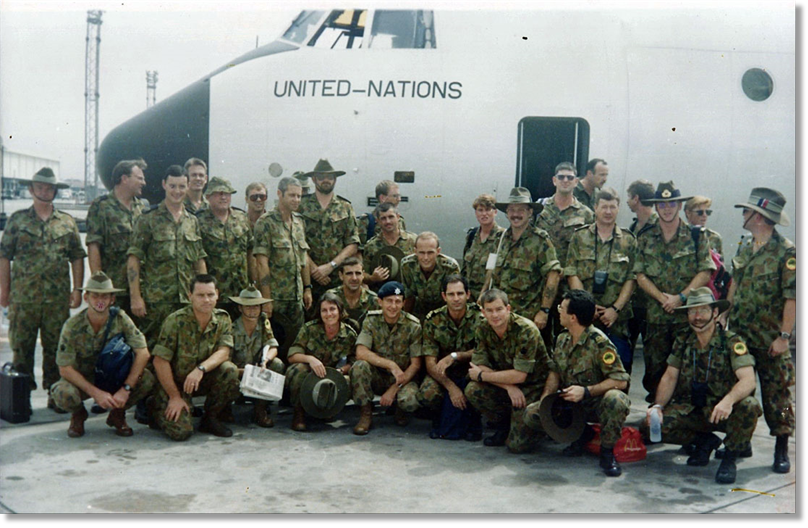
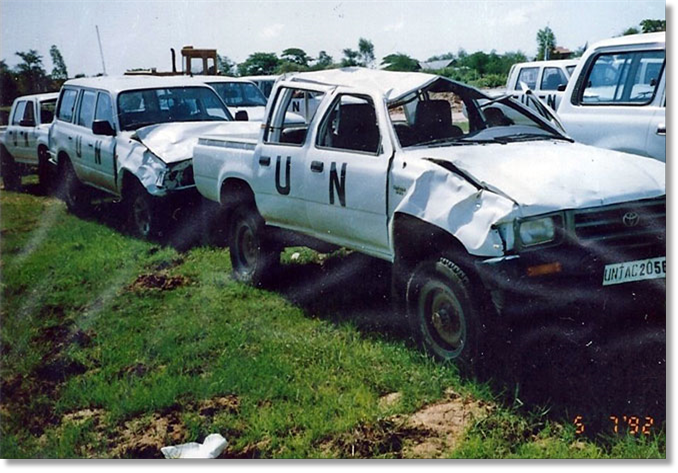
Some of the vehicles donated by Japan, less than six weeks after receipt!
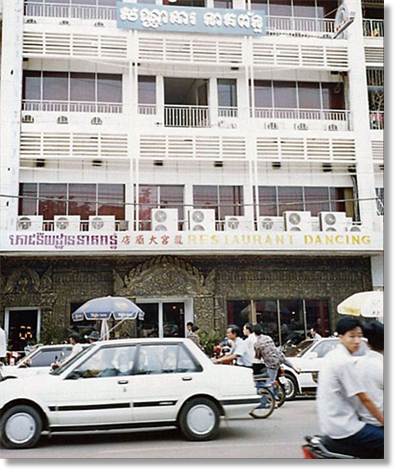
Hotel Restaurant-Dancing Neak Poan
"Rates hourly by negotiation."
"Rates hourly by negotiation."
The UN 'working' hours, 0800-1200, 1400-1800 Mon to Sun inclusive, were designed to take into account the necessity of conserving energy during the hottest part of the day, and also to account for the enormous influx of people demanding sustenance from the very meagre resources; in effect, initially there were just not enough restaurants to cater for the thousands of UN personnel flooding into Phnom Penh, all of whom expected to be fed at the same time. There was soon, however, a noticeable increase in restaurants catering to the UN tastes, and allowances’ largesse, within the first couple of months.
Similarly, a commensurate increase in surface traffic, mostly white 4WD Toyotas and Nissans, was experienced; in fact, Phnom Penh was the most frustrating of cities in which to drive as there appeared to be a complete absence of road rules, not only on the part of the Cambodians, but moreso, the UN drivers, some of whom were less than competent. Amusingly, we were the ones who instituted, and issued, a record of UNTAC Driver's Licences, and were somewhat bemused by the battalion-sized contingents who arrived with consecutively-numbered home-nation licences, all issued on the same date, and the majority of whom proceeded to disprove the veracity of those same documents. This was indeed a portent of the driving “skills” I was to encounter in many future [all!] UN Missions.
Similarly, a commensurate increase in surface traffic, mostly white 4WD Toyotas and Nissans, was experienced; in fact, Phnom Penh was the most frustrating of cities in which to drive as there appeared to be a complete absence of road rules, not only on the part of the Cambodians, but moreso, the UN drivers, some of whom were less than competent. Amusingly, we were the ones who instituted, and issued, a record of UNTAC Driver's Licences, and were somewhat bemused by the battalion-sized contingents who arrived with consecutively-numbered home-nation licences, all issued on the same date, and the majority of whom proceeded to disprove the veracity of those same documents. This was indeed a portent of the driving “skills” I was to encounter in many future [all!] UN Missions.
Initially the Australian 'MovCon' personnel were regarded with considerable suspicion by some of the already 'well established' nationalities from the forerunner UNAMIC Mission who had 'settled in' so to speak, and were accordingly reluctant to share their power. An example is the UNAMIC Force Commander, provided by a previous colonial master, who had been 'relegated' to the appointment of Deputy Force Commander of UNTAC. There was quite a degree of animosity on behalf of some of the personnel who considered that they had prior rights to the transport assets as they were provided by their country, and other nationalities should not have any say in their disposition or use.
Until our arrival there had been no form of accountability, or passenger / freight /cargo documentation for any of the modes of transport being used by the UN. The usual procedure for having anything or anyone carried by air (helicopter or fixed wing) was to turn up at the airport(s) and cajole the crew into carrying the item, and then hoping that the aircraft would proceed to the destination advertised, and that the cargo would be unloaded, and given to whom it was intended. Notwithstanding that, the UN agencies IATA and ICAO are responsible for promulgation of airway regulations and Dangerous Goods Transportation Regulations, none of the operators in Cambodia in May '92 seemed to be too concerned about what they carried.
There was a “tasking office”, in operation, also provided by a previous colonial master, whose stated purpose was to allocate flights to effect sustainment and support operations, however their parochial attitude more often than not precluded efficient use of the resources … pencil-drawn wall charts are quite easily ‘amended’, depending on the attributes of the requester!
One of the Australians' first tasks, therefore, was the institution of International Standard Transportation procedures, for example manifesting of cargo, be it 'self-loading or otherwise'. We quickly realised that our tasking would extend beyond HQ/management duties to encompass ‘a hands-on approach’ to ensure the capability available would be best-used. The majority of the work performed by the RAAF personnel was to coordinate, and facilitate the application of air transportation procedures; implementation of this was extremely difficult, as was application of the rules and regulations pertaining to storage of dangerous cargo and explosives. As Australia is a signatory to the UN agencies' transportation regulations, the Department of Defence follows these rigorously, with exceptions only approved in times of declared national emergency. The picture below is yours truly, "Not quite in accordance with DG Storage Regs."
Until our arrival there had been no form of accountability, or passenger / freight /cargo documentation for any of the modes of transport being used by the UN. The usual procedure for having anything or anyone carried by air (helicopter or fixed wing) was to turn up at the airport(s) and cajole the crew into carrying the item, and then hoping that the aircraft would proceed to the destination advertised, and that the cargo would be unloaded, and given to whom it was intended. Notwithstanding that, the UN agencies IATA and ICAO are responsible for promulgation of airway regulations and Dangerous Goods Transportation Regulations, none of the operators in Cambodia in May '92 seemed to be too concerned about what they carried.
There was a “tasking office”, in operation, also provided by a previous colonial master, whose stated purpose was to allocate flights to effect sustainment and support operations, however their parochial attitude more often than not precluded efficient use of the resources … pencil-drawn wall charts are quite easily ‘amended’, depending on the attributes of the requester!
One of the Australians' first tasks, therefore, was the institution of International Standard Transportation procedures, for example manifesting of cargo, be it 'self-loading or otherwise'. We quickly realised that our tasking would extend beyond HQ/management duties to encompass ‘a hands-on approach’ to ensure the capability available would be best-used. The majority of the work performed by the RAAF personnel was to coordinate, and facilitate the application of air transportation procedures; implementation of this was extremely difficult, as was application of the rules and regulations pertaining to storage of dangerous cargo and explosives. As Australia is a signatory to the UN agencies' transportation regulations, the Department of Defence follows these rigorously, with exceptions only approved in times of declared national emergency. The picture below is yours truly, "Not quite in accordance with DG Storage Regs."
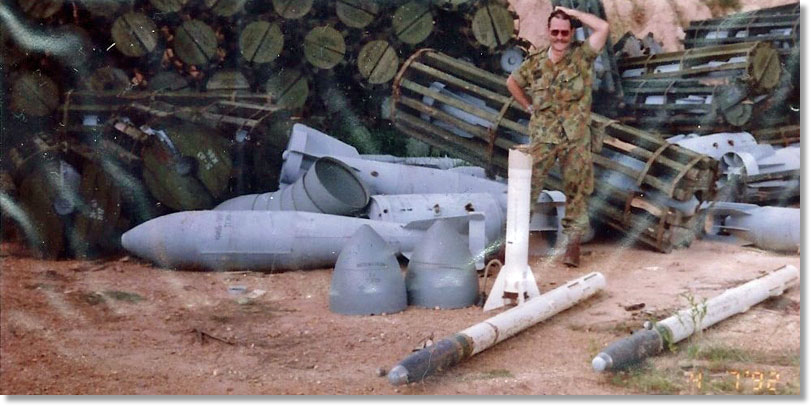
A task which took considerably longer to succeed at was that of coordinating airframe usage to capability, and forecasting requirements and loads (to reduce the wastage of flying empty airframes around the country on 'positioning legs'), and 'flight following / notification' (maintaining communications with aircraft to enhance safety). This problem was not as great in respect of riverine, sea and land transport, and I believe that 'nationalities' had a great deal to do with this.
Due to the variety of national military forces in country there were considerable differences in the way problems were approached ... from the 'get stuck in and have a go' style, to the 'if we ignore it, it will go away' approach. It took us nearly two months to be 'allowed' to trial an Air Movements Operations Coordination Centre (“AMOCC”, apt indeed!), which was based on the ADF/RAAF MOVCOORDC. It represented a novel approach in asset-management which incorporated planning for more than two days ahead, obtaining feed-back from the airframe operators in respect of which missions were not flown, and why being shot at constituted adequate reason for aborting a task, and actually involving the planning, operations and movements staff in further planning and decision-making.
For the statisticians, the following aircraft types and details may provide an insight into the variety of work being carried out by the UN air force in Cambodia; there were, in country, and based at U-Tapao (Thailand, near Pattaya), the following air assets:
Due to the variety of national military forces in country there were considerable differences in the way problems were approached ... from the 'get stuck in and have a go' style, to the 'if we ignore it, it will go away' approach. It took us nearly two months to be 'allowed' to trial an Air Movements Operations Coordination Centre (“AMOCC”, apt indeed!), which was based on the ADF/RAAF MOVCOORDC. It represented a novel approach in asset-management which incorporated planning for more than two days ahead, obtaining feed-back from the airframe operators in respect of which missions were not flown, and why being shot at constituted adequate reason for aborting a task, and actually involving the planning, operations and movements staff in further planning and decision-making.
For the statisticians, the following aircraft types and details may provide an insight into the variety of work being carried out by the UN air force in Cambodia; there were, in country, and based at U-Tapao (Thailand, near Pattaya), the following air assets:
•
6 x Puma helo (Fr.), 2 t. capable, 16 troops (30 if combat-loaded), based at Pochentong Air Base, Phnom Penh (PNP).
•
3 x C160 Transall (Fr.), less than C130 capability, with less range, also PNP-based.
•
3 x L100 series C130's, 1 from Transafrik, and 2 from Heavylift, with civilian crews, very professional, based at U- Tapao.
•
20 x MI-17 helos, 2 t. capable, internal or external, up to 40 pax combat-loaded, ex USSR Air Force (Afghanistan), based at PNP, several of which had been 'brassed-up' by the NADK, much to the (ex-USSR Air Force) crews' displeasure.
•
3 x RNlAF Fokker F27, 25 pax/5t., crewed very professionally by Dutch Air Force crews, based at UTP, where the Dutch had a large military presence.
•
1 x Beechcraft exec, 6 - 10 pax depending upon range requirement and runway capability, crewed by Danes, based at PNP for the use of the Mission director and other VIPs.
•
2 x MI-26 helos, 20t., internal or external, or 80-odd troops combat loaded [110 allegedly, if seriously combat loaded], leased from Aeroflot, operated by Aerolift/Heavilift, and crewed by Australians/Kiwis/Russians, based at PNP, who did an excellent job moving oversize/heavy stuff (like full TEUs) into areas inaccessible to fixed-wing.
The considerable air-lift capability in the region, with Pochentong Air Base, Phnom Penh, averaging 40 aircraft departures/turn-arounds/arrivals per day (daylight hours only, as there was no night-operations capability), was severely impeded by the paucity of material handling equipment and poor road transport infrastructure, and as a consequence, small problems often become major headaches very quickly.
UNTAC MCG Air Movements Ops Officers; Collie & Riddle (RAAF) & Froggat (Army) at Pochentong
Commercially contracted AN-12 operating [snrrrk!] in support of NGO
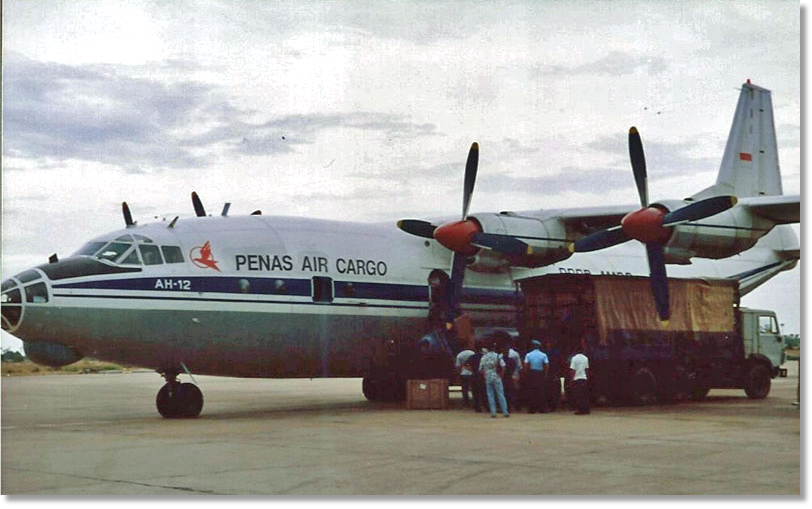
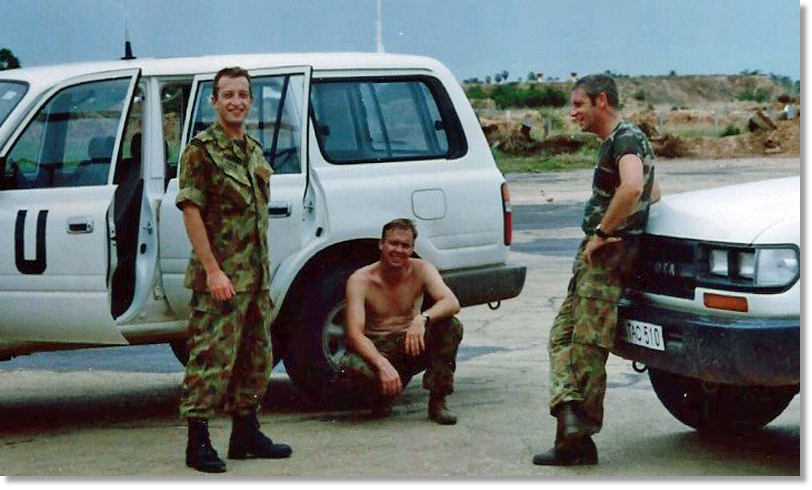
For the majority of the deployment, the Air Movements section at Pochentong consisted of two people, an RAAF Officer [and from him, more to come, later!] and SNCO, assisted by a French Air Force 'BOMAP' (air despatch) team, subordinated to HQMCG, who loaded the French aircraft and assisted when available with the other aircraft; naturally, there were only two of us who spoke any form of French (the author and FLTLT Collie), and only one of the BOMAP team was conversant in English ... but as we said, they had to work as hard to understand our French as we did to speak it!
As the wet season set in, in June, and as there were only four airfields in-country with fixed wing capability, the maximum use of helicopters became a priority, as surface transport access deteriorated.
As the wet season set in, in June, and as there were only four airfields in-country with fixed wing capability, the maximum use of helicopters became a priority, as surface transport access deteriorated.
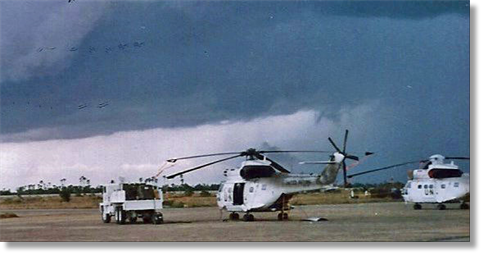
French Pumas about to get wet
As I was to discover, the supply and allocation of administrative necessities in most UN Missions was not determined by the operational requirement for support, but more on the assumed status of the ‘requirer’, computers and communications assets being a case in point. From our arrival until well into the third month of our deployment we struggled to maintain reasonable comms and flight-following capability with the aircraft on daily taskings. Had it not been for the good relationships we formed with the Canadian contingent [PPLI 92éme Transport Coy] with whom we shared office space and resources, along with the Polish and Pakistani logistics elements, there would have been little ability to effect any change to the ‘developing nation’ mentality that pervaded the Mission.
Further, the parlous state of the Cambodian infrastructure after more than 20 years of destruction and neglect often worked against us.
Further, the parlous state of the Cambodian infrastructure after more than 20 years of destruction and neglect often worked against us.
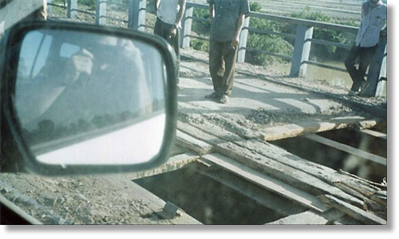
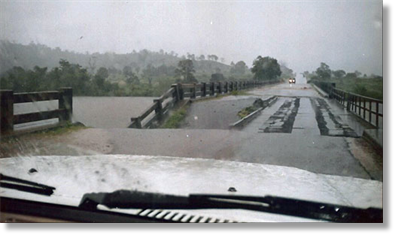
‘Normal’ bridge
‘Normal’ bridge in the rain
The Netherlands Government provided 48 army personnel for MovCon duties, who arrived 4 July; unfortunately, only 12 were Movements trained (the balance were 'conscripts', some with only three months military service), and none of whom had any Air Movements / Transportation qualifications or expertise. We then had to instruct them 'on the job', and in order to encourage them to accept their responsibilities, we gained approval for our return home to be staggered, with an Advance Party (four pers) scheduled to depart 10 Aug, the Main Body (16 pers) on 17 Aug, and the Rear Party (10 pers) on 7 Sep '92.
The rear party comprised most of the AirOps people as this part of the transportation infrastructure was the most critical, and proved the most difficult for the Dutch to grasp. There was considerable reluctance to continue the administrative processes of booking personnel to flights (ie seat allocation) to ensure that there was no 'mad scramble' for seats when aircraft were scheduled to depart, and to raising of passenger and cargo manifests to identify who and what were on the aircraft, in the unfortunate event of crashes.
To further increase the enthusiasm for our replacements to learn, and assume responsibility for the operations and projects, we were advised that we had to take some of the UN leave we had accrued; a consequence of the 7-day-a-week ops was that we had not used any of the "Compensatory Time Off" days (6 days per month) that we were owed [unbeknown to us]; we were required to use 2-months worth, or lose it, and it could not be transferred to our National admin system. Thus, in the last week of July, and the first two weeks of August, most of the Australians took a week off, and went 'on hols' to either Pattaya, Bangkok, or in the case of O'Brien and Force, Hong Kong.
Movers’ other skills As well as the Movements and Transportation aspects of the Mission, we were also involved in the Logistics and Project Management, as transportation coordination was an integral part of all project tasks.
The rear party comprised most of the AirOps people as this part of the transportation infrastructure was the most critical, and proved the most difficult for the Dutch to grasp. There was considerable reluctance to continue the administrative processes of booking personnel to flights (ie seat allocation) to ensure that there was no 'mad scramble' for seats when aircraft were scheduled to depart, and to raising of passenger and cargo manifests to identify who and what were on the aircraft, in the unfortunate event of crashes.
To further increase the enthusiasm for our replacements to learn, and assume responsibility for the operations and projects, we were advised that we had to take some of the UN leave we had accrued; a consequence of the 7-day-a-week ops was that we had not used any of the "Compensatory Time Off" days (6 days per month) that we were owed [unbeknown to us]; we were required to use 2-months worth, or lose it, and it could not be transferred to our National admin system. Thus, in the last week of July, and the first two weeks of August, most of the Australians took a week off, and went 'on hols' to either Pattaya, Bangkok, or in the case of O'Brien and Force, Hong Kong.
Movers’ other skills As well as the Movements and Transportation aspects of the Mission, we were also involved in the Logistics and Project Management, as transportation coordination was an integral part of all project tasks.
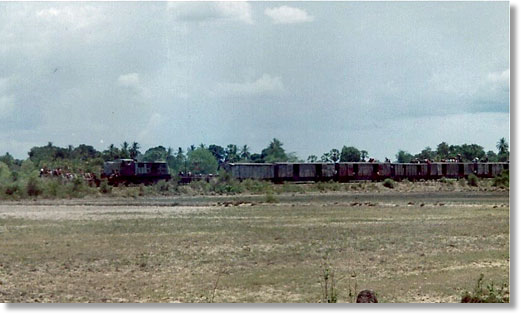
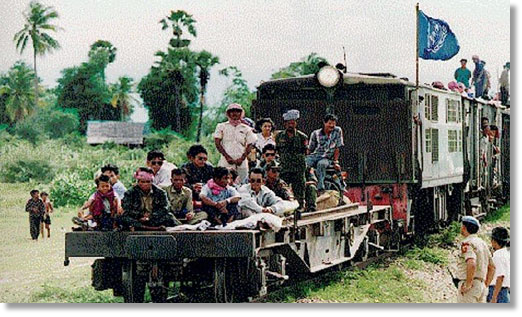
But, we were instrumental in getting the railway running …
Three main projects were managed and coordinated to a smaller or larger degree by Australian Movement Control Group personnel, and the Canadian Logistics personnel; they were:
a.
"Operation Wishbone" - provision of foodstuffs and containers to the refugee and cantonment sites. The food encouraged the soldiers to give up their weapons, and the containers were used initially to transport and store the foodstuffs, then to secure the weapons. This operation was predominantly a Canadian/Australian effort, which commenced 11 Jun, and continued throughout the duration of the deployment.
b.
"Operation Mercury" - provision of generators to provincial headquarters and other necessary sites. The generators ranged from small, man-portable, to large, 2,000lb air-portable, town power generation units. Again, predominantly Canadian/Australian, military and civilian personnel. This operation commenced 18 Jun, and had not been completed by the time we left mid-Sep.
c.
"Operation Locktite" - provision of portable buildings and camp-complexes for use by UN personnel and administrative infrastructure rebuilding, throughout the country. Comprising Canadian and Australian military personnel and several contracted civilian companies, notably "WeatherHaven" from Canada, and "MSD" and "Ausco" from Australia, this operation, like "Mercury", commenced on 18 Jun, and had not been completed by the time we left.
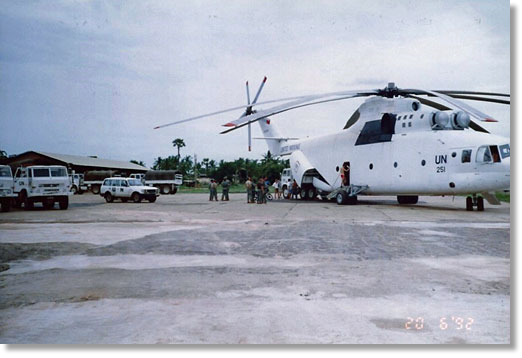
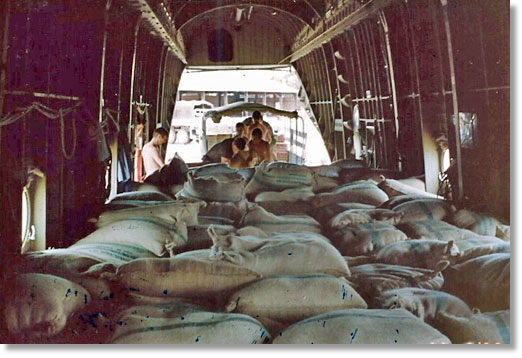
" Wishbone" UN251 Mi-26 Flat-floor 15t rice, 2t tin fish, 2t veg oil
On a cultural note, the author was requested by the Australian Diplomatic Mission to assist with the transportation to Australia by RAAF C130 and QANTAS of the "Age of Angkor" Khmer antiquities exhibition being mounted by the Australian National Gallery. These national treasures were packaged by an Australian company, at the Phnom Penh Museum of Fine Arts, then transported by RAAF C130 to Bangkok, where they were trans-shipped to a QANTAS 747 for the voyage to Australia (the process was reversed in November for the return voyage).
The RAAF MCG personnel were all involved in this project in some form or other, and although not strictly UNTAC-related, the successful completion of the task reflected further credit on the Australian movements personnel. Two RAAF C130 flights were involved in this task and gave us the opportunity to work with some professionals for a couple of hours on the days that they were in Phnom Penh (23 Jun and 22 Jul). These two flights were also used to convey stores and mail to the ANZAC Contingent in UNTAC, and we were probably the most sought after Australians in Cambodia on those two days, more than normally so because of our transport assets' attractiveness.
The arrival of the first C130 was much awaited by us, as we knew that it would bring 'care-packages' from home ... and it would be well worth building pallets in the heat and humidity (about 35ºC and 85-90% humidity by midday).
The RAAF MCG personnel were all involved in this project in some form or other, and although not strictly UNTAC-related, the successful completion of the task reflected further credit on the Australian movements personnel. Two RAAF C130 flights were involved in this task and gave us the opportunity to work with some professionals for a couple of hours on the days that they were in Phnom Penh (23 Jun and 22 Jul). These two flights were also used to convey stores and mail to the ANZAC Contingent in UNTAC, and we were probably the most sought after Australians in Cambodia on those two days, more than normally so because of our transport assets' attractiveness.
The arrival of the first C130 was much awaited by us, as we knew that it would bring 'care-packages' from home ... and it would be well worth building pallets in the heat and humidity (about 35ºC and 85-90% humidity by midday).
RAAF C130 A97-001 “BU-601” at Pochentong to collect the “Age of Angkor” artefacts
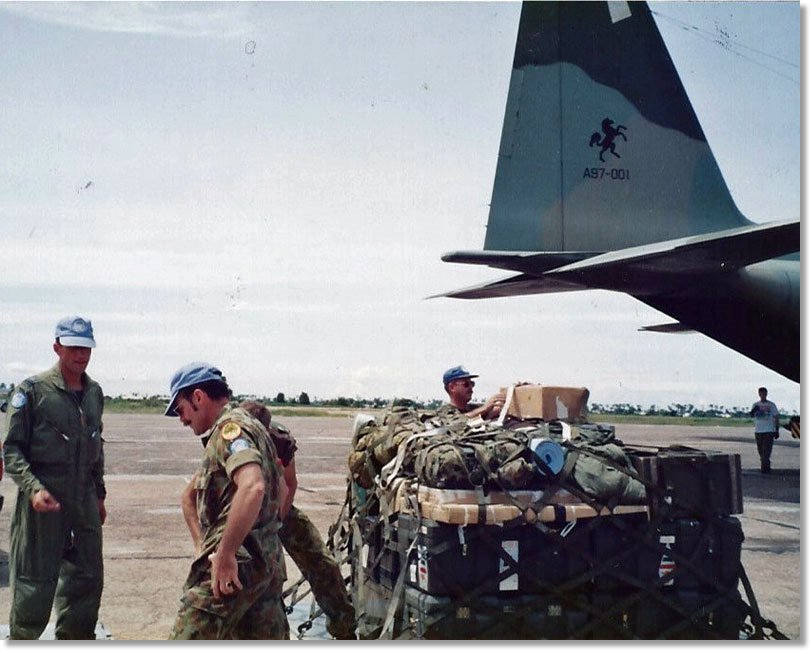
The involvement in the “Age of Angkor” task supplemented our rather fragile link with home, which for the first six weeks was via post only, which generally took about two weeks from mailing to receipt; phone communications outside the military comms nets was tenuous for the first couple of months, until the military and commercial contractors were able to rebuild the civilian, mostly mobile, telephone system.
Less work
Of note, we were not blind to the depredations of Cambodia’s previous rulers and pretenders, and took the opportunity to absorb the evidence of the most recent, Pol Pot. The Tuol Sleng/S21 Prison, previously a school, now a museum to four years of horror, was certainly an example of man’s inhumanity. Most of the photographic evidence presented was as documented by the Khmer Rouge themselves, and rescued by the Vietnamese authorities upon their expulsion of Pol Pot’s administration in 1979
Less work
Of note, we were not blind to the depredations of Cambodia’s previous rulers and pretenders, and took the opportunity to absorb the evidence of the most recent, Pol Pot. The Tuol Sleng/S21 Prison, previously a school, now a museum to four years of horror, was certainly an example of man’s inhumanity. Most of the photographic evidence presented was as documented by the Khmer Rouge themselves, and rescued by the Vietnamese authorities upon their expulsion of Pol Pot’s administration in 1979
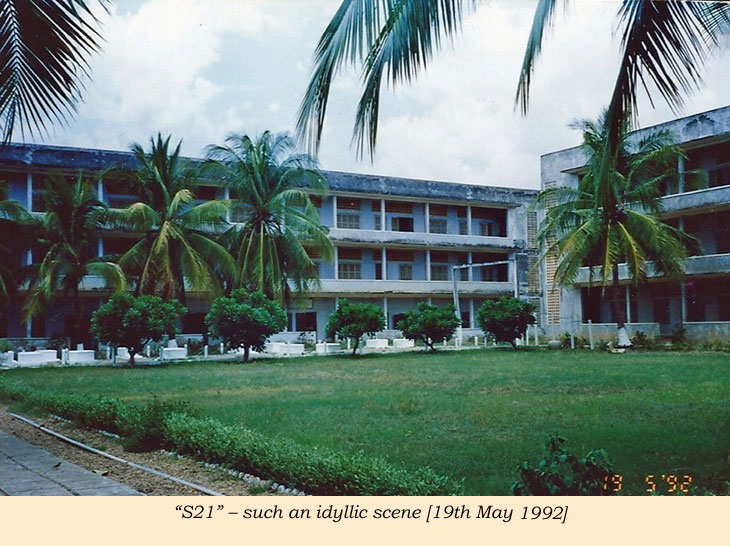
Notwithstanding the horrors of the Killing Fields and the indiscriminate sowing of land-mines throughout the country, the magnificence and grandeur of the 12th/13th Century Bayon/Angkor complexes was overwhelming; yet there were moments when our up-country MovDet personnel must have questioned our raison d’être, as they were often called upon to be ‘tour guides’. And, alas it is in more recent times that as the area has been successfully cleared of landmines, it has opened up for the modern blight: tourism. Perhaps the intervention of UNESCO and other worthy archaeological organisations will ensure its’ longevity.
Conclusion That the UN’s Elections were held in May ’93, in relative security and peace is in no small part a testament to the efforts of the Australian Movement Control Group personnel, whose adaptability and enthusiasm ensured the best results from the multi- modal transport assets available, in spite of the ‘dog in the manger’ attitude of many of the Mission Contributors’; in particular the RAAF Members, who were able to bludgeon their Air Movements skills into the daily operations, were of primary importance. Those skills and doctrinal inputs are evident in current Peacekeeping Missions, some of which now have ex-MCG UNTAC personnel in executive appointments.
Conclusion That the UN’s Elections were held in May ’93, in relative security and peace is in no small part a testament to the efforts of the Australian Movement Control Group personnel, whose adaptability and enthusiasm ensured the best results from the multi- modal transport assets available, in spite of the ‘dog in the manger’ attitude of many of the Mission Contributors’; in particular the RAAF Members, who were able to bludgeon their Air Movements skills into the daily operations, were of primary importance. Those skills and doctrinal inputs are evident in current Peacekeeping Missions, some of which now have ex-MCG UNTAC personnel in executive appointments.
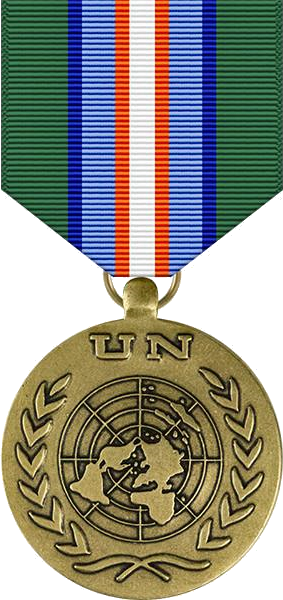
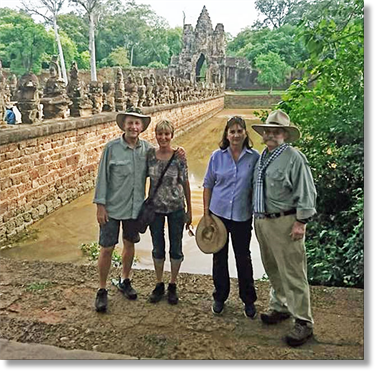
The Author and Neil Collie took our partners to Cambodia during May of 2017, as a 25th Anniversary of our deployment commemorative visit, and we were overwhelmed by the growth and commercialization of almost every aspect of the country's past.

Tactical Grey is the New Yellow
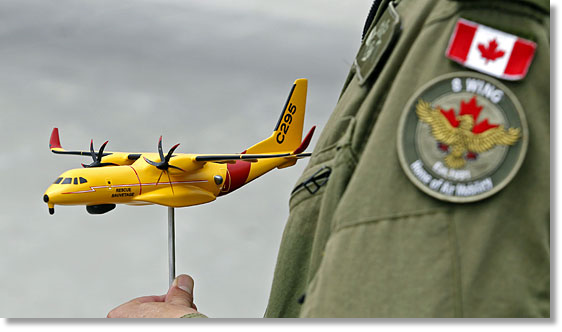
For Canada's search-and-rescue planes, 'tactical grey' is the new yellow. That could mean they're heading to combat
Canada’s new search-and-rescue aircraft will abandon their familiar yellow paint scheme, instead getting a makeover that will allow them to be used in other missions, including combat.
The Royal Canadian Air Force has requested that its new fleet of 16 search-and-rescue planes be painted tactical grey and have asked for a change in the original contract which stipulated a yellow colour scheme.
The C-295W, being built by Airbus, will replace the main search-and-rescue fleet of six Buffalo aircraft as well as the Hercules transport planes which are also used at times in a search-and-rescue role. The Buffalos are painted yellow, as are Canada’s other fully dedicated search-and-rescue aircraft such as the Cormorant helicopters.
“The RCAF has made the decision to use a grey colour scheme for the C-295W fleet to enable surging flexibility for the very wide range of missions the RCAF is required to conduct, from humanitarian and disaster relief missions, to security missions with partners, and all the way to full spectrum operations,” Department of National Defence spokesman Daniel Le Bouthillier said Thursday.
National Post
Canada’s new search-and-rescue aircraft will abandon their familiar yellow paint scheme, instead getting a makeover that will allow them to be used in other missions, including combat.
The Royal Canadian Air Force has requested that its new fleet of 16 search-and-rescue planes be painted tactical grey and have asked for a change in the original contract which stipulated a yellow colour scheme.
The C-295W, being built by Airbus, will replace the main search-and-rescue fleet of six Buffalo aircraft as well as the Hercules transport planes which are also used at times in a search-and-rescue role. The Buffalos are painted yellow, as are Canada’s other fully dedicated search-and-rescue aircraft such as the Cormorant helicopters.
“The RCAF has made the decision to use a grey colour scheme for the C-295W fleet to enable surging flexibility for the very wide range of missions the RCAF is required to conduct, from humanitarian and disaster relief missions, to security missions with partners, and all the way to full spectrum operations,” Department of National Defence spokesman Daniel Le Bouthillier said Thursday.
National Post

From: Douglas Stewart, Stouffville, ON
Subject: Membership Application
Hi Tony,
Thanks for your response to my Membership Application and the additional info you sent re your organization.
I guess I served in Air Movements during my time in the RAF, although I don't recall that exact term. Suffice to say that it involved ordering and distributing supplies. At the small stations, including Salalah, it also involved loading and unloading aircraft, only one a week, and generally running the "Stores". Prior to Salalah, I spent about 8 months at Khormaksar in Aden.
Later in my service I was posted to Shallufa in Egypt (Canal Zone) before spending a short time in Palestine, then returning home in 1948.
All seems long ago now, but I still have old b/w photos of those days. Salalah, above all, left a lasting impression on me that has remained the rest of my life; it was a million miles from my working class background in London, while growing up.
I recently turned age 90. Looking back, I would not have missed the experience.
Regards,
Doug Stewart
Subject: Membership Application
Hi Tony,
Thanks for your response to my Membership Application and the additional info you sent re your organization.
I guess I served in Air Movements during my time in the RAF, although I don't recall that exact term. Suffice to say that it involved ordering and distributing supplies. At the small stations, including Salalah, it also involved loading and unloading aircraft, only one a week, and generally running the "Stores". Prior to Salalah, I spent about 8 months at Khormaksar in Aden.
Later in my service I was posted to Shallufa in Egypt (Canal Zone) before spending a short time in Palestine, then returning home in 1948.
All seems long ago now, but I still have old b/w photos of those days. Salalah, above all, left a lasting impression on me that has remained the rest of my life; it was a million miles from my working class background in London, while growing up.
I recently turned age 90. Looking back, I would not have missed the experience.
Regards,
Doug Stewart

How to get a five-tonne snowblower to the Arctic
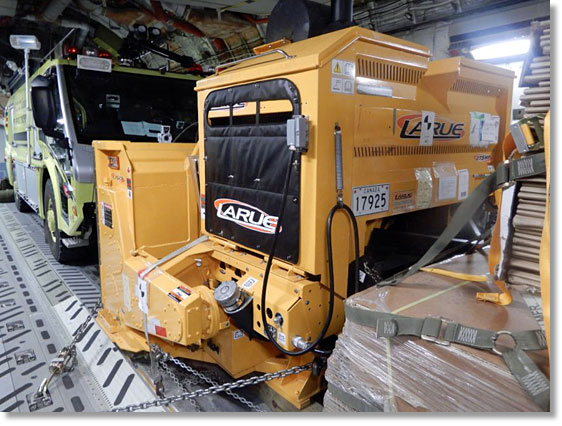
The fire truck and snowblower, pictured in Thule, Greenland. The ropes and wires attached ensured they hardly jiggled in the Globemaster plane. JOHN HODERICH / TORONTO STAR
When Canada provides aid to typhoon-stricken Philippines and gets there before anyone else, who does it? Or brings our renowned water-purification team plus helicopter to earthquake-ravaged Nepal? Or brings supplies to Canadian troops in Afghanistan? Or brings hurricane relief to devastated Texas? Or, on a more mundane level, brings a new fire truck and snowblower to the northernmost settlement on the planet? The answer to all? The 429 Transport Squadron of the Royal Canadian Air Force.
The 429 members aren’t the ones you see in action in areas of mass destruction. Rather, they are the unsung heroes whose sole job is to get the transportation part done — quickly and efficiently. Based in Trenton, Ont., their theatre is the world. They are ready to go whenever the need arrives and usually on very short notice. And they’re always prepared for “snags” — militarese for malfunctions and screw-ups. They go with the job, or as Sgt. Patryk Wegrzyn told me “a chance for us to really prove ourselves.”
For four days, I had the opportunity to watch one crew up close as they delivered that fire truck and snowblower to Alert, Nunavut, on the northernmost tip of Ellesmere Island. I was officially checked in as part of the crew, though insisting on paying my own expenses and accommodation. I would be with them from the usual breakfast at 6 a.m. until the “social” at night which, by rule, shut down completely 12 hours before next takeoff.
The 429 members aren’t the ones you see in action in areas of mass destruction. Rather, they are the unsung heroes whose sole job is to get the transportation part done — quickly and efficiently. Based in Trenton, Ont., their theatre is the world. They are ready to go whenever the need arrives and usually on very short notice. And they’re always prepared for “snags” — militarese for malfunctions and screw-ups. They go with the job, or as Sgt. Patryk Wegrzyn told me “a chance for us to really prove ourselves.”
For four days, I had the opportunity to watch one crew up close as they delivered that fire truck and snowblower to Alert, Nunavut, on the northernmost tip of Ellesmere Island. I was officially checked in as part of the crew, though insisting on paying my own expenses and accommodation. I would be with them from the usual breakfast at 6 a.m. until the “social” at night which, by rule, shut down completely 12 hours before next takeoff.
The task ahead was one of the squadron’s regular jobs: Operation BOXTOP. Keep the military’s most northern outpost serviced and supplied. Hence the lime-coloured fire truck. The old one got smashed in an icy pileup. The journey began on a Monday at 5:30 a.m. We gathered at CFB Trenton for the short van ride to the giant Globemaster aircraft. Capt. Sean Bassett, a no-nonsense, thoroughly professional leader, laid out the mission in staccato tones: Deliver the goods to Alert, drop off some people and attempt five “chalks” (trips) with fuel from Thule Air Base in Greenland to Alert. But he warned weather could be a big factor. To the rest of the seven-person crew, this seemed like business as usual.
CFB Trenton prides itself as being “the hub of air mobility.” As I was told often, “if you want boots on the ground, this is where you start.” And the huge CC-177 Globemaster III is the workhorse for the squadron. It is a beast. Each of its four jet engines has 18,343 kilograms of thrust. It is almost 17 metres high inside, can carry 110,676 kilograms of fuel and has a range of 10,186 kilometres. Our first destination was Thule, the sprawling U.S. air force base three-quarters the way up the west coast of Greenland. Situated 1,200 kilometres north of the Arctic Circle, it provides an ideal refuelling stop for the Globemasters en route to Alert. Yet there is a catch. You can only land between 8 a.m. and 4 p.m., Monday to Friday. All weekend it is shut. It seems the Americans have outsourced management of the base to local Greenlanders and they operate the base on old banking hours. God forbid anything untoward happens on weekends. This turned out to be a big factor on our mission.
The task of loading the Globemaster with the fire truck, the snowblower and all the other food and goods is the responsibility of the loadmaster. Our loadmaster was Sgt. Marie-Pierre Tremblay, as direct, plain spoken and confident as you can imagine. “I love my job. I have a real passion for it,” she told me right up front. “And I’m very good at it.”
The total weight of our cargo was 34,473 kilograms, and it was her responsibility to make sure it was distributed evenly for takeoff, securely tied down and kept perfectly intact. “This is a real science,” explained Wegrzyn, who was along to do the annual “flight check” of his colleague Tremblay. “You have to make sure everything is put in exactly the right place.”
My pull-down seat on the fuselage of the Globemaster was beside the fire truck, to which I became quite attached. I can assure you it hardly jiggled the entire trip. And the ropes and guy wires holding it in place were checked regularly by Tremblay and her trainee, Master Cpl. James Brown. It turned out landing in Thule was no problem, and so our first leg was completed as planned.
Then I got my first Arctic lesson. “Make sure you bring your bag back here every day,” co-pilot Maj. Pierre-Luc Verreault told me. “You never know where we might be forced to land. Goose Bay, Fro Bay (Iqaluit) or wherever!” My second lesson came as we checked into the North Star Inn on the base. The hardbitten clerk warned us the winds were becoming so strong there might be a “lockdown.” That meant no one could leave the building.
The North Star is a military-style hotel — shared washroom and showers, with men on the second floor and women on the first. Despite the lockdown threat, we were able to head out to the mess for dinner, walking past a cluster of arctic foxes or “archies” as the locals call them. At $5.07, the price for dinner was a bargain and the food was surprisingly good. But not a drop of alcohol was to be found.
CFB Trenton prides itself as being “the hub of air mobility.” As I was told often, “if you want boots on the ground, this is where you start.” And the huge CC-177 Globemaster III is the workhorse for the squadron. It is a beast. Each of its four jet engines has 18,343 kilograms of thrust. It is almost 17 metres high inside, can carry 110,676 kilograms of fuel and has a range of 10,186 kilometres. Our first destination was Thule, the sprawling U.S. air force base three-quarters the way up the west coast of Greenland. Situated 1,200 kilometres north of the Arctic Circle, it provides an ideal refuelling stop for the Globemasters en route to Alert. Yet there is a catch. You can only land between 8 a.m. and 4 p.m., Monday to Friday. All weekend it is shut. It seems the Americans have outsourced management of the base to local Greenlanders and they operate the base on old banking hours. God forbid anything untoward happens on weekends. This turned out to be a big factor on our mission.
The task of loading the Globemaster with the fire truck, the snowblower and all the other food and goods is the responsibility of the loadmaster. Our loadmaster was Sgt. Marie-Pierre Tremblay, as direct, plain spoken and confident as you can imagine. “I love my job. I have a real passion for it,” she told me right up front. “And I’m very good at it.”
The total weight of our cargo was 34,473 kilograms, and it was her responsibility to make sure it was distributed evenly for takeoff, securely tied down and kept perfectly intact. “This is a real science,” explained Wegrzyn, who was along to do the annual “flight check” of his colleague Tremblay. “You have to make sure everything is put in exactly the right place.”
My pull-down seat on the fuselage of the Globemaster was beside the fire truck, to which I became quite attached. I can assure you it hardly jiggled the entire trip. And the ropes and guy wires holding it in place were checked regularly by Tremblay and her trainee, Master Cpl. James Brown. It turned out landing in Thule was no problem, and so our first leg was completed as planned.
Then I got my first Arctic lesson. “Make sure you bring your bag back here every day,” co-pilot Maj. Pierre-Luc Verreault told me. “You never know where we might be forced to land. Goose Bay, Fro Bay (Iqaluit) or wherever!” My second lesson came as we checked into the North Star Inn on the base. The hardbitten clerk warned us the winds were becoming so strong there might be a “lockdown.” That meant no one could leave the building.
The North Star is a military-style hotel — shared washroom and showers, with men on the second floor and women on the first. Despite the lockdown threat, we were able to head out to the mess for dinner, walking past a cluster of arctic foxes or “archies” as the locals call them. At $5.07, the price for dinner was a bargain and the food was surprisingly good. But not a drop of alcohol was to be found.
The following morning, we gathered at 5 a.m. for a $2.03 breakfast, all eager to get going. But as the pilots went through their checklists, they discovered one of the electronic boxes in the cockpit wasn’t working. Now what? We couldn’t take off and the talk was of having Trenton fly up a new box, forcing us, of course, to wait. Would it be one day? Would it be two?
Then suddenly the machinist of the crew, Cpl. Don Gunawardena, remembered there was a spare container of Globemaster parts in one of the hangars. He and his delightful mate, electrician Master Cpl. Mike Gagne, rummaged through as we all watched. And voila, they found a spare box! In no time flat it was installed and we were off to Alert. We travelled over the spectacular Quttinirpaaq National Park, catching sight of Barbeau Peak, the highest mountain in Eastern Canada. By now it was midday and the light was as good as a late October could offer.
Landing at Alert is a challenge, whenever. At 1,676 metres, the gravel runway offers precious little room for error. For most of the year, the runway is ice-slick and as pilot Bassett told us, “planes can slide just like cars.” It seems the reverse engine thrusters do most of the stopping. The approach comes from right over the Arctic Ocean and buffeting crosswinds are the norm. The ceiling has to be 152 metres, and as we experienced, that can vary from minute to minute. There is a “box” at the start of the runway in which the pilots know they have to land to guarantee room to stop.
In the cockpit, the tension is palpable as the approach is made. In the dark gloom, the only light comes from the runway lights, which can be turned way up. I saw each pilot do this landing and as one might expect, each nailed it. But both times, it was an exercise in aviation precision to behold.
Once on the ground, all the crates and boxes were swiftly unloaded. The real challenge came with the nearly five-tonne snowblower, which was on its own pallet. It wouldn’t budge. The entire crew, plus a few hands from Alert, had to lend a strong shoulder. Then the moment of satisfaction came. The fire engine driver from Alert turned the key, and with red lights blaring, drove the truck from the Globemaster onto the icy gravel tarmac in minus-23 degree weather. Mission accomplished. There were no high-fives or unusual remarks, only the collective quiet satisfaction of getting the job done. They’d all experienced this before.
Shortly thereafter, we took off for Thule. The plan had been to do another “chalk” to Alert with fuel that afternoon. But the time spent earlier on repairs meant we couldn’t do a return trip and make the 4 p.m. closing time at Thule. So, we got off early.
The drill repeated itself the following day and we took off, loaded with fuel. This time the cloud ceiling at Alert wouldn’t allow a landing, so we were forced to circle for quite some time. Suddenly we got a break, and with crosswinds howling, co-pilot Verreault strutted his stuff. The fuel was pumped out quickly, but once again, a second planned fuel trip had to be scrubbed for we couldn’t guarantee making Thule’s 4 p.m. closing time. Again, no one seemed bothered. After all, this is the Arctic. On the way back, however, the pilots discovered a de-icing problem with engine No. 4. A valve was malfunctioning and despite all their manoeuvres, they couldn’t get it to operate properly.
Then suddenly the machinist of the crew, Cpl. Don Gunawardena, remembered there was a spare container of Globemaster parts in one of the hangars. He and his delightful mate, electrician Master Cpl. Mike Gagne, rummaged through as we all watched. And voila, they found a spare box! In no time flat it was installed and we were off to Alert. We travelled over the spectacular Quttinirpaaq National Park, catching sight of Barbeau Peak, the highest mountain in Eastern Canada. By now it was midday and the light was as good as a late October could offer.
Landing at Alert is a challenge, whenever. At 1,676 metres, the gravel runway offers precious little room for error. For most of the year, the runway is ice-slick and as pilot Bassett told us, “planes can slide just like cars.” It seems the reverse engine thrusters do most of the stopping. The approach comes from right over the Arctic Ocean and buffeting crosswinds are the norm. The ceiling has to be 152 metres, and as we experienced, that can vary from minute to minute. There is a “box” at the start of the runway in which the pilots know they have to land to guarantee room to stop.
In the cockpit, the tension is palpable as the approach is made. In the dark gloom, the only light comes from the runway lights, which can be turned way up. I saw each pilot do this landing and as one might expect, each nailed it. But both times, it was an exercise in aviation precision to behold.
Once on the ground, all the crates and boxes were swiftly unloaded. The real challenge came with the nearly five-tonne snowblower, which was on its own pallet. It wouldn’t budge. The entire crew, plus a few hands from Alert, had to lend a strong shoulder. Then the moment of satisfaction came. The fire engine driver from Alert turned the key, and with red lights blaring, drove the truck from the Globemaster onto the icy gravel tarmac in minus-23 degree weather. Mission accomplished. There were no high-fives or unusual remarks, only the collective quiet satisfaction of getting the job done. They’d all experienced this before.
Shortly thereafter, we took off for Thule. The plan had been to do another “chalk” to Alert with fuel that afternoon. But the time spent earlier on repairs meant we couldn’t do a return trip and make the 4 p.m. closing time at Thule. So, we got off early.
The drill repeated itself the following day and we took off, loaded with fuel. This time the cloud ceiling at Alert wouldn’t allow a landing, so we were forced to circle for quite some time. Suddenly we got a break, and with crosswinds howling, co-pilot Verreault strutted his stuff. The fuel was pumped out quickly, but once again, a second planned fuel trip had to be scrubbed for we couldn’t guarantee making Thule’s 4 p.m. closing time. Again, no one seemed bothered. After all, this is the Arctic. On the way back, however, the pilots discovered a de-icing problem with engine No. 4. A valve was malfunctioning and despite all their manoeuvres, they couldn’t get it to operate properly.
The diagnosis was simple: a new valve was needed. And there wasn’t one in Thule. Bassett contacted Trenton and after a series of back-and-forths, it was decided a spare valve would be flown up to Thule the next day on a Challenger. A seasoned engine mechanic was also flown up to supervise the very tricky repair. Paradoxically, the crew of that Challenger thought they would be spending the day training for a medical evacuation in southern Ontario. Instead, they ended up in freezing Thule, some of them in summer wear. And they drew the ire of the Thule base team, complaining overtime would have to be paid because of the Challenger’s 4:10 p.m. departure back to Ottawa!
But the valve was successfully installed, and after early morning testing, the Globemaster took off for Alert for the final “chalk” of the mission. Five planned. Three completed. All in a week’s work, they told me often. Nothing unusual. Right! Which is why they are such unsung heroes.
[John Honderich is the chair of Torstar, the Toronto Star’s parent company.]
thestar.com
But the valve was successfully installed, and after early morning testing, the Globemaster took off for Alert for the final “chalk” of the mission. Five planned. Three completed. All in a week’s work, they told me often. Nothing unusual. Right! Which is why they are such unsung heroes.
[John Honderich is the chair of Torstar, the Toronto Star’s parent company.]
thestar.com
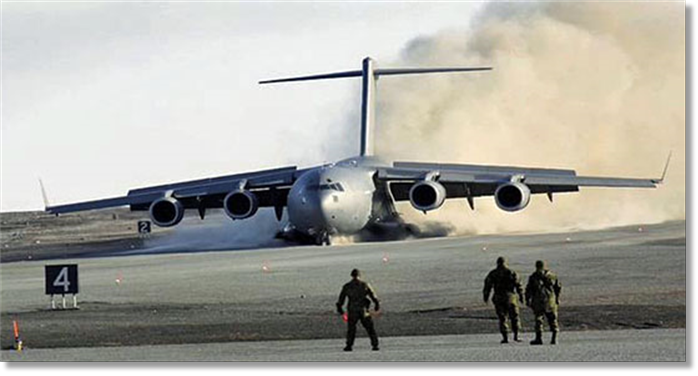

New members who have joined us recently are:
Doug Stewart, Stouffville, ON
Neil Collie, Canberra, ACT
Nigel Moore, Devauden, Mon
George Wood, Johannesburg
Paul Mansfield, Farnborough, Hants
Welcome to the OBA!

History lands with DC3
A Douglas DC3 from ‘Fly DC3’ in Auckland landed with a group of 20 visitors on board, who plan to sample the delights of Gisborne before flying home again on Sunday.
At one time DC3 passenger aircraft flew daily in and out of Gisborne, and yesterday morning it happened again. The vintage aircraft flew round the Cape from the BOP and at a low level down the East Coast to give the visitors a close up aerial view. Some charter flights will be flown over the district before the aircraft leaves here tomorrow, November 18.
The Gisborne Herald
At one time DC3 passenger aircraft flew daily in and out of Gisborne, and yesterday morning it happened again. The vintage aircraft flew round the Cape from the BOP and at a low level down the East Coast to give the visitors a close up aerial view. Some charter flights will be flown over the district before the aircraft leaves here tomorrow, November 18.
The Gisborne Herald
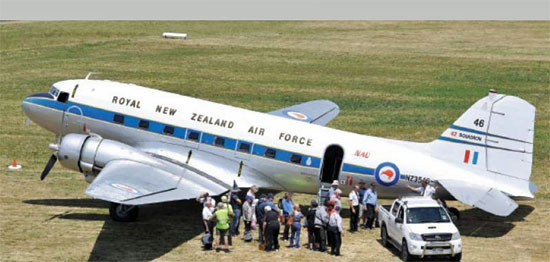

Bristol Freighter on its way to England
AUCKLAND NEW ZEALAND October 13, 2017. A former Royal New Zealand Air Force Bristol Freighter Aircraft, NZ 5911, was moved from Ardmore Airport to Ports of Auckland for shipment to the Aerospace Bristol Aircraft Museum England on October 16, 2017.

From: Mike Stepney, Glasgow, North Lanarkshire
Subject: RAFA Befriender
Hi Tony,
I wonder if any of your readers who reside in the UK would be interested in assisting the Royal Air Force Association in becoming a RAFA Befriender.
The role of Befriender has recently been introduced by RAFA; it acts as a link between ex RAF service personnel (anyone serving or who has served in the RAF, Regular or Reserve, their respective partner, spouse and/or dependent children), and the RAFA support organization. Organized on a UK regional basis, it is currently supported by mostly ex RAF personnel, but being ex RAF is not a prerequisite to becoming a RAFA Befriender, anyone who is interested in assisting ex RAF personnel from a welfare standpoint can apply to become a Befriender.
There are a number of external checks conducted to ensure that Befrienders are suitable and trustworthy to undertake the role, as in many cases they will be dealing with vulnerable adults. These checks are quite straightforward and consist of two independent references (that are nominated by the applicant), and a PVG check. All the required checks are undertaken/administered by RAFA. After passing scrutiny, individuals are assigned a training course (one day) before they are formally accepted and assigned to a (their) region.
• Any and all expenses incurred are promptly settled by RAFA direct. • An ID card is issued to Befrienders to enable formal identification when necessary. • Befrienders are allocated beneficiaries (‘clients’) by the RAFA Area Welfare Officer (AWO) or by a dedicated RAFA Caseworker.
Clients can be identified by various methods such as: ‘someone has contacted RAFA and identified an ex RAF individual in need of assistance’, or ‘someone has been identified by another charity as being ex RAF and would benefit from a visit by RAFA’. The AWO assess the requirement then passes the details to the Befriender. Visits to clients can take place in the clients home or a mutually agreed location, and the Befriender will find shared interests or have topics in mind to chat to the client. Befriender services may also take place over the phone in a bid to keep the client engaged in social interactions.
Befriender monthly activity is minimal, with about 2 or 3 hours a month required however, that time can make a considerable difference to someone who is lonely and just needs to talk to someone about the Service in general, and their time in uniform.
Befriender volunteers report monthly via their Area (or assistant) Welfare Officer (AWO). • RAFA supplies all the necessary support forms and documents required to undertake the role of Befriender.
More information on this worthwhile volunteer program here: https://www.rafa.org.uk/befriending/
Thanks and Regards
Mike Stepney (RAFA Befriender)
Subject: RAFA Befriender
Hi Tony,
I wonder if any of your readers who reside in the UK would be interested in assisting the Royal Air Force Association in becoming a RAFA Befriender.
The role of Befriender has recently been introduced by RAFA; it acts as a link between ex RAF service personnel (anyone serving or who has served in the RAF, Regular or Reserve, their respective partner, spouse and/or dependent children), and the RAFA support organization. Organized on a UK regional basis, it is currently supported by mostly ex RAF personnel, but being ex RAF is not a prerequisite to becoming a RAFA Befriender, anyone who is interested in assisting ex RAF personnel from a welfare standpoint can apply to become a Befriender.
There are a number of external checks conducted to ensure that Befrienders are suitable and trustworthy to undertake the role, as in many cases they will be dealing with vulnerable adults. These checks are quite straightforward and consist of two independent references (that are nominated by the applicant), and a PVG check. All the required checks are undertaken/administered by RAFA. After passing scrutiny, individuals are assigned a training course (one day) before they are formally accepted and assigned to a (their) region.
• Any and all expenses incurred are promptly settled by RAFA direct. • An ID card is issued to Befrienders to enable formal identification when necessary. • Befrienders are allocated beneficiaries (‘clients’) by the RAFA Area Welfare Officer (AWO) or by a dedicated RAFA Caseworker.
Clients can be identified by various methods such as: ‘someone has contacted RAFA and identified an ex RAF individual in need of assistance’, or ‘someone has been identified by another charity as being ex RAF and would benefit from a visit by RAFA’. The AWO assess the requirement then passes the details to the Befriender. Visits to clients can take place in the clients home or a mutually agreed location, and the Befriender will find shared interests or have topics in mind to chat to the client. Befriender services may also take place over the phone in a bid to keep the client engaged in social interactions.
Befriender monthly activity is minimal, with about 2 or 3 hours a month required however, that time can make a considerable difference to someone who is lonely and just needs to talk to someone about the Service in general, and their time in uniform.
Befriender volunteers report monthly via their Area (or assistant) Welfare Officer (AWO). • RAFA supplies all the necessary support forms and documents required to undertake the role of Befriender.
More information on this worthwhile volunteer program here: https://www.rafa.org.uk/befriending/
Thanks and Regards
Mike Stepney (RAFA Befriender)



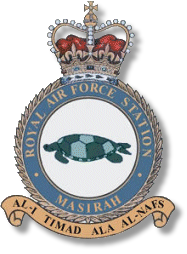
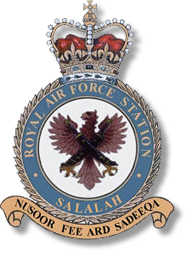
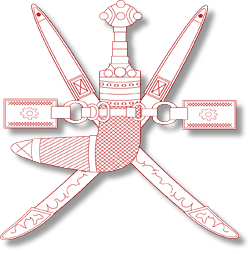

From: Basil Hughes, Pattaya
Subject: Memories of Oman
I was called-up on October 30, 1957 after serving my time as a shipwright's apprentice and had been craftily promised by the recruiting sergeant at Plymouth that if I signed on for three years I would be posted to the Marine section - he had lied.
I went through the trade evaluation process at Cardington in Bedordshire and then on to Bridgenorth in Shropshire for basic training. I do recall at one point we had been on an exercise, camping out in the snow, but I found an old barn with some hay in it! After the basic training I was sent to Kidbrooke in London to be trained as an Air Movements clerk.
My first posting was to the Load Control Office at RAF Wildenrath in Germany. Do you remember that calculator where you set the keys and turned a handle for the result? Then there were the Weight and Balance sheets - we even had to do one for the Pembroke - I never found out why.
I had been there about a month when the CO visited the barrack block announcing that six volunteers were wanted for active service. The qualifications were that we would be not married or engaged and both parents living. We had all had it drilled into us at Bridgenorth Never Volunteer - so he went away and came back with the Orderly Room sergeant and a pile of envelopes which appeared to contain our service records.
Six of us were volunteered, no excuses. We were taken straight down to Sick Quarters where the MO was waiting. There was no medical examination just injections in both arms and one in the back side. We were never told what they were for. We went back to our billet to pack our kit and get some sleep; the injections had made us all very drowsy.
At 6am we had breakfast and were each given a pack of sandwiches then we boarded a 3-tonner lorry to take us to the Hook of Holland where we caught a ferry to Harwich in the UK. We were met at the RTO office and put on a train for London and then another train to 5 PDU (Personnel Despatch Unit) at Innsworth in Gloucester. I cannot tell you how uncomfortable the train journeys were and trying to lug our kit bags after having had injections in both arms. We had to draw our bedding from the Bedding Store and after we got settled we went in search of food. The mess was closed so we found ourselves eating in the NAAFI. All of the following day was taken up with medical exams and filling out paperwork. We were all exhausted when we were finally able to get some sleep.
Subject: Memories of Oman
I was called-up on October 30, 1957 after serving my time as a shipwright's apprentice and had been craftily promised by the recruiting sergeant at Plymouth that if I signed on for three years I would be posted to the Marine section - he had lied.
I went through the trade evaluation process at Cardington in Bedordshire and then on to Bridgenorth in Shropshire for basic training. I do recall at one point we had been on an exercise, camping out in the snow, but I found an old barn with some hay in it! After the basic training I was sent to Kidbrooke in London to be trained as an Air Movements clerk.
My first posting was to the Load Control Office at RAF Wildenrath in Germany. Do you remember that calculator where you set the keys and turned a handle for the result? Then there were the Weight and Balance sheets - we even had to do one for the Pembroke - I never found out why.
I had been there about a month when the CO visited the barrack block announcing that six volunteers were wanted for active service. The qualifications were that we would be not married or engaged and both parents living. We had all had it drilled into us at Bridgenorth Never Volunteer - so he went away and came back with the Orderly Room sergeant and a pile of envelopes which appeared to contain our service records.
Six of us were volunteered, no excuses. We were taken straight down to Sick Quarters where the MO was waiting. There was no medical examination just injections in both arms and one in the back side. We were never told what they were for. We went back to our billet to pack our kit and get some sleep; the injections had made us all very drowsy.
At 6am we had breakfast and were each given a pack of sandwiches then we boarded a 3-tonner lorry to take us to the Hook of Holland where we caught a ferry to Harwich in the UK. We were met at the RTO office and put on a train for London and then another train to 5 PDU (Personnel Despatch Unit) at Innsworth in Gloucester. I cannot tell you how uncomfortable the train journeys were and trying to lug our kit bags after having had injections in both arms. We had to draw our bedding from the Bedding Store and after we got settled we went in search of food. The mess was closed so we found ourselves eating in the NAAFI. All of the following day was taken up with medical exams and filling out paperwork. We were all exhausted when we were finally able to get some sleep.
At 6am we had breakfast and were each given a pack of sandwiches then we boarded a 3-tonner lorry to take us to the Hook of Holland where we caught a ferry to Harwich in the UK. We were met at the RTO office and put on a train for London and then another train to 5 PDU (Personnel Despatch Unit) at Innsworth in Gloucester. I cannot tell you how uncomfortable the train journeys were and trying to lug our kit bags after having had injections in both arms.
We had to draw our bedding from the Bedding Store and after we got settled we went in search of food. The mess was closed so we found ourselves eating in the NAAFI. All of the following day was taken up with medical exams and filling out paperwork. We were all exhausted when we were finally able to get some sleep.
The next day we had a very early start, we were bussed to RAF Abingdon where we boarded a Hastings which seemed to stop everywhere before finally arriving at a place I had never heard of before, Khormaksar in Aden. We got a cooked dinner and settled down for the night in the transit billet. In the morning, after all of our paperwork was checked, we were split up into three pairs, each pair going to a different destination - my friend and I drew the short straws, heading for Sharjah in the Trucial Oman States.
Sand, sand and more sand, even the runway was sand and checked for mines each day by driving a Landrover along it while towing a railway tie. The food was mainly dehydrated and the only meat was corned beef in 7 lb cans. There was no bread (except in special circumstances), no beer at all and water for drinking was rationed - two bottles a day complete with a film of oil on top and some sand in the bottom. Air Movements only handled one aircraft twice a week when the rations came down from Bahrain.
I was drafted to work on Surface Movements as I was the oldest. Every night I was taken in a three-tonner to a little Arab port called Dubai where I was supposed to be in charge of a group of Arab labourers offloading 1,000 Lb bombs. They had been brought ashore from a ship by Arab dhows and had to be offloaded by a hand crane and swung on to three ton lorries. The bombs were for the Shackltons, we also transhipped rockets and ammo for the Venoms.
I understood that we were there by treaty and the treaty money was paid in gold - certainly there were gold sovereigns for sale in the market as well as Dutch silver coins. One laugh - though not so funny really - although not properly trained, sometimes we had to go out on armed patrol - The sheik's bodyguard escorted us -- they were much better armed than we were!
We had to draw our bedding from the Bedding Store and after we got settled we went in search of food. The mess was closed so we found ourselves eating in the NAAFI. All of the following day was taken up with medical exams and filling out paperwork. We were all exhausted when we were finally able to get some sleep.
The next day we had a very early start, we were bussed to RAF Abingdon where we boarded a Hastings which seemed to stop everywhere before finally arriving at a place I had never heard of before, Khormaksar in Aden. We got a cooked dinner and settled down for the night in the transit billet. In the morning, after all of our paperwork was checked, we were split up into three pairs, each pair going to a different destination - my friend and I drew the short straws, heading for Sharjah in the Trucial Oman States.
Sand, sand and more sand, even the runway was sand and checked for mines each day by driving a Landrover along it while towing a railway tie. The food was mainly dehydrated and the only meat was corned beef in 7 lb cans. There was no bread (except in special circumstances), no beer at all and water for drinking was rationed - two bottles a day complete with a film of oil on top and some sand in the bottom. Air Movements only handled one aircraft twice a week when the rations came down from Bahrain.
I was drafted to work on Surface Movements as I was the oldest. Every night I was taken in a three-tonner to a little Arab port called Dubai where I was supposed to be in charge of a group of Arab labourers offloading 1,000 Lb bombs. They had been brought ashore from a ship by Arab dhows and had to be offloaded by a hand crane and swung on to three ton lorries. The bombs were for the Shackltons, we also transhipped rockets and ammo for the Venoms.
I understood that we were there by treaty and the treaty money was paid in gold - certainly there were gold sovereigns for sale in the market as well as Dutch silver coins. One laugh - though not so funny really - although not properly trained, sometimes we had to go out on armed patrol - The sheik's bodyguard escorted us -- they were much better armed than we were!
Showers: salt water and the soap was big bars of yellow carbolic household soap, no lather. Beer: beer did arrive, but had to be deposited in a lock-up building near the Officers Mess, I helped unload it but never saw it again. Fresh veggies: all consigned to the Officers Mess. Pork: no pork or bacon or pork sausage, cans of beans and sausages were also banned. Breakfast: boiled eggs, corn flakes with powdered milk, no bread but hard tack biscuits. Lunch & Dinner: cottage pie made with corned beef and dehydrated potatoes with tinned veggies, tinned stew, dehydrated potatoes or canned potatoes. Tinned liver, dehydrated mashed potatoes (I leave a description of the liver to your imagination) Tinned fruit and tinned custard, biscuits and jam. Tea and coffee with reconstituted milk. Laundry: used salt water. Uniform very quickly was in no condition to wear but my gang at the port commented on this and after I took my washing down with me and the next night it came back looking immaculate at little cost.
Females: according to the MO a big No-No. According to my work group - no problem. Going round the market: again a big No-No but my work group taught me how to greet people and how to order coffee in the coffee house, how to bargain (always keep a smile on your face but do not laugh) and about personal contact.
As I was working nights, it was only on a Friday night that I did not have to work on Movements but the WO was very keen about idle hands so I spent that night on armoury guard with my trusty 12-bore.
On nights I was entitled to sandwiches, but the bread had to come down from Bahrain, and by the second day it was green with mould and much to the anger of the cook the MO decreed it was unfit to eat. Therefore I was entitled to a cooked meal before going down to the port which meant that the cook could not go to the cinema. It was the same film every night for one week but it was the only entertainment apart from the swimming pool which was a hole bulldozed out of the sand. Finally the cook used to leave a tin of bully beef for me which I took down to the port where the Arabs put it into the curry. So most nights I had curry and chapattis cooked over an open fire in a pot which resembled the wash tub my mother boiled the washing in.
There was no dentist on the camp and for treatment we would normally go down to Aden. I had problems with a broken tooth; a swinging hook on the crane had caught me square in the face. I consulted the MO who confessed that he had not removed a tooth since medical school. I couldn't go to Aden as I was classed as being on active service. The Arabs at the dock took me to see a dentist. I was horrified to see a bare room with just a rack of surgical instuments and a stool. The dentist spoke good English and showed me the other room and a surgery. As it turned out his treatment was excellent and the MO was very relieved.
Females: according to the MO a big No-No. According to my work group - no problem. Going round the market: again a big No-No but my work group taught me how to greet people and how to order coffee in the coffee house, how to bargain (always keep a smile on your face but do not laugh) and about personal contact.
As I was working nights, it was only on a Friday night that I did not have to work on Movements but the WO was very keen about idle hands so I spent that night on armoury guard with my trusty 12-bore.
On nights I was entitled to sandwiches, but the bread had to come down from Bahrain, and by the second day it was green with mould and much to the anger of the cook the MO decreed it was unfit to eat. Therefore I was entitled to a cooked meal before going down to the port which meant that the cook could not go to the cinema. It was the same film every night for one week but it was the only entertainment apart from the swimming pool which was a hole bulldozed out of the sand. Finally the cook used to leave a tin of bully beef for me which I took down to the port where the Arabs put it into the curry. So most nights I had curry and chapattis cooked over an open fire in a pot which resembled the wash tub my mother boiled the washing in.
There was no dentist on the camp and for treatment we would normally go down to Aden. I had problems with a broken tooth; a swinging hook on the crane had caught me square in the face. I consulted the MO who confessed that he had not removed a tooth since medical school. I couldn't go to Aden as I was classed as being on active service. The Arabs at the dock took me to see a dentist. I was horrified to see a bare room with just a rack of surgical instuments and a stool. The dentist spoke good English and showed me the other room and a surgery. As it turned out his treatment was excellent and the MO was very relieved.
The members of the Arab work force delighted in showing me around the market and I had a pair of silver earrings made for my mother and a ceremonial dagger for my father. I was taken to meet the Iman and actually got to read the Koran and a tattered copy in English was found for me in the camp library.
My friend and I had both contracted amoebic dysentery and had lost a lot of weight. Finally, orders came though for us to return to the UK. We flew up to Bahain but were unable to fly to the UK for a week as we were kept on the MO's orders and fed a special diet. We eventually arrived back in the UK and 5 PDU Innsworth. We were sent to see the MO there who in turn sent us both home for a month's sick leave.
I returned to Widenrath in Germany just after New Years 1958 and was told I had been promoted to SAC (it appears I was an LAC at Sharjah but did not know it). One month later I was promoted to local acting corporal and posted to RTO Stadt Altona, Hamburg. On my return to the UK I was sent on both a Surface Movements and an explosives course. On the latter I felt I had handled more explosives than the instructors but they found out that I was colour blind and should not have been anywhere near explosives!
Regards
Bas
My friend and I had both contracted amoebic dysentery and had lost a lot of weight. Finally, orders came though for us to return to the UK. We flew up to Bahain but were unable to fly to the UK for a week as we were kept on the MO's orders and fed a special diet. We eventually arrived back in the UK and 5 PDU Innsworth. We were sent to see the MO there who in turn sent us both home for a month's sick leave.
I returned to Widenrath in Germany just after New Years 1958 and was told I had been promoted to SAC (it appears I was an LAC at Sharjah but did not know it). One month later I was promoted to local acting corporal and posted to RTO Stadt Altona, Hamburg. On my return to the UK I was sent on both a Surface Movements and an explosives course. On the latter I felt I had handled more explosives than the instructors but they found out that I was colour blind and should not have been anywhere near explosives!
Regards
Bas
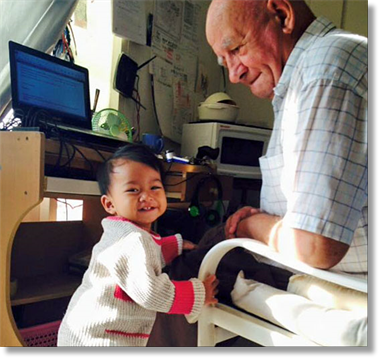

From: David Powell, Princes Risborough
Subject: Memories of Oman
Hi Tony
You may recall that I recounted some memories of Oman in a note included back in OBB #020911. This described one of Gulf MAMS primary tasks in 1971, namely the Argosy resupply runs from the old Oman airport at Bait al Falaj, with its kinky (3 degrees) main runway to fit the valley, down to Salalah, and the extremely quick turn rounds before ‘they’ could re-enter the previously swept area around the airfield by the so called cider drinking British Army Training Team to get within mortar or rocket range of our horseshoe of double-stacked sand-filled oil drums protecting the aircraft dispersal.
One additional memory, which I don’t think I have recounted before, was the tale I was told to me by a passenger, an ex-RAF armourer, prior to loading at Bait who was then working as a contractor for a certain aircraft services company. Initially he had been sent to work in Yemen, at what had been the old base at Khormaksar. His head office then decided his skills were needed on another contract in Oman at Salalah. However, at the time there was a slight difference of opinion about almost everything between the two countries, so he was shipped via various middle-east airports and countries on an extended circular route to his new place of work.
He was not a happy bunny. Shortly after first arriving at Salalah, the base had been the subject of a mortar attack, one of which landed not too far from him but which failed to go off. His reason for unhappiness was not so much at being attacked but that he recognized the missile as one he had prepared and packed 2 weeks previously! While he had been making his tortuous way via various airport terminals, his box of mortars had been taking a more direct route, presumably by camel! I never did establish if his unhappiness was in his fortunate lack of professionalism as an armourer or his unfortunate choice of employer.
Stay safe
David Powell
F Team UKMAMS 1967-69
Gulf MAMF 1971
Subject: Memories of Oman
Hi Tony
You may recall that I recounted some memories of Oman in a note included back in OBB #020911. This described one of Gulf MAMS primary tasks in 1971, namely the Argosy resupply runs from the old Oman airport at Bait al Falaj, with its kinky (3 degrees) main runway to fit the valley, down to Salalah, and the extremely quick turn rounds before ‘they’ could re-enter the previously swept area around the airfield by the so called cider drinking British Army Training Team to get within mortar or rocket range of our horseshoe of double-stacked sand-filled oil drums protecting the aircraft dispersal.
One additional memory, which I don’t think I have recounted before, was the tale I was told to me by a passenger, an ex-RAF armourer, prior to loading at Bait who was then working as a contractor for a certain aircraft services company. Initially he had been sent to work in Yemen, at what had been the old base at Khormaksar. His head office then decided his skills were needed on another contract in Oman at Salalah. However, at the time there was a slight difference of opinion about almost everything between the two countries, so he was shipped via various middle-east airports and countries on an extended circular route to his new place of work.
He was not a happy bunny. Shortly after first arriving at Salalah, the base had been the subject of a mortar attack, one of which landed not too far from him but which failed to go off. His reason for unhappiness was not so much at being attacked but that he recognized the missile as one he had prepared and packed 2 weeks previously! While he had been making his tortuous way via various airport terminals, his box of mortars had been taking a more direct route, presumably by camel! I never did establish if his unhappiness was in his fortunate lack of professionalism as an armourer or his unfortunate choice of employer.
Stay safe
David Powell
F Team UKMAMS 1967-69
Gulf MAMF 1971

From: David Stevens, Bangor
Subject: RAF Masirah 1971-1972
I was posted to RAF Masirah, as the OC Supply, from my provisioning job at the MOD Harrogate, Harlow Manor. There were a number of interesting events during my one-year tour which started in the September. In no particular order:
Subject: RAF Masirah 1971-1972
I was posted to RAF Masirah, as the OC Supply, from my provisioning job at the MOD Harrogate, Harlow Manor. There were a number of interesting events during my one-year tour which started in the September. In no particular order:
•
There was a coup in Muscat and Salalah and Qaboos, son of the ruler, Sultan Said bin Taimur, an ex-Sandhurst cadet, was flown into Masirah in an RAF Andover. He immediately imprisoned his father in the jail in Salalah. He brought his country into the 20th century.
•
There was the most almighty tropical storm that flooded the place, not least all my stores that were totally unsuited for such terrible weather! Write Offs were at AOC level. The Royal Engineers (REs) were tasked to plan and to construct a huge portable and flexible warehouse. It was not completed before my tourex so I do not have any pictures. But, one of the pictures that I have included shows the AOC AFME, and others, inspecting the ground work; one of four large holes in the ground!
•
I helped out as a part time broadcaster for Radio Masirah on the Sunday ‘Request from Home’ show.
•
The golf course was something else with golf balls ricocheting for miles.
•
I seem to remember that the OC Movements was one Bill Halford.
•
Masirah is one of only three or four places in the world where the sea turtle comes ashore to lay her eggs. It is such a huge effort for them that after digging the hole and laying hers eggs (usually at night) that they needed a helping hand the next morning to get back to the ocean. I can tell you that those turtles are mighty heavy!
•
A month or so later we then had to help the newly-born turtles get to the sea before all the various large birds swooped to catch them and have them ‘Al dente’ for lunch.
•
I tried to sail around the island single handed in an Osprey dinghy and failed.
•
It was on that doomed trip that I was escorted by a school of Dolphins that almost swamped the dinghy they swam that close to me.
•
I was also OC the Petrol Storage Depot (PSD) and I had to take a disciplinary charge on Boxing Day because a couple of my lads decided to do some time trials round the PSD perimeter in a Landrover and got caught ‘red handed’ by the FS in charge of the depot.
•
Interestingly, the MOD awarded a contract to Motherwell Construction to ‘raise’ the level of the existing storage tanks and so double our capacity. At the same time each tank was lined with epoxy resin. We kept a complete written and photographic record of this operation that took several months and cost the life of one worker. And just a couple of years ago I sent the whole package to The RAF Museum at Cosford.
•
There was a narrow gauge railway line between the landing jetty and the base. This was put to good use when the LSL re-supply vessels called in.
•
Of course, like many, I have my hand painted shellacked turtle shell.
•
Masirah was a stop-over for the BOAC long haul sea planes and the landing jetty on the leeward side of the island was still very much in evidence.
•
The locals slaughtered the crew of a ship that became wrecked on the northern coast in the late 19th century. The then ruler of Oman punished the locals by decreeing that all houses on the island were to be raised to the ground and that the locals could live only in whatever temporary accommodation they could build. This was the founding of oil drum city that was still very much in evidence in the 1970's.
•
Another slightly unusual responsibility for OC Supply was the Mobile Laundry; supplied and installed by the army, but managed and run by Indians.
•
HMS Ark Royal paid a courtesy visit and I, with many others, were invited on board but I have no recollection of how we got back to base; surprise, surprise!
•
RAF Salalah Supply Section was also part of my remit and on one of my trips there I witnessed ‘Green Archer’ radar at work when our resident troops opened fire on the Yemeni rebels somewhere out in the desert. The local wags reckoned that the army killed more camels than rebels! I also had to go into the underground shelter on the base when the rebels opened fire on us!


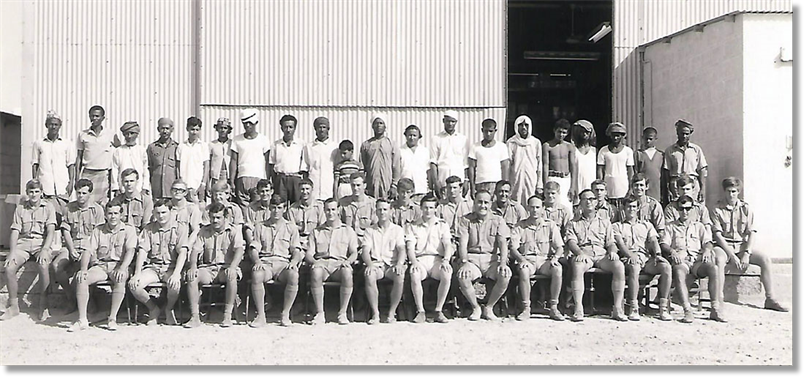
RAF Masirah Supply Squadron - 1971
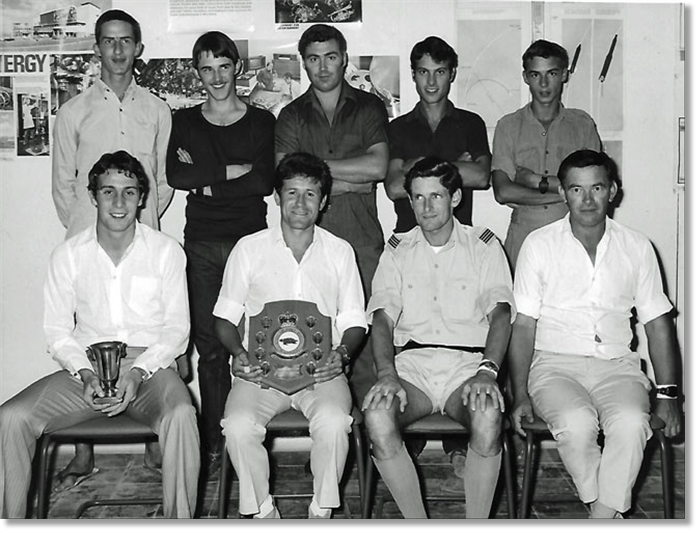
RAF Masirah Six-a-Side Football Champions - 1971
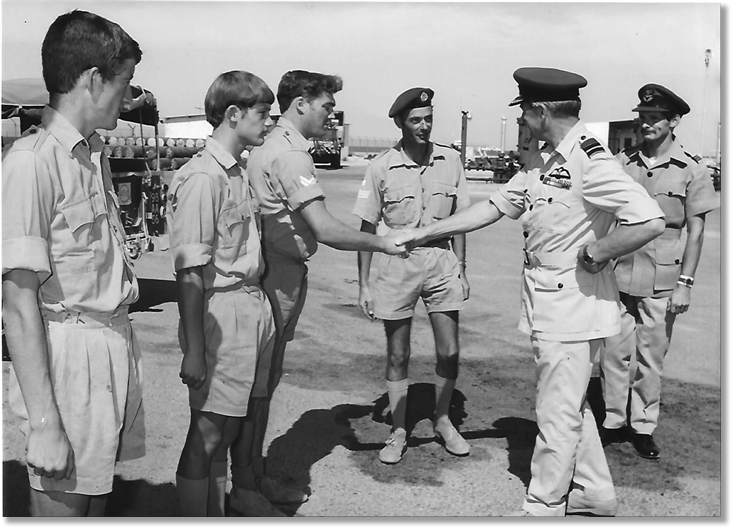
AOC's Inspection of the Masirah Petrol Storage Depot

RAF Masirah - AOC AFME inspecting the foundations for the new warehouse
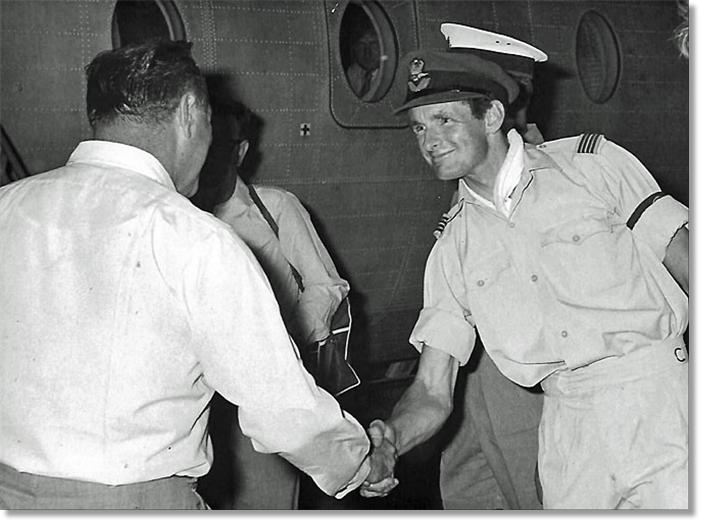
Yours truly saying farewell to the outgoing Commanding Officer, Wg Cdr Taylor
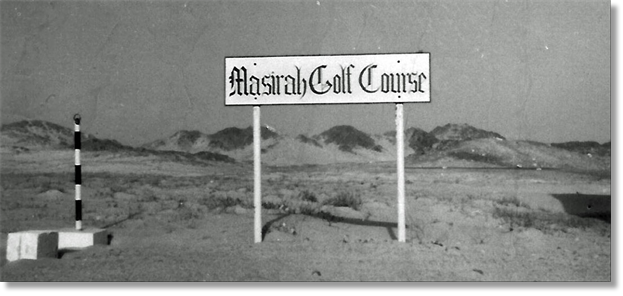
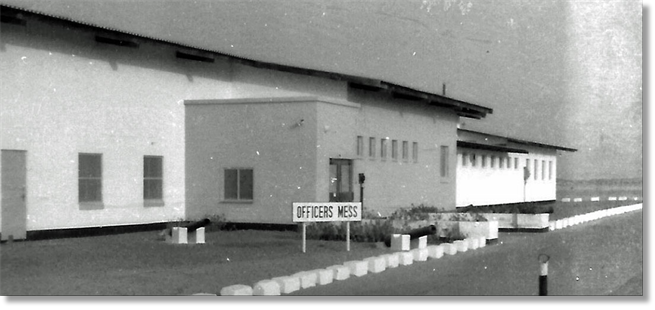

From: Tom Burrows, Sudbury, Suffolk
Subject: Memories of Masirah and Salalah
Hi Tony,
When I was at London Movements Unit I volunteered to go out to Masirah and Salalah on Reforce - it was right at the end of the RAF's time out there.
We were working with the RCT unloading and loading an RFA using their Mexeflotes. There were two memorable things that happened while I was there. One was the departure of the old train which was craned onto the Mexeflote and loaded on the RFA, does anyone know what happened to it?
The second thing was the closing down of the Sgts Mess at Masirah, where somehow or other we had to try and drink everything that was left behind the bar. I am not a big drinker but that night we had a good meal of barracuda steaks and quite a party. I am not sure how many remembered it the next morning, but sadly it was the end of an era.
I remember the frankincense tree in the mess compound at Salalah - an amazing perfume - something I had never seen before or since and only really knew about them from the Christmas carol. I know the local village elder used to come regularly and check that it was being looked after.
All the best,
Tom
Subject: Memories of Masirah and Salalah
Hi Tony,
When I was at London Movements Unit I volunteered to go out to Masirah and Salalah on Reforce - it was right at the end of the RAF's time out there.
We were working with the RCT unloading and loading an RFA using their Mexeflotes. There were two memorable things that happened while I was there. One was the departure of the old train which was craned onto the Mexeflote and loaded on the RFA, does anyone know what happened to it?
The second thing was the closing down of the Sgts Mess at Masirah, where somehow or other we had to try and drink everything that was left behind the bar. I am not a big drinker but that night we had a good meal of barracuda steaks and quite a party. I am not sure how many remembered it the next morning, but sadly it was the end of an era.
I remember the frankincense tree in the mess compound at Salalah - an amazing perfume - something I had never seen before or since and only really knew about them from the Christmas carol. I know the local village elder used to come regularly and check that it was being looked after.
All the best,
Tom
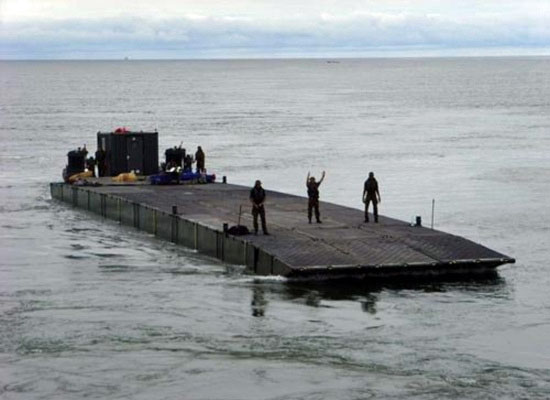

From: Keith Parker, Bowerhill, Wilts
Subject: Memories of Oman
I have many memories of Oman as I have spent a good many years of my life there, but here I’ll concentrate on the RAF years. It all began, as the story goes, in the early 70's. Harold Wilson had done his worst, RAF Stations were closing right left and centre, Khormaksar and El Adem were the latest. It was also at this time that The Sultan of Oman was getting a helping hand from the British forces in the guise of BATT (British Army Training Team) 22 SAS to the rest of the world.
The powers that be came up with bright idea of routing aircraft through Masirah on their way to the Far East. As I remember it, the Air Movements section comprised of 1 Officer Supply/Movs, a Sergeant and 6 Cpl/SACs. Later that was bolstered by about 6 TAG (Trade Assistant Generals). This is where MAMS came in, firstly NEAF MAMS and later UK MAMS were provided in the nature of 1 complete MAMS team per week.
Initially it was a bit of a mish-mash, but later it settled down into MAMS doing the Bait shuttle between Salalah – Bait Al Falaj and numerous places in the Bondu. At first we fitted in, as Movers do, gradually integrating with the rest of the camp. Eventually it was realised that NEAF MAMS had other uses and we used to supply the whole Camp with Demijohns of Brandy/Wine, Sheepskin Rugs, but most popular were crisps for all of the bars! This part of my Oman story came to an end when I was posted back to the UK.
Subject: Memories of Oman
I have many memories of Oman as I have spent a good many years of my life there, but here I’ll concentrate on the RAF years. It all began, as the story goes, in the early 70's. Harold Wilson had done his worst, RAF Stations were closing right left and centre, Khormaksar and El Adem were the latest. It was also at this time that The Sultan of Oman was getting a helping hand from the British forces in the guise of BATT (British Army Training Team) 22 SAS to the rest of the world.
The powers that be came up with bright idea of routing aircraft through Masirah on their way to the Far East. As I remember it, the Air Movements section comprised of 1 Officer Supply/Movs, a Sergeant and 6 Cpl/SACs. Later that was bolstered by about 6 TAG (Trade Assistant Generals). This is where MAMS came in, firstly NEAF MAMS and later UK MAMS were provided in the nature of 1 complete MAMS team per week.
Initially it was a bit of a mish-mash, but later it settled down into MAMS doing the Bait shuttle between Salalah – Bait Al Falaj and numerous places in the Bondu. At first we fitted in, as Movers do, gradually integrating with the rest of the camp. Eventually it was realised that NEAF MAMS had other uses and we used to supply the whole Camp with Demijohns of Brandy/Wine, Sheepskin Rugs, but most popular were crisps for all of the bars! This part of my Oman story came to an end when I was posted back to the UK.
To my surprise I was posted to Masirah in ’76 for the close-down of the station, it being handed back to the Sultan of Oman's Armed Forces (SOAF). Movements had OC Supply & Movements as its head, but was run by WO Bas Shatford, a lovely man, ex UK MAMS; the troops would have followed him anywhere. His 2 i/c whose name escapes me, got his promotion to FS on posting to Masirah. So we all got on well.
As you can imagine, there was loads of work and we had plenty of time off to pursue other activities. I spent most of my time on Radio 65, Masirah’s very own radio station. I had a show on Saturdays and a late night show on Thursdays. I won’t say whether it was good or bad, but we had a lot of fun doing them and it helped me get a job on Hospital Radio on my return to the UK.
Phil Smith and I came back on the last Herc and with us we brought the Bar out of “The Gulf Rovers Return” which ended up in MAMS Eng. at Lyneham as their tea bar. So that was it, Masirah and Oman finally gone, never to see them again.
How wrong could I be - 26 years later I would be back as a civvy and would stay for 10 years, but that’s another story!
Cheers
Keith
As you can imagine, there was loads of work and we had plenty of time off to pursue other activities. I spent most of my time on Radio 65, Masirah’s very own radio station. I had a show on Saturdays and a late night show on Thursdays. I won’t say whether it was good or bad, but we had a lot of fun doing them and it helped me get a job on Hospital Radio on my return to the UK.
Phil Smith and I came back on the last Herc and with us we brought the Bar out of “The Gulf Rovers Return” which ended up in MAMS Eng. at Lyneham as their tea bar. So that was it, Masirah and Oman finally gone, never to see them again.
How wrong could I be - 26 years later I would be back as a civvy and would stay for 10 years, but that’s another story!
Cheers
Keith

From: Robert Pountney, Forres, Moray
Subject: Memories of Masirah and Salalah
Hi Tony,
Masirah - In 1967, during my time as a Supplier, I was posted to Masirah but blagged my way onto Air Movements instead of SCAF as the SEO intended.
I soon encountered my first Air Quartermaster (AQM) and decided that was the career I wanted, and as soon as possible. I was hoping I would be short-toured after going to the Aircrew Selection Centre at Biggin Hill; no such luck. I passed the selection and returned to Masirah to complete my tour, which I quite enjoyed, even though, as a very small section, we had to work every aircraft day and night, but working with a great team made up for it.
My abiding memory is taking our local Omani Bedu labourers back to their homes in the Wali Camp after work. When I say homes, they were actually rusty 45 gallon drums stacked two or three high, roofs made of whatever could be found and sand floors but always hospitable and friendly. Their generosity extended to the customary dish of dates, always crawling with flies, and a cup of very sweet chai to wash them down.
Sick Quarters or Air Traffic Control were the places to go as they were air-conditioned •Bondu bashing down to Surf Beach always accompanied by one persistent fly which evaded all attempts to swat •Watching the turtles laying eggs on the beach, taking visiting crews there by Landrover, getting trapped by the soft sand and getting caught by the MTO who appeared like something out of Lawrence of Arabia •Getting sick of barracuda steaks and crayfish tails in the mess •Salt water showers and special soap sold in the NAAFI to enable a lather •Being at the bottom of the Gozome Chart and watching your painfully slow progress to the top and then the Argosy ride to Muharraq and home •A film change every two days at the Astra cinema.
Subject: Memories of Masirah and Salalah
Hi Tony,
Masirah - In 1967, during my time as a Supplier, I was posted to Masirah but blagged my way onto Air Movements instead of SCAF as the SEO intended.
I soon encountered my first Air Quartermaster (AQM) and decided that was the career I wanted, and as soon as possible. I was hoping I would be short-toured after going to the Aircrew Selection Centre at Biggin Hill; no such luck. I passed the selection and returned to Masirah to complete my tour, which I quite enjoyed, even though, as a very small section, we had to work every aircraft day and night, but working with a great team made up for it.
My abiding memory is taking our local Omani Bedu labourers back to their homes in the Wali Camp after work. When I say homes, they were actually rusty 45 gallon drums stacked two or three high, roofs made of whatever could be found and sand floors but always hospitable and friendly. Their generosity extended to the customary dish of dates, always crawling with flies, and a cup of very sweet chai to wash them down.
Sick Quarters or Air Traffic Control were the places to go as they were air-conditioned •Bondu bashing down to Surf Beach always accompanied by one persistent fly which evaded all attempts to swat •Watching the turtles laying eggs on the beach, taking visiting crews there by Landrover, getting trapped by the soft sand and getting caught by the MTO who appeared like something out of Lawrence of Arabia •Getting sick of barracuda steaks and crayfish tails in the mess •Salt water showers and special soap sold in the NAAFI to enable a lather •Being at the bottom of the Gozome Chart and watching your painfully slow progress to the top and then the Argosy ride to Muharraq and home •A film change every two days at the Astra cinema.

The Wali Camp - home to the Omani Bedu labourers
Thanks to a great bunch of guys in Movements I found my later AQM training to be a lot easier and went on to join 99 Squadron for an enjoyable tour on Britannias before going on to become one of the early Winchmen on Search and Rescue helicopters and a fantastic job.
Later in life I did revert back to fixed wing for one tour on VC10's which included a few visits to Masirah, including one epic stay during a "dry" exercise when a buddy ALM fixed our two crews with accommodation in the Sailing Club whilst everyone else was in tents. Quite by chance it happened to be next door to a bar run by some expat Telecom workers, a good night was had by all!
Cheers Tony and keep up the excellent work!
Bob
Later in life I did revert back to fixed wing for one tour on VC10's which included a few visits to Masirah, including one epic stay during a "dry" exercise when a buddy ALM fixed our two crews with accommodation in the Sailing Club whilst everyone else was in tents. Quite by chance it happened to be next door to a bar run by some expat Telecom workers, a good night was had by all!
Cheers Tony and keep up the excellent work!
Bob
Salalah - For a month over Christmas detached to Salalah to stand in as NCO i/c POL and doing a stock check of thousands of gallons of fuel belly-stacked in 45 gallon drums in compounds in the desert •An hour in a Piston Provost of the Sultan of Oman's Air Force (SOAF) practising strafing runs in case the rebels attacked, which they often did •Holding the record for stopping the ceiling fan from maximum speed using the top of my head and watching the SMO try the same but getting cut quite badly, poor technique but he did sew himself up quite neatly •The Christmas Day fancy dress football match with some risky female impersonators •Sharing what was in effect a wooden tent with two great MT guys and lots of booze.
Back to Masirah - Ripping some of the floor panels out of a Beverley because they had left the removable wheels of a very large radar shack back in Aden and it had to come off as it was needed for an exercise. Offloading it involved cue-hitching up a few lengths of lashing chains, a trailer backed up to the sill and an over-enthusiastic Omani driver who obviously didn't understand "slowly". The aircraft was going back to the UK for scrapping anyway but the AQM wasn't very happy.
Back to Masirah - Ripping some of the floor panels out of a Beverley because they had left the removable wheels of a very large radar shack back in Aden and it had to come off as it was needed for an exercise. Offloading it involved cue-hitching up a few lengths of lashing chains, a trailer backed up to the sill and an over-enthusiastic Omani driver who obviously didn't understand "slowly". The aircraft was going back to the UK for scrapping anyway but the AQM wasn't very happy.
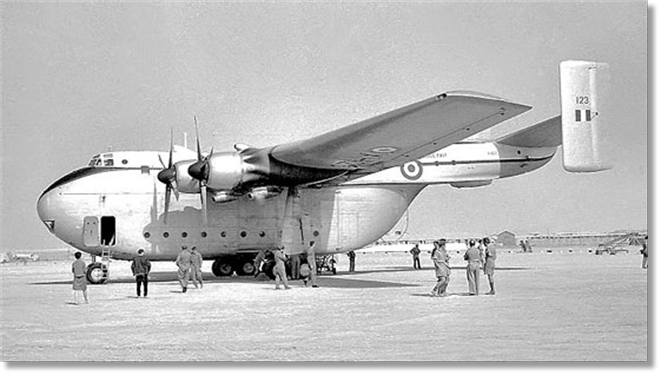
A Blackburn Beverley at Masirah - the Workhorse of the Middle East

From: Dennis Wood, Swindon, Wilts
Subject: Memories of Masirah
Subject: Memories of Masirah
I was in Masirah in 1974 and the last person to be demobbed who was in Masirah at the same time as me is Ray Ralph. I remember flying to Dubai on the fresh food run in an Andover. This trip was used to fly workers from Pakistan who worked for the Ministry of Public Buildings and Works (MPBW) at Masirah.
The workers could only transit Dubai from Pakistan so the flight was timed to pick the workers up at Sharjah or Dubai. The reason is Arabs and muslins are best kept apart.
For a holiday we flew to Gan for a few days on a Britannia which was transiting Masirah and Gan on route to Hong Kong. The difference in Gan to Masirah was Gan had green grass; a clear blue sea for swimming and snorkelling to watch the fish was really something exciting to see. We caught the Britannia back on the return leg to Masirah.
Transiting through Masirah was the following aircraft a Nimrud, a Vulcan, on exercise, Hercules quite frequently and a Belfast which was on the ground for a few days while it was repaired.
In Masirah we went on bondu bashes which entailed driving in a 4x4 Landrover to the other end of the island to have a barbecue of barracuda fish steaks. And of course, drinking cold beer.
The workers could only transit Dubai from Pakistan so the flight was timed to pick the workers up at Sharjah or Dubai. The reason is Arabs and muslins are best kept apart.
For a holiday we flew to Gan for a few days on a Britannia which was transiting Masirah and Gan on route to Hong Kong. The difference in Gan to Masirah was Gan had green grass; a clear blue sea for swimming and snorkelling to watch the fish was really something exciting to see. We caught the Britannia back on the return leg to Masirah.
Transiting through Masirah was the following aircraft a Nimrud, a Vulcan, on exercise, Hercules quite frequently and a Belfast which was on the ground for a few days while it was repaired.
In Masirah we went on bondu bashes which entailed driving in a 4x4 Landrover to the other end of the island to have a barbecue of barracuda fish steaks. And of course, drinking cold beer.
At this end of the island there are quite a few ship wrecks to be seen off the coast. The coast here is very treacherous with rocks. On the way back, we stopped off at the Arab Wali camp and gave them all our water which they deeply appreciated. All the local Arab women wore veils. I often wonder if that has changed.
In the local pub called the ‘Turtle Club’ the empty beer cans during the evening was collected in a pile and bombing raids took place to smash the pile. Competition was quite friendly and good fun. Sea fishing was another past-time but as sharks was always present swimming in the sea was not allowed. You had to fish from the shore like. I never did see anybody catch any fish.
Being an unaccompanied tour compassionate cases for various reasons was always dealt with sympathetically. The airman was sent home in all cases to sort it out. The CO in 1974 was very good in sending airman home regardless of what PMQ said at Innsworth.
In the local pub called the ‘Turtle Club’ the empty beer cans during the evening was collected in a pile and bombing raids took place to smash the pile. Competition was quite friendly and good fun. Sea fishing was another past-time but as sharks was always present swimming in the sea was not allowed. You had to fish from the shore like. I never did see anybody catch any fish.
Being an unaccompanied tour compassionate cases for various reasons was always dealt with sympathetically. The airman was sent home in all cases to sort it out. The CO in 1974 was very good in sending airman home regardless of what PMQ said at Innsworth.
Another sight to see was the turtles coming ashore in the evening, digging a hole in the sand, laying their eggs, covering the hole and then goes back into the sea. The young turtles are left to hatch and look after themselves from day one. When hatching they all in mass just run to the sea. It is quite a spectacular sight to see. Regret I do not know what type or name of the turtles.
Another monument on the island is dedicated to the crew of the ship called ‘Inverdale’ this ship in 1904 was wrecked on the rocks off Masirah and the survivors on coming ashore were massacred by the local Arabs. What happened next is the Sultan of Oman as punishment for the massacre did not allow any brick permanent buildings be built in Masirah for 25 years. How true this version is I cannot confirm but the 25 years is now up so permanent buildings can now be built in Masirah. A new hospital was under construction when I was there in 1974. I wonder if it has been opened.
The big event for any airmen, which includes me, was “tourex”, end of the tour. A curry meal was provided and free beer was provided before the money ran out which it did in my case. Then home the following day in a Britannia with a sun-tan.
Some information about Masirah and Salalah:
The island of Masirah is approximately 44 miles long and 10 miles wide and is a part of the Sultanate of Oman. The mainland lies about 1.5 miles NNW of Masirah. The Wali is the local government representative for the sultan. Wali camp is adjacent to Masirah and houses 3,000 +/- Omanis and is strictly out of bounds to service personnel.
Animal life on the island is sparse and except for flies, insects are few. There are no mosquitos (but Paludrine must be taken for the threat at Salalah). The few snakes and camel spiders are rarely seen and although poisonous are not as dangerous as commonly implied. The sea is swarming with fish including shark, barracuda, manta ray, water snakes and moray eels. In this respect and because of very strong tides and currents, it's very dangerous to swim in the sea.
The Sultan of Oman, Qabus bin Said, prefers to live in the Royal Palace at Salalah (Dhofar) which is 400 miles south of Masirah on the mainland coast. Raysut Harbour is 10 miles from the town of Salalah where RFA vessels discharge cargo for the RAF station which is adjacent to the town.
The Capital of Oman is Muscat with an airport at Seeb some 200 miles north of Masirah
Another monument on the island is dedicated to the crew of the ship called ‘Inverdale’ this ship in 1904 was wrecked on the rocks off Masirah and the survivors on coming ashore were massacred by the local Arabs. What happened next is the Sultan of Oman as punishment for the massacre did not allow any brick permanent buildings be built in Masirah for 25 years. How true this version is I cannot confirm but the 25 years is now up so permanent buildings can now be built in Masirah. A new hospital was under construction when I was there in 1974. I wonder if it has been opened.
The big event for any airmen, which includes me, was “tourex”, end of the tour. A curry meal was provided and free beer was provided before the money ran out which it did in my case. Then home the following day in a Britannia with a sun-tan.
Some information about Masirah and Salalah:
The island of Masirah is approximately 44 miles long and 10 miles wide and is a part of the Sultanate of Oman. The mainland lies about 1.5 miles NNW of Masirah. The Wali is the local government representative for the sultan. Wali camp is adjacent to Masirah and houses 3,000 +/- Omanis and is strictly out of bounds to service personnel.
Animal life on the island is sparse and except for flies, insects are few. There are no mosquitos (but Paludrine must be taken for the threat at Salalah). The few snakes and camel spiders are rarely seen and although poisonous are not as dangerous as commonly implied. The sea is swarming with fish including shark, barracuda, manta ray, water snakes and moray eels. In this respect and because of very strong tides and currents, it's very dangerous to swim in the sea.
The Sultan of Oman, Qabus bin Said, prefers to live in the Royal Palace at Salalah (Dhofar) which is 400 miles south of Masirah on the mainland coast. Raysut Harbour is 10 miles from the town of Salalah where RFA vessels discharge cargo for the RAF station which is adjacent to the town.
The Capital of Oman is Muscat with an airport at Seeb some 200 miles north of Masirah

From: Ian Berry, West Swindon
Subject: Pictures of Masirah 1972
Hi Tony,
I was going to write an article for Masirah as have I some good photos primarily through my old mate Dave Cromb (d) who I would have credited them to. I'm away Monday (6th) starting a Transatlantic cruise and ending in Miami. Back in UK 24th Nov. In the meantime, I'll attach several of the Masirah pictures that you'll be able to use.
Regards
Ian
Subject: Pictures of Masirah 1972
Hi Tony,
I was going to write an article for Masirah as have I some good photos primarily through my old mate Dave Cromb (d) who I would have credited them to. I'm away Monday (6th) starting a Transatlantic cruise and ending in Miami. Back in UK 24th Nov. In the meantime, I'll attach several of the Masirah pictures that you'll be able to use.
Regards
Ian
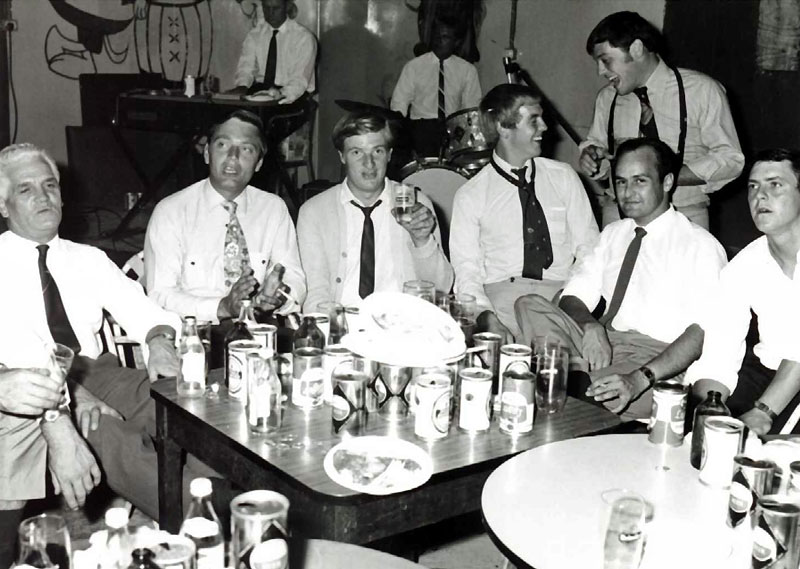
In lieu of an article from Ian - please see a very comprehensive history of Masirah from it's beginnings up to and including the Gulf War: RAF Masirah compiled by Tony Gale

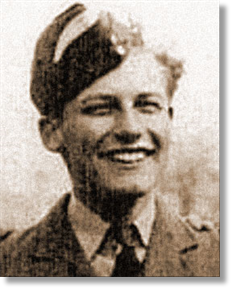
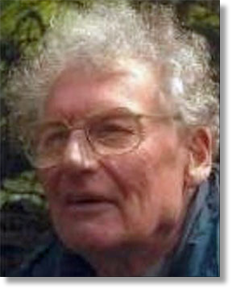
Part One - The UK
In the middle of 1942, while working in the Post Office, I enrolled with the Air Training Corps (ATC), with the further intention of going into the RAF when called up for military service. It might be an aid when the time came though it meant relinquishing my membership in the Home Guard, since one couldn’t do everything. As it turned out, the ATC did very little. Based in Bodmin, of course, the only instruction that was new was a series of evening classes on elementary navigation, given by a Commander Rowe, a long retired naval man in his late seventies, with white beard and hair. I suppose it was useful, but all other activities, drill, aircraft recognition etc., had been covered during the Home Guard period, and my interest palled. Still, being in the ATC was a useful factor when I wrote off and volunteered to go into the RAF as aircrew in about November 1942. Volunteering in advance of call-up secured a place; otherwise one would be put elsewhere into the RAF, Army, Navy - whatever a Call-up Board decided.
So, in the first week of December, I was called to London, and with two days off work from the Post Office, and issued with a rail warrant, I went to some overnight accommodation before an early morning appointment at an Air Ministry building in the Euston area. There, after a short wait, one was shuffled off to join a handful of others waiting for a somewhat cursory medical examination. Once that had been completed there was a twenty-minute to half hour interview. This dealt with one’s education, interests, especially sports, and general enthusiasm for the RAF. You acknowledged that when called up, if you failed a later medical or failed to make the required grade during aircrew training, you would have to remain in the RAF in whatever trade was allotted. This might not be ideal but would act as a spur! I was accepted for future aircrew training, went through the short but curious ceremony of swearing the oath of allegiance, and came away with the “King’s Shilling”, which in effect meant that I was formally part of the RAF. Then home to await the day of reckoning without much concern. Of all the Forces the RAF had a reputation for being less rigid in its treatment of members; discipline without bullying, and training on the basis of wanting to know. Even the uniform had a civil appearance - shirts with attached collars, ties, always shoes not boots, and no restrictions on hair style. The end product was a contented Force where misdeeds were minimal.
My time as temporary Sorting Clerk & Telegraphist in Bodmin Head Post Office, with its one night a week air raid “Fire Watching” duty, came to an end nine months later, by which time I was well past my 18th birthday. I was called up on the 27th September 1943 as an aircrew cadet to undergo training under the categories of Pilot, Navigator, Bombaimer, Flight Engineer, Airgunner or Wireless Operator. The outcome was to some extent based upon aptitude tests and examinations but probably at that stage of the war was determined more upon the requirements for particular categories, e.g. a special need for navigators or a surplus of pilots.
So, in the first week of December, I was called to London, and with two days off work from the Post Office, and issued with a rail warrant, I went to some overnight accommodation before an early morning appointment at an Air Ministry building in the Euston area. There, after a short wait, one was shuffled off to join a handful of others waiting for a somewhat cursory medical examination. Once that had been completed there was a twenty-minute to half hour interview. This dealt with one’s education, interests, especially sports, and general enthusiasm for the RAF. You acknowledged that when called up, if you failed a later medical or failed to make the required grade during aircrew training, you would have to remain in the RAF in whatever trade was allotted. This might not be ideal but would act as a spur! I was accepted for future aircrew training, went through the short but curious ceremony of swearing the oath of allegiance, and came away with the “King’s Shilling”, which in effect meant that I was formally part of the RAF. Then home to await the day of reckoning without much concern. Of all the Forces the RAF had a reputation for being less rigid in its treatment of members; discipline without bullying, and training on the basis of wanting to know. Even the uniform had a civil appearance - shirts with attached collars, ties, always shoes not boots, and no restrictions on hair style. The end product was a contented Force where misdeeds were minimal.
My time as temporary Sorting Clerk & Telegraphist in Bodmin Head Post Office, with its one night a week air raid “Fire Watching” duty, came to an end nine months later, by which time I was well past my 18th birthday. I was called up on the 27th September 1943 as an aircrew cadet to undergo training under the categories of Pilot, Navigator, Bombaimer, Flight Engineer, Airgunner or Wireless Operator. The outcome was to some extent based upon aptitude tests and examinations but probably at that stage of the war was determined more upon the requirements for particular categories, e.g. a special need for navigators or a surplus of pilots.
MY TIME IN THE R.A.F., 1943-1947
An Air Mover's Story in Eight Parts
Norman Victor Quinnell, 1925-2008
An Air Mover's Story in Eight Parts
Norman Victor Quinnell, 1925-2008
It was common knowledge that air gunners were in short supply, and their courses were commensurately short, a matter of about three months’ practical, following the usual initial disciplinary and fitness training. It is curious but I barely recall anything of the day I left Bodmin for London. Once there, like dozens of others I had to report to a medical centre for further examination and suitability, and then to some sort of warehouse to be kitted-out. One was given a kitbag, two or three of each item of underclothing and socks, shirts, ties, gloves and two pairs of shoes, one pair of gym shoes with two pairs of shorts. There was a “best” uniform of belted jacket, trousers, and an additional white parade belt, and two weekday uniforms of tunics and trousers, caps with badges, and the white insert for the front of the cap, which denoted an aircrew cadet. You went off and changed into a working uniform, put civilian stuff into a box to be sent home, and filled the kitbag with the other uniforms etc., and waited for a lorry to go to the appointed billets.
(In due course I found that most people carried some memento of their home, a photo of the family or the house, a blank school notebook, even an old mug; some sort of talisman. My companion during the whole of my service was a book “A New Anthology of Modern Verse” by C. Day Lewis & L.A.G. Strong, newly published by Methuen. When working I had purchased a book each month and this was one. Another anthology, “Poems of Twenty Years 1918 - 1938” collected by Maurice Wollman, would join it about a year later but was not as pocketable as the former. Much later, when in Singapore, I would buy a book every month via the Readers Union’s postal service and a number of these books still survive.)
Initial training was in London. The RAF had commandeered a massive amount of property near central London for accommodation, and I with about 60 other cadets, joined a couple of hundred already billeted in four or five storey luxury flats in St. John’s Wood. Built during the late twenties or early thirties, I’m sure they had a lot of art nouveau features I didn’t recognise at the time or are long forgotten. There were lifts in commission but we had to use the stairs. The opulence that I recall related to the bathrooms, which had green marble flooring and cladding round the baths which were half sunk into the floors. There must have been kitchens attached to the flats but they may have been sealed off; I don’t recall seeing one. Most rooms accommodated 8 to 10 recruits in upper and lower bunk beds, with metal wardrobes and, for each pair, small but adequate lockers. A pair of NCO’s, each in charge of about 30 of us, shared a small room on the same floor. We were wakened at 6.00, and assembled on the road below in 3 abreast order with someone at the rear holding a red lantern, since it was pitch black, and a regular RAF Corporal leading with a white light, while another marched alongside and barked orders to the tired and disenchanted mob. It was a 10 minute “march” to a hall where all cadets in the area had their meals, after which we were sent off to nearby rooms for initial instruction on the history and organisation of the RAF and numerous additional tests for medical conditions - eyesight, colour-blindness and physical and mental reactions.
There were also written tests to establish other capabilities or aptitudes, and I remember one puzzle, creating a square from a lot of different sized cardboard triangles within a set time. There was a hall where some attempt at drill was undertaken. Normally an hour’s break was taken for lunch and again for supper, after which we were marched back to the billet. The evening was taken up by polishing buttons, cap badges, and the brass on our heavy canvas dress belts. This inevitably created blackish smears on the belt, which then had to be re-whitened with “blanco”. The pair of shoes we were wearing and the spare pair had to have the “bobbles” in the leather pressed out by alternately blacking and then rubbing with the back of a shoe brush - a laborious process that occupied five or six evenings, and the ultimate aim was to have shoes looking like patent leather. A Corporal appeared regularly to supervise progress and grunt minimal approval. He also ensured that the lights were out at ten o’clock. Initially there was no contact with the outside world, no newspapers or radio, and nobody worried about it.
Everyone appeared to get on quite well, though only mealtimes and a half hour in the evenings were available for general conversation, and the transitory situation negated any form of friendship developing. People had all sorts of jobs before enlisting, but I was surprised to find that about a quarter had never left their home area until now.
No one was allowed out to see what London looked like until the second weekend, by which time most were fairly disciplined, tamed, and certainly tired. Rumour persisted, but was always denied, that bromide was put into our tea to deter any sexual ambitions once we were off the leash. Certainly the tea had an odd taste but its effect was questionable.
(In due course I found that most people carried some memento of their home, a photo of the family or the house, a blank school notebook, even an old mug; some sort of talisman. My companion during the whole of my service was a book “A New Anthology of Modern Verse” by C. Day Lewis & L.A.G. Strong, newly published by Methuen. When working I had purchased a book each month and this was one. Another anthology, “Poems of Twenty Years 1918 - 1938” collected by Maurice Wollman, would join it about a year later but was not as pocketable as the former. Much later, when in Singapore, I would buy a book every month via the Readers Union’s postal service and a number of these books still survive.)
Initial training was in London. The RAF had commandeered a massive amount of property near central London for accommodation, and I with about 60 other cadets, joined a couple of hundred already billeted in four or five storey luxury flats in St. John’s Wood. Built during the late twenties or early thirties, I’m sure they had a lot of art nouveau features I didn’t recognise at the time or are long forgotten. There were lifts in commission but we had to use the stairs. The opulence that I recall related to the bathrooms, which had green marble flooring and cladding round the baths which were half sunk into the floors. There must have been kitchens attached to the flats but they may have been sealed off; I don’t recall seeing one. Most rooms accommodated 8 to 10 recruits in upper and lower bunk beds, with metal wardrobes and, for each pair, small but adequate lockers. A pair of NCO’s, each in charge of about 30 of us, shared a small room on the same floor. We were wakened at 6.00, and assembled on the road below in 3 abreast order with someone at the rear holding a red lantern, since it was pitch black, and a regular RAF Corporal leading with a white light, while another marched alongside and barked orders to the tired and disenchanted mob. It was a 10 minute “march” to a hall where all cadets in the area had their meals, after which we were sent off to nearby rooms for initial instruction on the history and organisation of the RAF and numerous additional tests for medical conditions - eyesight, colour-blindness and physical and mental reactions.
There were also written tests to establish other capabilities or aptitudes, and I remember one puzzle, creating a square from a lot of different sized cardboard triangles within a set time. There was a hall where some attempt at drill was undertaken. Normally an hour’s break was taken for lunch and again for supper, after which we were marched back to the billet. The evening was taken up by polishing buttons, cap badges, and the brass on our heavy canvas dress belts. This inevitably created blackish smears on the belt, which then had to be re-whitened with “blanco”. The pair of shoes we were wearing and the spare pair had to have the “bobbles” in the leather pressed out by alternately blacking and then rubbing with the back of a shoe brush - a laborious process that occupied five or six evenings, and the ultimate aim was to have shoes looking like patent leather. A Corporal appeared regularly to supervise progress and grunt minimal approval. He also ensured that the lights were out at ten o’clock. Initially there was no contact with the outside world, no newspapers or radio, and nobody worried about it.
Everyone appeared to get on quite well, though only mealtimes and a half hour in the evenings were available for general conversation, and the transitory situation negated any form of friendship developing. People had all sorts of jobs before enlisting, but I was surprised to find that about a quarter had never left their home area until now.
No one was allowed out to see what London looked like until the second weekend, by which time most were fairly disciplined, tamed, and certainly tired. Rumour persisted, but was always denied, that bromide was put into our tea to deter any sexual ambitions once we were off the leash. Certainly the tea had an odd taste but its effect was questionable.
From our luxury flat in Abbey Road, St. John’s Wood, I went off to explore London. One viewed damaged buildings and empty plots as an accepted part of the landscape, but I recall the hundreds of properties, particularly in fashionable areas, with “For Sale” signs. I went to Regents Park and made a special trip to North Kensington and made a pencil sketch of No.9 North Pole Road, where Mother was born and brought up. (She later said she didn’t recognise it and I must have gone to the wrong place). I probably visited my Aunt Nance and Uncle Walter, but their son Peter would have been abroad in the RAF at this time.
One of the numerous chores at Abbey Road was the daily inspection of beds. They were two tier bunk beds. Each had three square four inch thick “biscuits” which, set out in a line, formed the mattress. Two sheets, two blankets, a pillow and pillowcase made up the rest. Each morning everything had to be put into a neat pile, the “biscuits”, then the blankets and sheets, all specially folded, and lastly the pillow. While you stood by your bed the Corporal measured the accuracy of folding and piling. If not to his liking all was tipped on the floor to start again, a horrid task if you had a top bunk. Lockers and the small bedside cabinets were given a cursory inspection for neatness, but all personal stuff was left alone. Surprisingly, throughout the time at St. John’s Wood, there were no air raids.
After three weeks, around the third week of October, thirty of us were posted to No.3 Initial Training Wing, at Torquay, to start some real learning. Almost all the large and some of the smaller hotels had been requisitioned by the RAF, so the place had hundreds of aircrew cadets. The ITWs had first been set up in Torbay in 1940 (and were closed in late1944). Although we did not suffer any air raids during our stay, the place was not immune to hit and run strikes. The Palace Hotel, an RAF hospital, was badly damaged in two raids in 1943, and St. Marychurch at Babbacombe had been bombed on Rogation Sunday, 1943, with many casualties. (The last raid, in 1944, destroyed the Bay Court Hotel.)
I was among nearly 40 billeted in St. James Hotel, a four storied narrow building in Victoria Parade, which bounded the East side of the Old Harbour. The place was warm enough with central heating of the period, but in poor repair, and had to be shared with a number of rats at night time when they emerged from somewhere and frolicked on the bare wood stairs and corridors. The rooms had the usual bunk beds and lockers, and, being a hotel, good toilet facilities. There was a Flt/Lieutenant Officer in overall charge, and under him a Sergeant, but in retrospect our lives were mostly bound to a Corporal who dealt with discipline, drill, and general matters and had a strict but kindly disposition. Sergeant and Corporal undertook a snap inspection of bedding at least once a week to view the folding and neatness, with a severe reprimand to any falling below the standard. The ground floor rooms were used for admin. by the CO and for general meetings. There was also a space for those who did limited turns of guard duty at night, since the front door was either never locked or locked very late. Any night time bang that echoed upstairs was from the guard throwing a missile at a rat. The stairs were poorly lit and a rat seemed to sit on every flight. (Now I wonder why the creatures were not poisoned.)
Meals were taken at the Pavilion, a large Civic building which had, in part at least, been converted to a mess hall. On the opposite side of the harbour it was under five minutes away. I suppose mealtimes were staggered to cope with numbers, though it couldn’t have been the only mess hall. Food was good by the current standards and the quantity greater than in civilian life; eggs, bacon, sausages seemed plentiful at breakfasts, and it was similar at other meals. There must have been NAAFI premises in town for off duty leisure and entertainment but memory of these has faded. Similarly I cannot recall where the main instruction classrooms were, except that some were in part of one of the larger hotels.
A large building off Torwood Road which had been the depot for Grey Cars coaches had been converted for use as a gym - no ropes or wall bars but furnished with other gymnastic stuff and the concrete floors had painted lines for games. Mostly it was used for long periods of physical exercises. The nearby Torwood Gardens were appropriated for the practice of Morse Code signalling with Aldis Lamps. Half the class at one end of the gardens and half at the other, sending messages back and forth. Instruction in swimming took place in the Marine Spa Hotel near the pier of the New Harbour and close to St. James. The Spa was renowned for its “Vita-Glass” sun lounge, for patrons to soak up ultra-violet light, and, like the hotel generally, out of bounds to us. It may have had retired occupants, but the pool was excellent. Some 50% of us had a fair proficiency at swimming and all had to manage at least two or three lengths by the end of their stay.
One of the numerous chores at Abbey Road was the daily inspection of beds. They were two tier bunk beds. Each had three square four inch thick “biscuits” which, set out in a line, formed the mattress. Two sheets, two blankets, a pillow and pillowcase made up the rest. Each morning everything had to be put into a neat pile, the “biscuits”, then the blankets and sheets, all specially folded, and lastly the pillow. While you stood by your bed the Corporal measured the accuracy of folding and piling. If not to his liking all was tipped on the floor to start again, a horrid task if you had a top bunk. Lockers and the small bedside cabinets were given a cursory inspection for neatness, but all personal stuff was left alone. Surprisingly, throughout the time at St. John’s Wood, there were no air raids.
After three weeks, around the third week of October, thirty of us were posted to No.3 Initial Training Wing, at Torquay, to start some real learning. Almost all the large and some of the smaller hotels had been requisitioned by the RAF, so the place had hundreds of aircrew cadets. The ITWs had first been set up in Torbay in 1940 (and were closed in late1944). Although we did not suffer any air raids during our stay, the place was not immune to hit and run strikes. The Palace Hotel, an RAF hospital, was badly damaged in two raids in 1943, and St. Marychurch at Babbacombe had been bombed on Rogation Sunday, 1943, with many casualties. (The last raid, in 1944, destroyed the Bay Court Hotel.)
I was among nearly 40 billeted in St. James Hotel, a four storied narrow building in Victoria Parade, which bounded the East side of the Old Harbour. The place was warm enough with central heating of the period, but in poor repair, and had to be shared with a number of rats at night time when they emerged from somewhere and frolicked on the bare wood stairs and corridors. The rooms had the usual bunk beds and lockers, and, being a hotel, good toilet facilities. There was a Flt/Lieutenant Officer in overall charge, and under him a Sergeant, but in retrospect our lives were mostly bound to a Corporal who dealt with discipline, drill, and general matters and had a strict but kindly disposition. Sergeant and Corporal undertook a snap inspection of bedding at least once a week to view the folding and neatness, with a severe reprimand to any falling below the standard. The ground floor rooms were used for admin. by the CO and for general meetings. There was also a space for those who did limited turns of guard duty at night, since the front door was either never locked or locked very late. Any night time bang that echoed upstairs was from the guard throwing a missile at a rat. The stairs were poorly lit and a rat seemed to sit on every flight. (Now I wonder why the creatures were not poisoned.)
Meals were taken at the Pavilion, a large Civic building which had, in part at least, been converted to a mess hall. On the opposite side of the harbour it was under five minutes away. I suppose mealtimes were staggered to cope with numbers, though it couldn’t have been the only mess hall. Food was good by the current standards and the quantity greater than in civilian life; eggs, bacon, sausages seemed plentiful at breakfasts, and it was similar at other meals. There must have been NAAFI premises in town for off duty leisure and entertainment but memory of these has faded. Similarly I cannot recall where the main instruction classrooms were, except that some were in part of one of the larger hotels.
A large building off Torwood Road which had been the depot for Grey Cars coaches had been converted for use as a gym - no ropes or wall bars but furnished with other gymnastic stuff and the concrete floors had painted lines for games. Mostly it was used for long periods of physical exercises. The nearby Torwood Gardens were appropriated for the practice of Morse Code signalling with Aldis Lamps. Half the class at one end of the gardens and half at the other, sending messages back and forth. Instruction in swimming took place in the Marine Spa Hotel near the pier of the New Harbour and close to St. James. The Spa was renowned for its “Vita-Glass” sun lounge, for patrons to soak up ultra-violet light, and, like the hotel generally, out of bounds to us. It may have had retired occupants, but the pool was excellent. Some 50% of us had a fair proficiency at swimming and all had to manage at least two or three lengths by the end of their stay.
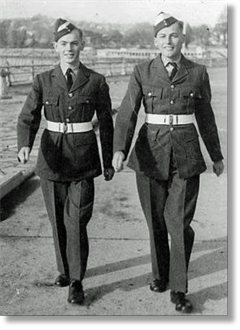
Not so my other venture…. I found out that if one went horse riding the RAF paid most of the fee, a great enticement. So, with no experience, I enquired at the nearest stables (well up Torwood Road (?)). There they me told me that tuition was unnecessary, so I was given some simple rules, mounted an apparently docile creature and set off along the suggested route through the town at a slow pace. All went well for the first mile, then, the horse bolted with me clinging on in a non-equestrian fashion. After 200 or 300 yards performing a spectacle for pedestrians I was able to get it to stop. Perhaps we were both out of breath. Holding tightly to the reins, I slid off, tied the animal to the nearest lamp post. With no intention of providing a second act I went into a shop and telephoned the stables for them to collect it. Not at all pleased, someone soon arrived and took it away while I walked back to the billet. The first and last time I sat on a horse! Running was much better, and I continued with that until the end of the Torquay time. Almost as crazy was the occasion when at a weekend Gordon Harrison and I took to a short swim in the sea followed by a brisk walk.
Gordon Harrison and NVQ
I’m unsure whether hotel guests ever had access to the pool. There were some lessons in life saving, and a regular exercise was jumping from the top board wearing a life-jacket. The Spa was used by all of the cadets in Torquay for swimming lessons but it seemed that no competitions were organised between groups.
Primary instruction courses included the Theory of Flight, Navigation, Armaments - especially the Browning machine gun - Aircraft Recognition, History & Structure of the RAF, etc. Timetables were linked to specific subjects and venues where instructors spent their days dealing with groups in their various stages of learning. Twin (or quadruple?) Browning guns were standard armaments to bomber aircraft so one had to know how to strip and re-assemble them, but at this stage there was no live firing that I recall. Tests, with comments, occurred monthly, and rarely was a pupil advised to move to another “career”.
Sport was an essential part of training, at least one afternoon a week and often Saturday mornings, which were otherwise normal working times. Although there was some pressure it was a matter of choice rather than compulsion as to what one took up. A reluctant footballer was no asset to any team. Being averse to boxing and most ball games, I thought distance running seemed the preferable choice, especially as a winter sport. Not that it was always pleasant, since wearing shorts with a singlet or vest was considered rather pathetic, and in teeming winter rain one got thoroughly chilly.
From initial four-mile jogs one was soon accompanying others and a shepherding instructor on six- and then ten-mile runs. Then the function of the instructor seemed to be to hide himself at some strategic point to check that people weren’t walking or even absenting themselves. Routes went towards Teignmouth, Totnes, and Brixham. Near the end of the ITW course, perhaps late January, there was a competitive run with a few Royal Navy cadets from the clock tower by the harbour to the Naval College at Dartmouth, nearly 14 miles. At the ferry crossing I think a card was issued with the arrival and departure times of each runner that was taken to the finish point at the College main entrance. The hardest part was the uphill slog through the College grounds. Out of over 50 runners I came in 13th. For me, a memorable achievement.
Primary instruction courses included the Theory of Flight, Navigation, Armaments - especially the Browning machine gun - Aircraft Recognition, History & Structure of the RAF, etc. Timetables were linked to specific subjects and venues where instructors spent their days dealing with groups in their various stages of learning. Twin (or quadruple?) Browning guns were standard armaments to bomber aircraft so one had to know how to strip and re-assemble them, but at this stage there was no live firing that I recall. Tests, with comments, occurred monthly, and rarely was a pupil advised to move to another “career”.
Sport was an essential part of training, at least one afternoon a week and often Saturday mornings, which were otherwise normal working times. Although there was some pressure it was a matter of choice rather than compulsion as to what one took up. A reluctant footballer was no asset to any team. Being averse to boxing and most ball games, I thought distance running seemed the preferable choice, especially as a winter sport. Not that it was always pleasant, since wearing shorts with a singlet or vest was considered rather pathetic, and in teeming winter rain one got thoroughly chilly.
From initial four-mile jogs one was soon accompanying others and a shepherding instructor on six- and then ten-mile runs. Then the function of the instructor seemed to be to hide himself at some strategic point to check that people weren’t walking or even absenting themselves. Routes went towards Teignmouth, Totnes, and Brixham. Near the end of the ITW course, perhaps late January, there was a competitive run with a few Royal Navy cadets from the clock tower by the harbour to the Naval College at Dartmouth, nearly 14 miles. At the ferry crossing I think a card was issued with the arrival and departure times of each runner that was taken to the finish point at the College main entrance. The hardest part was the uphill slog through the College grounds. Out of over 50 runners I came in 13th. For me, a memorable achievement.
The days were continuous studies, with Saturday afternoons for running, but evenings were free, and Sundays, after the compulsory Church Parade and Service where we joined other groups, all in best kit, following an inspection on the quayside. It was assumed that one was C of E, RC, or OD (other denominations), who could be accommodated within a Methodist church. Jews were allowed to find their own synagogue if there was one. Any non-believers were put onto deliberately onerous tasks, such as cleaning and washing floors, so it was pleasanter to go along to church. Marching had to be of a high order, and this was reached in the first month by hourly periods of intense drill on the promenade outside St. James’. I found it quite enjoyable, particularly since it often incorporated “Swedish Drill”, when we went through a long series of movements without orders, simply by memorizing the number of paces or counting seconds between each new action. These drill lessons usually attracted a considerable number of onlookers, doubtless waiting for any mistakes and the Corporal’s bellow. Unlike school, where the woodwork master would shout out “You’re a fool boy!” and hit you with the nearest piece of wood, the Corporal rarely singled out an individual for opprobrium, rightly assuming the individual knew of his mistake, and shouted at the group.
Free time was mostly taken up with walks and visits to pubs and the cinema, plus any NAAFI entertainment, but I don’t recall any ENSA concert coming to Torquay. Once I bought a ticket to a recital by the pianist Solomon. It was held in a small hall with an audience of under a hundred but a very good evening, and not just because I went with a local girl, Zoe Drew, whose parents had invited me to tea previously. (Quite unrelated to a school ex-girlfriend with the same surname).
Christmas loomed. I posted presents home, of which I only remember a silver RAF brooch for Mum and a riding crop for Muriel who had taken up at a riding school at Nanstallon. I have forgotten what I received - perhaps some cigarettes and books. The RAF laid on a good Christmas dinner and festivities (preceded on Christmas Eve by pub visits, which meant a lie-in on Christmas morning). No doubt we were waited upon by Officers, as customary, but no details remain in the mind, and I am sure a few pupils accepted invitations from families in the town.
New Year’s Eve was a bit like Christmas Eve, but with no special meals to follow on New Year’s Day, which was not a holiday. Three of us, singing the German version of “Holy Night”, taught by the one who knew German (Harrison I think) walked to the clock tower. Typical teenage stupidity, since there were people about who certainly had reasons to detest anything German, and some maybe a little drunk. Singing ceased abruptly however when, near midnight, we were confronted by a camel at the clock tower. Coming out of the darkness (there were of course no street lights), it was, as intended, a complete shock, organised with a keeper in attendance by Paignton Zoo. The keeper had walked with the animal from the zoo through all the main streets to get to the clock tower by midnight, after which they would return straight to the zoo. Although it was treated as a minor amusing story in the local press; the slant would be much different today, disrupting a camel’s sleep.
January 1st. had the usual classes, with slightly later start perhaps. For days it had been very cold with a calm sea, and much of the Inner Harbour was covered with ice. Our drill Corporal was a short man, in his late twenties, with a neat moustache, immaculate dress, and a sharp temper; nevertheless he was very fair and much liked. (In a good mood he would chat about his full time career in the Service, and occasionally produced photos of earlier postings, and sometimes nudes of a beautiful woman, he claimed was his fiancée.) However, for New Year’ Day, he elicited the assistance of a Sergeant swimming instructor and announced that “volunteers” were required for a swim in the morning - in the Inner Harbour. The names of about 20 fairly proficient swimmers were read out to the assembled course, from which nearly a dozen foolhardy idiots came forward, of which I was one and Harrison another.
Strict instructions were issued. No person was to swim more than, I think, 15 yards from the harbour wall, and to leave the water immediately upon any feeling of uncertainty. We had all been given lifesaving instruction during swimming lessons, and on the quayside there was a lifebelt and ropes, as well as our two NCO’s with a few blankets. It may have been a drill period that was used for this escapade, but mid morning, to a cheer from the throng, the swimmers emerged from St. James, crossed the road, ran down the steps set in the harbour wall and jumped into the water with its ice that fragmented and floated about.
After a few seconds of shock I found brisk overarm swimming relieved the tension, but within about 4 or 5 minutes we were all called out and sent to have hot showers. Very temporary celebrities - though I, like most, was not going to volunteer for any second experience.
The Course continued with its varied subjects, and I’ve only listed those I can remember; there were several others. Towards the middle of January examinations were held, at the end of which we were allowed around ten days leave. Although there had been letters home there was much to talk about, and friends to visit - the few who were not in the Forces or, in the case of girls, those not scattered around the country in their careers. I gleaned news from the parents of particular friends, Desmond Burton, a Midshipman Met. Officer in the RN, and David Zimber, a Navigation Officer in the Merchant Navy. There was also, of course, the unwelcome information about those who were now missing or dead, most of whom I had known only by sight in Bodmin or Lanivet, but some as seniors at school.
On return to Torquay we had our results within a day or two. Most pupils were within the required standards for going on to PNB (Pilot, Navigator, Bombaimer) courses. The others could accept training as Airgunners, Wireless Operators, Flight Engineers or go onto ground duties. As a fitting end the whole Course was photographed.
Christmas loomed. I posted presents home, of which I only remember a silver RAF brooch for Mum and a riding crop for Muriel who had taken up at a riding school at Nanstallon. I have forgotten what I received - perhaps some cigarettes and books. The RAF laid on a good Christmas dinner and festivities (preceded on Christmas Eve by pub visits, which meant a lie-in on Christmas morning). No doubt we were waited upon by Officers, as customary, but no details remain in the mind, and I am sure a few pupils accepted invitations from families in the town.
New Year’s Eve was a bit like Christmas Eve, but with no special meals to follow on New Year’s Day, which was not a holiday. Three of us, singing the German version of “Holy Night”, taught by the one who knew German (Harrison I think) walked to the clock tower. Typical teenage stupidity, since there were people about who certainly had reasons to detest anything German, and some maybe a little drunk. Singing ceased abruptly however when, near midnight, we were confronted by a camel at the clock tower. Coming out of the darkness (there were of course no street lights), it was, as intended, a complete shock, organised with a keeper in attendance by Paignton Zoo. The keeper had walked with the animal from the zoo through all the main streets to get to the clock tower by midnight, after which they would return straight to the zoo. Although it was treated as a minor amusing story in the local press; the slant would be much different today, disrupting a camel’s sleep.
January 1st. had the usual classes, with slightly later start perhaps. For days it had been very cold with a calm sea, and much of the Inner Harbour was covered with ice. Our drill Corporal was a short man, in his late twenties, with a neat moustache, immaculate dress, and a sharp temper; nevertheless he was very fair and much liked. (In a good mood he would chat about his full time career in the Service, and occasionally produced photos of earlier postings, and sometimes nudes of a beautiful woman, he claimed was his fiancée.) However, for New Year’ Day, he elicited the assistance of a Sergeant swimming instructor and announced that “volunteers” were required for a swim in the morning - in the Inner Harbour. The names of about 20 fairly proficient swimmers were read out to the assembled course, from which nearly a dozen foolhardy idiots came forward, of which I was one and Harrison another.
Strict instructions were issued. No person was to swim more than, I think, 15 yards from the harbour wall, and to leave the water immediately upon any feeling of uncertainty. We had all been given lifesaving instruction during swimming lessons, and on the quayside there was a lifebelt and ropes, as well as our two NCO’s with a few blankets. It may have been a drill period that was used for this escapade, but mid morning, to a cheer from the throng, the swimmers emerged from St. James, crossed the road, ran down the steps set in the harbour wall and jumped into the water with its ice that fragmented and floated about.
After a few seconds of shock I found brisk overarm swimming relieved the tension, but within about 4 or 5 minutes we were all called out and sent to have hot showers. Very temporary celebrities - though I, like most, was not going to volunteer for any second experience.
The Course continued with its varied subjects, and I’ve only listed those I can remember; there were several others. Towards the middle of January examinations were held, at the end of which we were allowed around ten days leave. Although there had been letters home there was much to talk about, and friends to visit - the few who were not in the Forces or, in the case of girls, those not scattered around the country in their careers. I gleaned news from the parents of particular friends, Desmond Burton, a Midshipman Met. Officer in the RN, and David Zimber, a Navigation Officer in the Merchant Navy. There was also, of course, the unwelcome information about those who were now missing or dead, most of whom I had known only by sight in Bodmin or Lanivet, but some as seniors at school.
On return to Torquay we had our results within a day or two. Most pupils were within the required standards for going on to PNB (Pilot, Navigator, Bombaimer) courses. The others could accept training as Airgunners, Wireless Operators, Flight Engineers or go onto ground duties. As a fitting end the whole Course was photographed.

Passing-out photo at end of Initial Training at Torquay; NVQ at back row, 2nd from left
So, by the start of February I was posted to an EFTS (Elementary Flying Training School). There were a number throughout the country, and RAF Winkfield, near Windsor, was a very small satellite of Marshall’s Flying School at Woking, a former civilian flying school which had been taken over by the RAF. Indeed, Mr. Marshall still ran it with the rank of Wing Commander, and I believe the main school was called Fairoaks, Woking. Winkfield airfield was simply a large pasture field with a handful of Nissen huts and two or three hangars. It was a mile from its eponymous village, about five from Windsor and a dozen miles from the long established Fairoaks. An adjacent field to the east was occupied by a smallholding. Next to this, turning left from our entrance gate and along the main road, was “The Jolly Gardener,” a roadhouse pub which became our primary focus when off duty. There were few permanent staff, and not all lived on site. A Flt/Lieutenant was in charge and had a half dozen flying instructors - Flt/Sergeant and Flying Officer (FO) pilots; a Sergeant with three or four air mechanics, and a couple of Corporals who sometimes manned the tiny gatehouse. Of pupils there were perhaps thirty, but not one from my Torquay course. There were a number of Flying Training Schools and though some may have gone to Fairoaks it appears to have been a general policy to split groups up whenever possible.
For a week or two there was classroom instruction on the Tiger Moth aircraft, its instrumentation, capabilities, foibles, etc. This was followed by landscape lectures with particular reference to the local area, landmarks, power lines, chimneys and so on, and these must have included map reading. One was going to get 13 hours of flying, and only if a solo flight was permitted and satisfactorily accomplished within that time would a pupil go on to an AFU (Advanced Flying School).
The Tiger Moth was I think, an early 1930’s design of a De Havilland aircraft, a two seater, where the occupants sat in separate, in-line, open cockpits. In the training version there were dual controls and an “intercom” system with headphones. A biplane with fabric covered wings and an aluminium body, it had no claim to speed but could withstand gross mishandling. Because of its relative simplicity it was a popular aircraft for pre-war fliers as well as a training plane.
For a week or two there was classroom instruction on the Tiger Moth aircraft, its instrumentation, capabilities, foibles, etc. This was followed by landscape lectures with particular reference to the local area, landmarks, power lines, chimneys and so on, and these must have included map reading. One was going to get 13 hours of flying, and only if a solo flight was permitted and satisfactorily accomplished within that time would a pupil go on to an AFU (Advanced Flying School).
The Tiger Moth was I think, an early 1930’s design of a De Havilland aircraft, a two seater, where the occupants sat in separate, in-line, open cockpits. In the training version there were dual controls and an “intercom” system with headphones. A biplane with fabric covered wings and an aluminium body, it had no claim to speed but could withstand gross mishandling. Because of its relative simplicity it was a popular aircraft for pre-war fliers as well as a training plane.
The day came when I sat in the front cockpit (instructor behind), and familiarised myself with the instruments , controls, and starting procedure. The latter involved a groundcrew mechanic, since the propeller had to be swung by hand until the engine fired. Then there was taxi-ing practice; trundling the plane around the airfield, using the rudder and brakes. For a grass field it was surprisingly smooth, and I suspect that it was grazed for a day or more between Courses. There was a lot of waiting between bouts of training, when lining up for taxi-ing, and there was a limit of perhaps only three planes operating on the field in such circumstances.
Flying only took place when the weather was reasonably good, so a lot of time was spent waiting around, and persistently poor weather resulted in indoor classes, which included basic information on aero engines, some meteorology, visual navigation, and the inevitable aircraft recognition. Written work must have been associated with all this, accompanied by tests.
After the taxi-ing came an extended period of take-offs and landings over three or four days, with very few aircraft involved at a time. The instructor did the first couple while the pupil followed by gently holding his own linked controls. Then, gradually, the pupil assumed more and more of the operation, almost without realising it, unless a mistake was made, when pressure on the controls became obvious, accompanied by a raised voice over the intercom.
Those who had driven cars seemed to find the whole exercise much easier. The pilots, mostly seconded from active duties, had great patience and cool nerves, though I never heard any stories of panicking pupils.
After the taxi-ing came an extended period of take-offs and landings over three or four days, with very few aircraft involved at a time. The instructor did the first couple while the pupil followed by gently holding his own linked controls. Then, gradually, the pupil assumed more and more of the operation, almost without realising it, unless a mistake was made, when pressure on the controls became obvious, accompanied by a raised voice over the intercom.
Those who had driven cars seemed to find the whole exercise much easier. The pilots, mostly seconded from active duties, had great patience and cool nerves, though I never heard any stories of panicking pupils.
Next came proper flying - take-off, climbing, straight and level flight, turns and descent. Sometimes one half hour lesson a day, at others two a day. This progressed to the more “dangerous” exercises, rolls, loops, and stalls. The latter was probably the most unsettling. Power was cut off until the aircraft went into a vertical dive, slowly spinning to left or right, and increasing speed towards the ground. The corrective measures, using the joystick and rudder bar, took quite a few seconds to obtain a response, even with the voice of the instructor ringing in your ears. You concentrated on the controls and instruments and didn’t look outside! But the normal, visual navigation flights, map reading to three or four specific points, were really fun.
At the start of April we had a casual air raid, when a single plane exiting from the London area unloaded a few dozen incendiary bombs early one morning. The station guard activated the alarm and we quickly dressed and prepared to go to a brick air raid shelter. Outside, it was obvious the aircraft had gone and, while none of the huts or perimeter buildings had been hit, a number of isolated incendiaries were burning. All were ineffectual, save at the smallholding beside the airfield where a hut had caught fire. While most of us went through a sort of fire drill, extinguishing the burning airfield bombs with buckets of sand, a handful investigated the hut. It had been a chicken house, and among the panicking birds were some which were catching fire and these were thrown into an adjacent pond. This I was told later; certainly a complaint was made by the farmer to the CO that some of his chickens had drowned. With daylight we started collecting all the bombs that, by simply hitting soft turf, had not detonated. A very interesting interlude.
A cheerful Flt/Lieutenant armaments officer arrived and set up shop in the corner of a small empty building. From the line we assembled on the grass outside he took one bomb at a time, unscrewed the base, removed the detonater, then tipped the thermite powder within into a bucket. Having made the bomb completely safe, the base was screwed on again. To those who expressed an interest, each was given one as a souvenir. A couple of days later an admin. Corporal got wind of this and issued a notice that they were not to be taken off the camp. By then, of course, some had gone. For my specimen the only easy method I could devise was to pack it up in a parcel, and post it home with a covering letter to Mum explaining that it was safe to keep it for me. Hence my incendiary bomb, which has always been kept, though the base cannot now be easily unscrewed.
At the start of April we had a casual air raid, when a single plane exiting from the London area unloaded a few dozen incendiary bombs early one morning. The station guard activated the alarm and we quickly dressed and prepared to go to a brick air raid shelter. Outside, it was obvious the aircraft had gone and, while none of the huts or perimeter buildings had been hit, a number of isolated incendiaries were burning. All were ineffectual, save at the smallholding beside the airfield where a hut had caught fire. While most of us went through a sort of fire drill, extinguishing the burning airfield bombs with buckets of sand, a handful investigated the hut. It had been a chicken house, and among the panicking birds were some which were catching fire and these were thrown into an adjacent pond. This I was told later; certainly a complaint was made by the farmer to the CO that some of his chickens had drowned. With daylight we started collecting all the bombs that, by simply hitting soft turf, had not detonated. A very interesting interlude.
A cheerful Flt/Lieutenant armaments officer arrived and set up shop in the corner of a small empty building. From the line we assembled on the grass outside he took one bomb at a time, unscrewed the base, removed the detonater, then tipped the thermite powder within into a bucket. Having made the bomb completely safe, the base was screwed on again. To those who expressed an interest, each was given one as a souvenir. A couple of days later an admin. Corporal got wind of this and issued a notice that they were not to be taken off the camp. By then, of course, some had gone. For my specimen the only easy method I could devise was to pack it up in a parcel, and post it home with a covering letter to Mum explaining that it was safe to keep it for me. Hence my incendiary bomb, which has always been kept, though the base cannot now be easily unscrewed.
From the first days at Winkfield I linked up with Ray Parslow, and much of our spare time was spent together. His home was close (Uxbridge), from where he collected his motorcycle, which we used at weekends. It was not the sort of thing that would get approval on the camp so it was stored at a house a short walk away. Petrol was available but strictly rationed. Having never been on a motorcycle before it took two or three trips for me to adjust to the necessity of leaning with the angle of the bike, but Ray was pretty patient. He had been employed at Denham Film Studios, initially as a “clapper boy”, but was a third assistant cameraman when he joined the RAF. (Subsequently he returned to the film industry, since I’ve seen him credited as Cameraman in at least one postwar film.) For a brief period he had worked with a small company which made short documentary travel films of Britain, used as programme fillers. Consisting of the owner and two or three technicians, a lot of the documentary was created by the direct filming or panning of enlarged postcards bought in the area to reduce or avoid the costs of visiting or staying there. Somehow the copyright owners of the cards remained blissfully unaware. I once knew the name of the company and recalled seeing a film on the Windrush River.
On a day that everyone had off we took the motorcycle to Denham Studios and I was given a limited tour. Then, while he talked to colleagues, I went on to a stage to watch a scene being shot for Noel Coward’s “Blithe Spirit”. For about an hour there were a whole series of takes of a maid entering a room, none of which appeared in the final film. A very good day out.
On a day that everyone had off we took the motorcycle to Denham Studios and I was given a limited tour. Then, while he talked to colleagues, I went on to a stage to watch a scene being shot for Noel Coward’s “Blithe Spirit”. For about an hour there were a whole series of takes of a maid entering a room, none of which appeared in the final film. A very good day out.
Schoolchums Desmond Burton, NVQ and David Zimber

It was now towards the end of April and we were sent on something like a week’s leave. During this period both David Zimber and Desmond Burton also had leave and, as in the past, we were together as much as possible. We had been well known as a trio for years in Bodmin. It was Alan Date who had a pharmacy in Turf Street, who took some photos of all three of us - one or two still around today. Desmond was then a Midshipman Met Officer, based in the UK; David, a navigation officer with the New Zealand Shipping Co. had belatedly returned from New Zealand on the SS “Rangitiki”, with a cargo of butter. The ship had been torpedoed, then repaired in the Azores, before getting to Liverpool. He had only just got home and had some interesting stories of low dives in the Caribbean, while waiting to join a convoy, as well as life on board a ship of melted butter.
Anyway, to return to the Course… Almost always one had the same instructor, but at the end, after 12 hours’ tuition, we were each given a new pilot for a final test. This consisted of a period of questions followed by a half hour flight in which one went through all that had been taught, especially stalls and spins. Apart from issuing instructions for specific tasks there was no real communication and it was difficult to detect what, if any, involvement the pilot had with the controls. I know I came in rather too high on my first attempt at landing and had to make another circuit. After landing you were dismissed with no idea whether you were going to be allowed a solo flight, the key to the future. The following day, after all had done their flying test, and the instructors had discussed their markings, a very short list of about four names was posted on the admin. board of those who would go forward with a solo flight and continue with pilot training. For the rest of us there would be further training in a different category, and for all part of it would be abroad.
Two or three days before we left we were to be included in a large parade and inspection of RAF personnel to be held at Fairoaks. Consequently there was drill practice on the little concrete that existed at Winkfield, and on the day we were driven over, with our NCOs and Officers and lined up on the airfield tarmac with hundreds of others. I have no idea who the inspecting dignitaries were apart from recalling the stocky figure of the CO, Wing Commander Marshall, the owner of Fairoaks, but it must have been for someone special. I do know, however, that I felt waves of faintness while standing still for two hours or more on a runway, an affliction that has always presented itself in similar conditions.
Two or three days before we left we were to be included in a large parade and inspection of RAF personnel to be held at Fairoaks. Consequently there was drill practice on the little concrete that existed at Winkfield, and on the day we were driven over, with our NCOs and Officers and lined up on the airfield tarmac with hundreds of others. I have no idea who the inspecting dignitaries were apart from recalling the stocky figure of the CO, Wing Commander Marshall, the owner of Fairoaks, but it must have been for someone special. I do know, however, that I felt waves of faintness while standing still for two hours or more on a runway, an affliction that has always presented itself in similar conditions.
I don’t recall how I was introduced to Mavis, to whom Ray may have been related, and lived in Windsor. Clearly I went out with her once or twice, and he later photographed her in a punt, but have no memories at all of her house, family, or where we went, but probably walked beside the Thames or even hired a punt.
Ray himself had an astonishingly good looking girlfriend, Shirley, who worked at Denham in some creative department, and the only time I briefly met her was during the Denham visit.
Ray himself had an astonishingly good looking girlfriend, Shirley, who worked at Denham in some creative department, and the only time I briefly met her was during the Denham visit.
NVQ and Mavis
Mavis in a punt
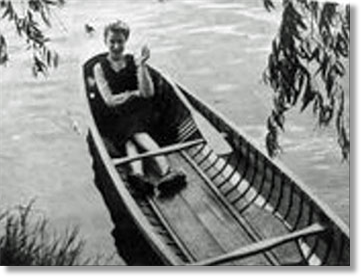
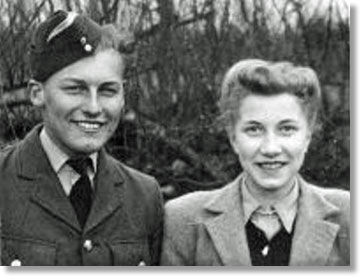
Heaton Park, July 1944, Doug Marshall, NVQ, George Bailey, Blackshire (Blackie), Lucas, George Smith, Threadgold, Ernie Palmer, Pickering, May
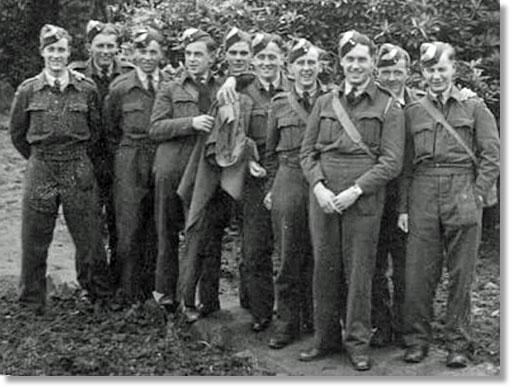
The regular movement of personnel initiated an abundance of gossip and rumour as to when and where groups had gone or were going. Facilities for training PNB pupils existed in South Africa, Rhodesia, the USA and Canada and a group was normally confined to camp a day before leaving and never told its destination until it had embarked upon a vessel.
I did a bit of running, and Ray and I used the swimming baths and joined a water polo team. I was a fairly fast but far from stylish swimmer, but could keep going for what now seems a surprising time. There must have been something like 8 or more teams in the place, of which 2 or 3 were women’s, and quite formidable. Physical Training Instructors arranged the matches so that every team played twice a week; they also did the refereeing. The changing rooms invariably provided some entertainment, since the boarding between the men’s and women’s had large cracks and knot holes. It usually resulted in lots of “cor”s on our side and giggles and laughter on the other, sometimes accompanied by a meeting of eyeball to eyeball.
The first month was a period of settling into a sort of dull routine, broken by the announcement of the D-day landings. After breakfast on the morning of June 6th everyone was called on parade, several hundreds, to hear special addresses by the CO and the padre, accompanied by prayers and it was certainly very impressive at the time.
I did a bit of running, and Ray and I used the swimming baths and joined a water polo team. I was a fairly fast but far from stylish swimmer, but could keep going for what now seems a surprising time. There must have been something like 8 or more teams in the place, of which 2 or 3 were women’s, and quite formidable. Physical Training Instructors arranged the matches so that every team played twice a week; they also did the refereeing. The changing rooms invariably provided some entertainment, since the boarding between the men’s and women’s had large cracks and knot holes. It usually resulted in lots of “cor”s on our side and giggles and laughter on the other, sometimes accompanied by a meeting of eyeball to eyeball.
The first month was a period of settling into a sort of dull routine, broken by the announcement of the D-day landings. After breakfast on the morning of June 6th everyone was called on parade, several hundreds, to hear special addresses by the CO and the padre, accompanied by prayers and it was certainly very impressive at the time.
After the leave I had to report to London for three or four days, living in a small former hotel. Once more there were further medical and aptitude tests. I can only think there was a lot of psychological experimentation at the time to search for qualities that they wanted in navigators and air bombers. There had been a combination of both under the title of Air Observer who served in planes with small crews, but in large aircraft the responsibilities had been split. Whatever the reasoning behind the days of puzzles and questions the evenings were our own to wander around London. I don’t remember any but think it was around the time that the “Doodlebugs” started landing on London. Then it was a train to Heaton park, Manchester.
Heaton Park was an extraordinary place, a massive holding unit for RAF personnel due to be sent overseas. A large park, with municipal buildings, including Heaton Hall, about 2 miles North of the city centre, it was no longer really Civic, but had been largely commandeered, and dozens of Nissen huts constructed. A sort of transit barracks whose occupants had little to do but wait - and wait they did!
It was in the first week of May when I, Ray Parslow and others arrived, were allotted a hut and told where to attend the usual morning parade and roll call. Among our group was a Flight Sergeant who had remustered as a cadet from ground duties. He retained the stripes and crown of his rank but had no real authority; to us he went by the nickname of “Chiefie”. Since the place was a long-term transit camp there were numerous sports facilities, and there was a library, but virtually no lectures or classes in any subjects, and people were often at a loose end. The Park was enclosed with high railings, and during the day a pass was needed to go past the guardroom entrance and into town.
Heaton Park was an extraordinary place, a massive holding unit for RAF personnel due to be sent overseas. A large park, with municipal buildings, including Heaton Hall, about 2 miles North of the city centre, it was no longer really Civic, but had been largely commandeered, and dozens of Nissen huts constructed. A sort of transit barracks whose occupants had little to do but wait - and wait they did!
It was in the first week of May when I, Ray Parslow and others arrived, were allotted a hut and told where to attend the usual morning parade and roll call. Among our group was a Flight Sergeant who had remustered as a cadet from ground duties. He retained the stripes and crown of his rank but had no real authority; to us he went by the nickname of “Chiefie”. Since the place was a long-term transit camp there were numerous sports facilities, and there was a library, but virtually no lectures or classes in any subjects, and people were often at a loose end. The Park was enclosed with high railings, and during the day a pass was needed to go past the guardroom entrance and into town.
In the morning, following breakfast, we gathered for a roll call and instructions. Told, as by now we had guessed, that we were bound for Canada, there were a number of duties to keep us occupied until we got there. Most were mundane and are long forgotten, though one remains. Throughout the vessel, at the bottom and lower decks, there were sets of watertight doors normally open for free passage along corridors. Each would be manned by one of us on a shift basis, with meals and sleep fitted in accordingly.
Around the 21st July we were told that a move was imminent, followed by confinement to the camp and on the 23rd 50 or 60 of us marched to the nearest railway station in the early afternoon, singing popular songs of which one, “When it’s Springtime in the Rockies” stays in my mind, although we had no inkling as to where we were going. I find it difficult to understand why we were allowed to sing. After nightfall the train arrived at Greenock and we were swiftly put on board the “Queen Elizabeth”, given a meal and shown to our quarters, rows of hammocks slung from the ceiling of a vast barren room, two or three decks down. Kitbags were put along the sides. Washrooms and lavatories were adjacent, and meals would be taken on a deck above. A roster of times for meals, and where and when to meet for information and duties was posted up.
Once or twice a week we would meet for an evening in town, and always at weekends as foursomes, sometimes walking in Blackley Clough, a small wooded valley. Once or twice Ray brought his camera. I became quite fond of Jean, and we decided to maintain the association by letters when I went abroad.
Jean Edwards
Ray's temporary girlfriend and Jean
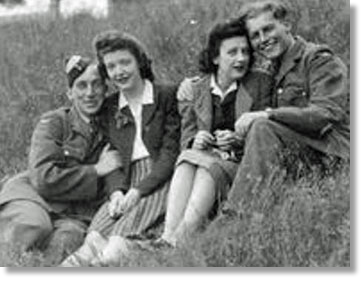
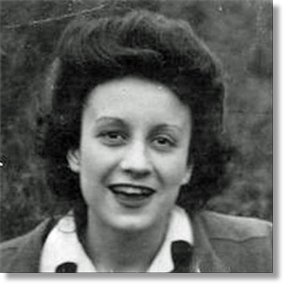
Ray and I had been casting about for some form of personal occupation and eventually produced an idea. One of the large brick halls in the Park was used for meals. It had cream coloured walls, which I thought would be suitable for painting murals. We put this to whoever had authority, with me saying I nurtured ambitions to be an artist after the war (it may have been on my documents), and to our surprise we got permission to go ahead. They were to be landscapes etc., no dancing girls or “pin-up” types! The great thing about the scheme was that there was no difficulty in getting passes to go into the city to buy materials with the limited amount of money we were given. A shopping trip could take a whole morning or afternoon, and we returned with some paints and a brush or two.
Naturally, to extend the project, work proceeded slowly, and only once did anyone visit us with comments and suggestions. Of course nothing could be done at mealtimes when the place was full of people. Over the next month or a bit more I think we completed three panels, each about five feet long and four feet high. One depicted a fully rigged ship under sail, the others mountains, streams, etc. They were certainly not memorable or even particularly good. I doubt if they lasted very long.
Nevertheless, we were very happily occupied, and on occasions escaped the confines of camp. Others devised schemes to similar ends, and there were various “Societies” for music, drama, sports, etc., with constantly shifting members. Manchester was not a greatly impressive city, perhaps because of bombing, since part of the central shopping area was ruined. At night there were cinemas, pubs, and dancehalls, but, combined with the blackout, most were not inviting. Also, pay (was it 4 or 5 shillings [20 or 25p] a day, or less?) restricted activities. Among events in camp was a Saturday night dance, held in a large NAFFI hall. Neither Ray nor I had much ability in dancing though, with the beer, it was a companionable place. Anyway, it was here we met two very pleasant girls and started going out with them in the evenings. I have now forgotten the name of Ray’s non-serious one but not that of Jean Edwards. Both girls were friends and lived in the same suburb of the city, probably Blackley. Jean, slightly built, with black hair, had a faintly Welsh accent derived from her father, and worked as a solicitor’s secretary. Her parents were still in Wales. A delightful person, she lived in a small Victorian terrace house where she shared a flat with another girl.
Naturally, to extend the project, work proceeded slowly, and only once did anyone visit us with comments and suggestions. Of course nothing could be done at mealtimes when the place was full of people. Over the next month or a bit more I think we completed three panels, each about five feet long and four feet high. One depicted a fully rigged ship under sail, the others mountains, streams, etc. They were certainly not memorable or even particularly good. I doubt if they lasted very long.
Nevertheless, we were very happily occupied, and on occasions escaped the confines of camp. Others devised schemes to similar ends, and there were various “Societies” for music, drama, sports, etc., with constantly shifting members. Manchester was not a greatly impressive city, perhaps because of bombing, since part of the central shopping area was ruined. At night there were cinemas, pubs, and dancehalls, but, combined with the blackout, most were not inviting. Also, pay (was it 4 or 5 shillings [20 or 25p] a day, or less?) restricted activities. Among events in camp was a Saturday night dance, held in a large NAFFI hall. Neither Ray nor I had much ability in dancing though, with the beer, it was a companionable place. Anyway, it was here we met two very pleasant girls and started going out with them in the evenings. I have now forgotten the name of Ray’s non-serious one but not that of Jean Edwards. Both girls were friends and lived in the same suburb of the city, probably Blackley. Jean, slightly built, with black hair, had a faintly Welsh accent derived from her father, and worked as a solicitor’s secretary. Her parents were still in Wales. A delightful person, she lived in a small Victorian terrace house where she shared a flat with another girl.
To be continued...
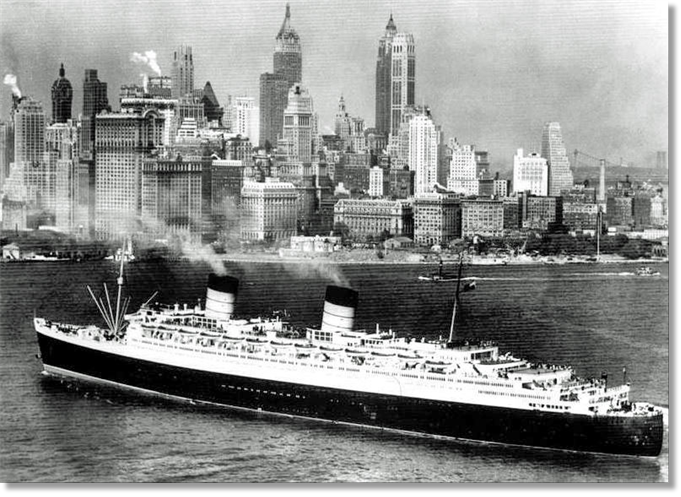
After three days it was evident we were in the Southern Atlantic. The sea was calm with shoals of flying fish, and others, alongside the boat, and there was a considerable rise in temperature. Curiously, since some of us were on deck during much of the day, no other vessel was seen at any time until two days before we arrived, when rumour said we were somewhere off the Florida coast of the USA.
The crossing was confirmed in a glorious manner around six in the morning of the 1st of August. Following shouts of “Come up on deck!” we got there to find a pink sun above a low level morning mist, and rising through it in the distance, the Manhattan skyscrapers. Quite unforgettable. As the liner slowly nosed into the bay, the mist dispersed.
Passing the Statue of Liberty, and assisted by tugs, we gradually progressed up the Hudson River to tie up at, I think, Pier 90, used by all Cunard liners. Somehow, the overpowering size of the adjacent Manhattan buildings did not evoke the beauty of that magical distant view in the mist. I think it was a pity that the POW’s were not brought up to share the experience.
Anyway, downstairs to breakfast, pack personal items, and await further orders.
The crossing was confirmed in a glorious manner around six in the morning of the 1st of August. Following shouts of “Come up on deck!” we got there to find a pink sun above a low level morning mist, and rising through it in the distance, the Manhattan skyscrapers. Quite unforgettable. As the liner slowly nosed into the bay, the mist dispersed.
Passing the Statue of Liberty, and assisted by tugs, we gradually progressed up the Hudson River to tie up at, I think, Pier 90, used by all Cunard liners. Somehow, the overpowering size of the adjacent Manhattan buildings did not evoke the beauty of that magical distant view in the mist. I think it was a pity that the POW’s were not brought up to share the experience.
Anyway, downstairs to breakfast, pack personal items, and await further orders.
Some doors were quite large, and all were equipped with rubber seals, but could be swung and locked without difficulty when an alarm sounded. I suppose one hoped to be on the right non-water side of the door if a torpedo struck. Off duty, there were specific areas of open and enclosed areas of deck where we could walk or sit.
The “Q.E.” left Greenock at night, probably the 25th, and we started our guard shifts. I wasn’t alone in pondering the misfortune of being on the wrong side of the door when the emergency occurred.
There were other RAF units and some military on board and, to our great surprise, about 40 German POW’s. A few may have been captured in France since D-day, others in Italy. Some had clearly had amputations, but all were long term wounded and by sending them across the water with a couple of medics spaces were freed in British hospitals. I suppose they had been given some inkling as to their destination. Kept somewhere in the bowels of the ship, on the second day the weather was a bit stormy but all those who could walk were allowed up to a segregated area of the promenade deck, under a token military guard. Everyone soon knew of their response. Appalled that the ship had no Navy escort, they were convinced that a liner of such size could not avoid being torpedoed, and feared for their lives. Yet every day those capable arrived for an hour or so on deck, assisted by one or more medical staff and accompanied by the solitary guard. Although we could see them the separation zone was wide enough to prevent any physical or vocal contact.
The “Q.E.” left Greenock at night, probably the 25th, and we started our guard shifts. I wasn’t alone in pondering the misfortune of being on the wrong side of the door when the emergency occurred.
There were other RAF units and some military on board and, to our great surprise, about 40 German POW’s. A few may have been captured in France since D-day, others in Italy. Some had clearly had amputations, but all were long term wounded and by sending them across the water with a couple of medics spaces were freed in British hospitals. I suppose they had been given some inkling as to their destination. Kept somewhere in the bowels of the ship, on the second day the weather was a bit stormy but all those who could walk were allowed up to a segregated area of the promenade deck, under a token military guard. Everyone soon knew of their response. Appalled that the ship had no Navy escort, they were convinced that a liner of such size could not avoid being torpedoed, and feared for their lives. Yet every day those capable arrived for an hour or so on deck, assisted by one or more medical staff and accompanied by the solitary guard. Although we could see them the separation zone was wide enough to prevent any physical or vocal contact.

More Relevant Stuff
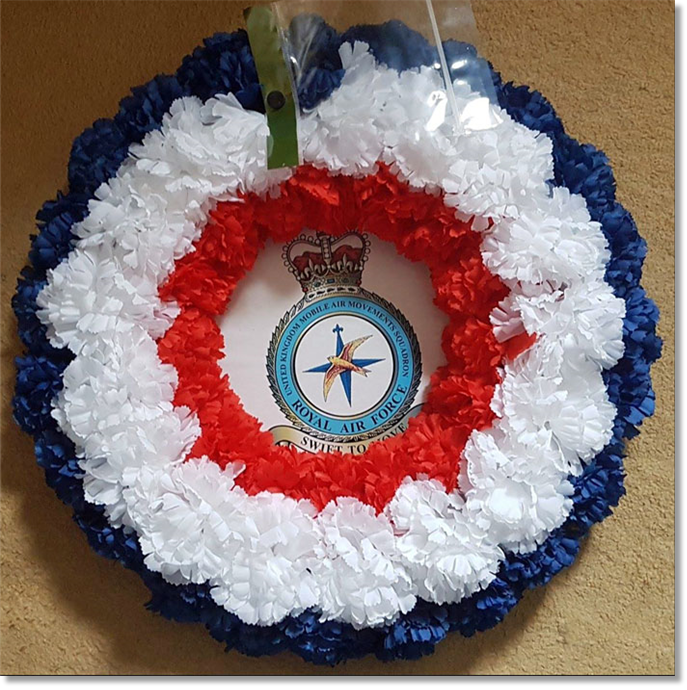
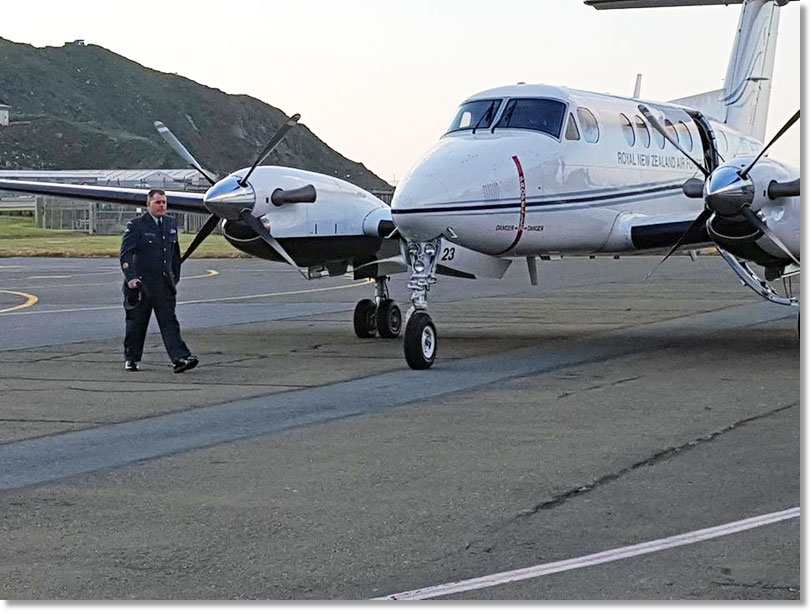
Early morning Wellington plane spotter Brian Lay (RNZAF) checking out the aircraft
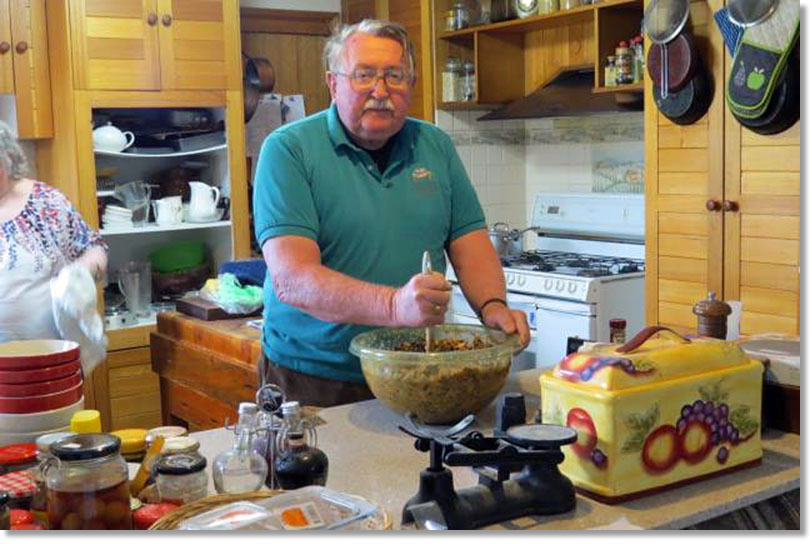
Len Bowen (RAF/RAAF) stirring the Christmas pud - three clockwise - three anti-clockwise
Very cleverly doing it all while being upside down! (He's in Oz)
Very cleverly doing it all while being upside down! (He's in Oz)
Bruce's Page
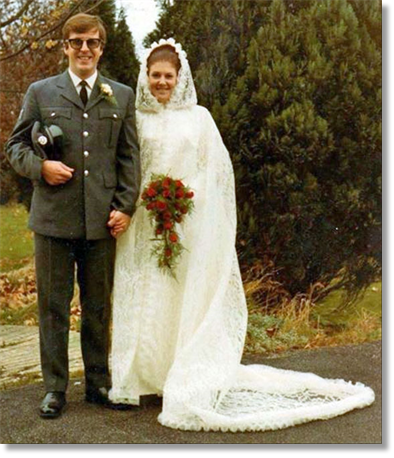
Bruce and Shirley Oram (RAF) -
celebrated their 46th recently
celebrated their 46th recently

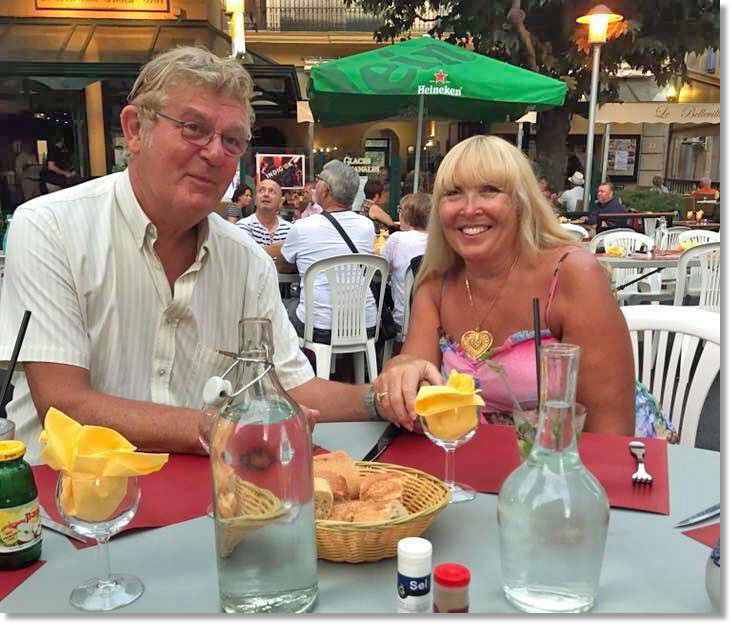
Mike and Sandra McCaan (RAF) down in Lamalou Les Bains, France, where they live for half the year (the other half in Yorkshire). Every Thursday in July and August, they close off the main road and all of the cafes/bars and restaurants have live music, which they say is brilliant!
David Barrett (RAF) enjoying a welcome shower during a recent trip to India
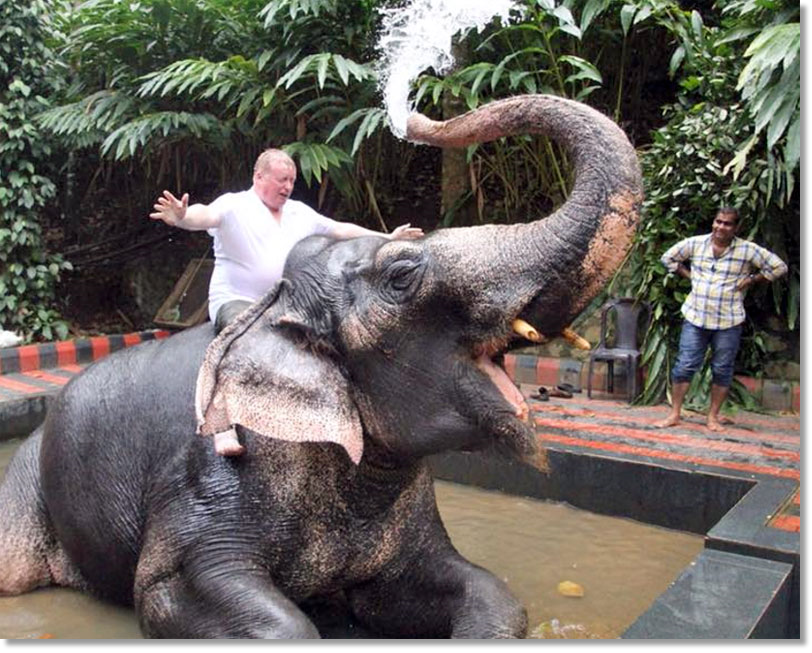
Debs Manners --> UKMAMS OBA
As some of you know, my Dad, Bob Ford, took his place with his fellow Movers in the crew room in the sky this year.
I wanted to share with you my memorial tribute to him and say thank you to those who attended his final farewell and sent messages of condolence. I hope it does him justice.
As some of you know, my Dad, Bob Ford, took his place with his fellow Movers in the crew room in the sky this year.
I wanted to share with you my memorial tribute to him and say thank you to those who attended his final farewell and sent messages of condolence. I hope it does him justice.
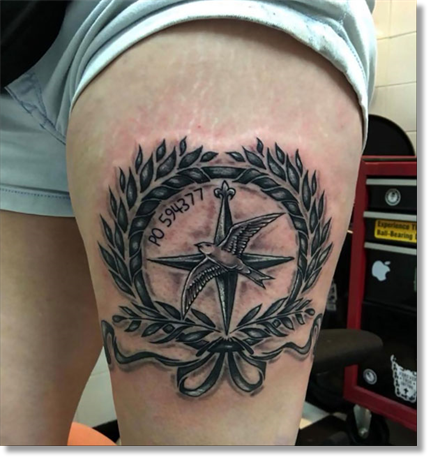
Mike Perks, Manila
Hello,
I really hope you get this fast. I could not inform everyone about my trip to Manila, Philippines for a program because it was impromptu. The program was successful, but my journey has turned sour. I was mugged at gun point and all my valuables (cash, credit cards and phone), were stolen at gun point where I went for sightseeing before leaving to the airport since my return flight is in few hours. Luckily I had my passport in my hotel room to get me home.
It's was a terrible experience.. I am sorry if i got you at the wrong time, i have only very few people to run to now..I need to pay some outstanding bills and also take a cab to the airport. I have contacted my bank, but the best they can do is to mail a new card which will take 5 to 7 days to get here.
Please let me know if you can help me out? I promise to make immediate refund when i get home.
Best Regards
Mike Perks
Hello,
I really hope you get this fast. I could not inform everyone about my trip to Manila, Philippines for a program because it was impromptu. The program was successful, but my journey has turned sour. I was mugged at gun point and all my valuables (cash, credit cards and phone), were stolen at gun point where I went for sightseeing before leaving to the airport since my return flight is in few hours. Luckily I had my passport in my hotel room to get me home.
It's was a terrible experience.. I am sorry if i got you at the wrong time, i have only very few people to run to now..I need to pay some outstanding bills and also take a cab to the airport. I have contacted my bank, but the best they can do is to mail a new card which will take 5 to 7 days to get here.
Please let me know if you can help me out? I promise to make immediate refund when i get home.
Best Regards
Mike Perks

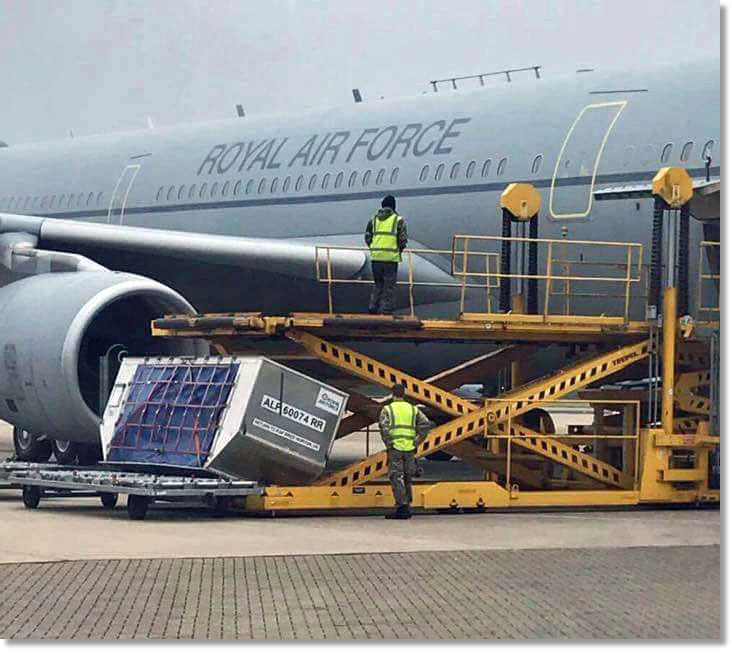
Whoops!
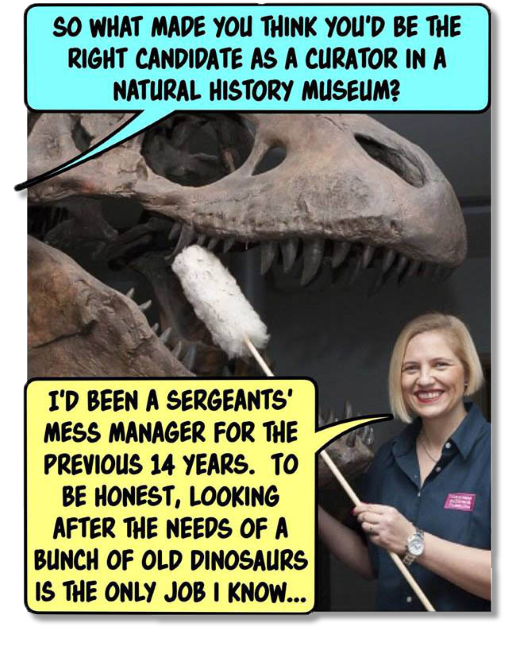
This newsletter is dedicated
to the memories of
David Ely (RAAF)
Willy Verch (RCAF)
Andy Hartley (RAF)
Mike "Fez" Ferry (RAF)
Tony "Spike" Masterman (RAF)
Hilda Armstrong, Wife of Roy Armstrong (RAF)
to the memories of
David Ely (RAAF)
Willy Verch (RCAF)
Andy Hartley (RAF)
Mike "Fez" Ferry (RAF)
Tony "Spike" Masterman (RAF)
Hilda Armstrong, Wife of Roy Armstrong (RAF)
Tony Gale
ukmamsoba@gmail.com
ukmamsoba@gmail.com







